Lead form best practices for capturing high-quality prospects
When I was first setting up my freelance business website, I read tons of articles and social media posts about how to find and attract quality leads. Because none of that advice said much about designing the actual form for capturing those leads, I didn’t […]
Marketing
5 Qualities Effective Sales Leaders Need to Have, According to Experts
Some sales managers hit their targets. Others build teams that consistently outperform, year after year. What makes the difference? To find out, I spoke with top sales leaders, combed through expert interviews, and listened to hours of podcasts on leadership and performance. The best sales […]
SalesI Took a Deep Dive Into AI Sales Agents — Here’s What the Landscape Looks Like Today
Every sales professional has the same experience: The end of the quarter looms, and you’re still waiting for leads to convert into paying customers. As a business owner, I’ve been there too — juggling multiple clients, pitching new writing projects, and managing endless follow-ups. But, […]
Sales


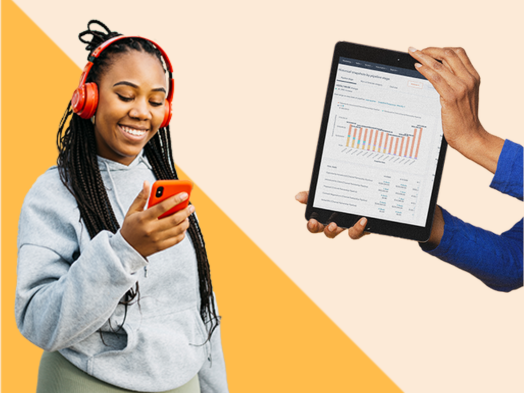

24 Diversity, Equity, and Inclusion Survey Questions to Ask Your Employees
If you want to create a better workplace environment for your employees, it pays to spend time brainstorming DEI survey questions to evaluate your company’s ability to create a welcoming, inclusive workplace. As a former classroom teacher, I saw firsthand the importance of creating an […]
ServiceIf you want to create a better workplace environment for your employees, it pays to spend time brainstorming DEI survey questions to evaluate your company’s ability to create a welcoming, inclusive workplace.
As a former classroom teacher, I saw firsthand the importance of creating an equitable and inclusive classroom for all of my learners. An inclusive classroom meant my students could thrive in an environment tailored to meet their individual needs.
Just like in the classroom, a commitment to creating an inclusive workplace and diverse workforce ensures your employees can better flourish in their roles in a way that works best for them. When your employees are set up for success and are given equal opportunities in the workplace, you’re working to reach your business’s full potential, too.
It’s clear that creating a diverse and inclusive workplace is critical to your brand’s success, but how do you measure the success of your commitments?
 Recently, I chatted with Jim Coughlin, founder of Remotived, to gain his perspectives about DEI, creating a workplace diversity questionnaire, and fostering inclusivity in the workplace. In this post, I’m sharing what I’ve learned from talking with Jim and giving you a list of questions you can use in your own surveys.
Recently, I chatted with Jim Coughlin, founder of Remotived, to gain his perspectives about DEI, creating a workplace diversity questionnaire, and fostering inclusivity in the workplace. In this post, I’m sharing what I’ve learned from talking with Jim and giving you a list of questions you can use in your own surveys.
In this article:
I find it helpful to break down the terms further:
- Diversity means that there is widespread representation of people with different backgrounds (race, age, gender, etc.) within an organization.
- Equity means fair and impartial treatment for everyone. At work, employees have access to the same opportunities and are held to the same standards.
- Inclusion means creating a welcoming environment at work where employees are empowered to participate equally.
The concept of DEI continues to evolve, and many organizations have also started recognizing “belonging” as part of their DEI(B) efforts.
When you think about it, belonging is the outcome of diversity, equity, and inclusion. It’s the feeling of comfort, connection, and acceptance.
The Impact of DEI
While I haven’t managed employees, I have managed a classroom. From my classroom experiences, I’ve found the quality of your DEI initiatives can set the tone for your work environment — whether that’s a classroom or an office.
When I asked Coughlin about the impact DEI initiatives have in his workplace, he told me that creating an environment where collaboration and innovation happen is important — and not just for underrepresented groups.
He said, “We’ve found that without intentional inclusion efforts, employees from underrepresented groups can feel isolated or disconnected from growth opportunities, regardless of workplace model. The amazing thing is that the positive impact on culture is not limited to diverse employees themselves. Everyone at the company reports a higher feeling of psychological safety, engagement, and well-being when companies implement authentic DEI programs.”
For the workplace, DEI can be the difference between retaining and acquiring highly qualified employees or losing them. Research shows that 53% of U.S. employees consider diversity at work an important factor when evaluating companies and job offers.
A Greater Competitive Advantage
DEI also gives you a competitive advantage, too. A 2023 McKinsey & Company study revealed that gender-diverse companies are more likely to outperform their competitors who lack diversity.
I asked Coughlin what he thought about this statistic, and he didn’t seem very surprised. “It’s a pretty simple case to be made that if you‘re hiring the best people from lots of different backgrounds with great ideas and you know you’re going to achieve better results,” he said.
This is likely to do with the fact that more diverse opinions are represented in the decision-making process. When everyone has an equal opportunity to contribute, your team is more likely to find creative, innovative solutions.
Organizations should make an ongoing investment in DEI to attract top talent. This is good for business.
(Pssst! Looking for help to create a presentation on your company culture and its values? Check out the free Company Culture Code template.)
When developing your DEI survey, be sure to keep the general best practices for creating a survey in mind.
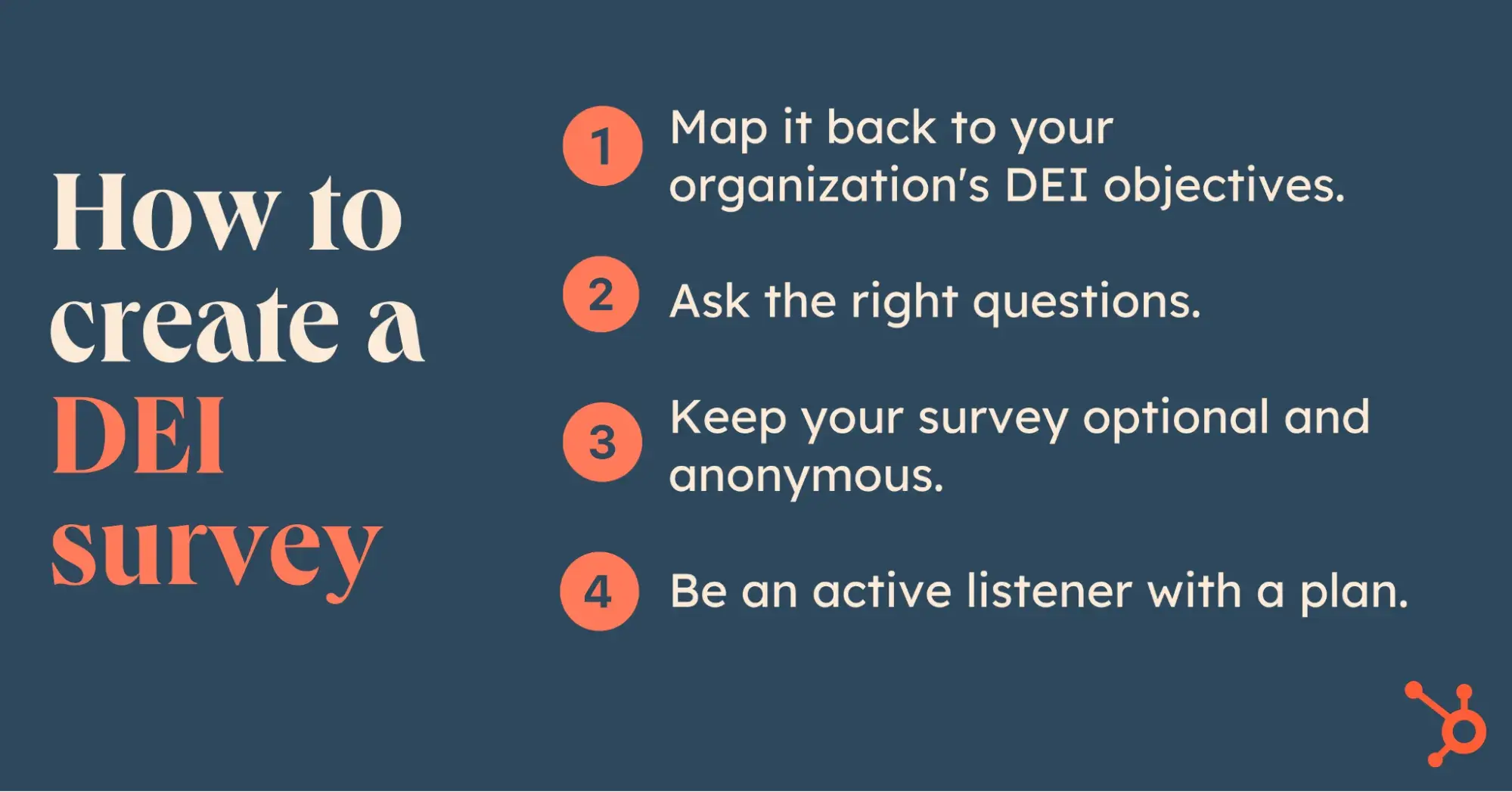
That said, I asked Coughlin if he could share any tips or best practices for creating effective DEI survey questions for a workplace diversity questionnaire. Here’s what he told me.
1. Map it back to your organization’s DEI objectives.
Your survey should be a direct reflection of your overarching DEI goals. And not only that, but Coughlin suggests that you focus less on labels. He said, “We really try to help people approach it from the perspective of assessing the experience rather than labeling.”
For example, one of your goals may be to increase inclusivity and equity for neurodiverse people. However, if you simply ask, “Are you neurodivergent?” you just get a count of your neurodivergent employees, which isn’t a true indicator of inclusivity and equity.
Make sure there‘s a clear way to use your survey results to measure progress against what you’re trying to achieve.
2. Ask the right questions.
Coughlin told me it’s best to consider the design of your questions. He said, “We recommend focusing questions on three key areas: belonging, access, and voice. Do employees feel valued for who they are? Do all employees have equal opportunities for growth? And are diverse perspectives actively sought out and incorporated?”
Pay close attention to the wording and format of your questions. Also, consider how your audience may perceive them.
For example, asking employees, “Is our company diverse?” as a yes or no question forces participants into an answer. Plus, it doesn’t really give them a chance to voice their opinions.
You could rework your questions to include a rating scale (e.g., On a scale of 1-5, how would you rate diversity at our company?) and follow up with an open-ended question that asks why that rating was selected.
3. Keep your survey optional and anonymous.
I cannot stress enough how important it is to keep your surveys optional and anonymous. From personal experience, I’ve found that when people feel unsafe to share their thoughts, they won’t.
The same goes for your employees. They are more likely to share their honest thoughts and opinions if they feel they can do so without repercussions. Coughlin said keeping your survey anonymous is critical, but it might require finding a new tool to ensure privacy.
He told me, “It’s really important to take steps to make these surveys anonymous. Most survey tools don’t do this and it makes employees nervous to answer honestly. Leaders should be very transparent about how these answers are displayed and that no one in the organization will be able to reverse engineer who is who.”
He even mentioned that some surveys allow the administrators to watch employees answer questions in real-time. This defeats the purpose of anonymous surveys and can lead to serious repercussions.
Remember, your survey shouldn‘t focus on who is saying what, and people shouldn’t feel forced to take it. You’ll get more genuine responses if people feel like they can answer honestly while keeping their identity private.
4. Be an active listener with a plan.
At the end of our chat, I asked Coughlin if he had any more tips to share about DEI surveys. He made a point to tell me that workplace surveys are great, but you can’t just file the results in a folder and leave them there. There’s meaningful work to do once the results are in, especially if you want your employees to feel valued and heard.
He said, “It goes beyond listening and measuring. It’s actually going to be acted on. Because companies sometimes feel like listening just means listening. But that doesn‘t make people feel heard. You have to make a commitment to do something useful with that information. And when you’re giving something a value like that, then you’ll get that valuable data from people. People will be honest. They will feel compelled to take the survey rather than ignore it.”
Diversity, Equity, and Inclusion Survey Questions
I think it’s important to point out that workplace diversity questionnaires are different from employee satisfaction surveys. While employee satisfaction surveys are helpful to understanding how your employees feel about their work, they don’t always indicate the inclusivity of your workplace — which is why you need DEI survey questions in your questionnaire.
I’ve compiled a list of 24 diversity, equity, inclusion, and belonging survey questions for employees. Feel free to use these or tweak them for your organization.
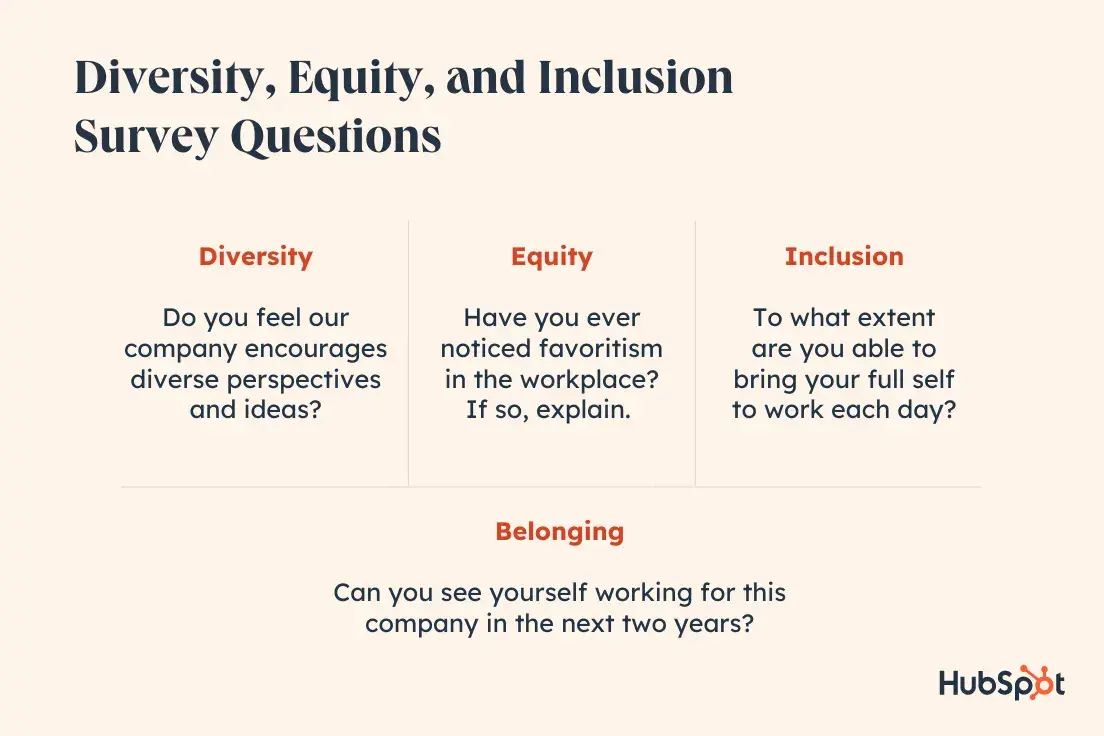
You can review the questions in order below or jump around:
- Diversity Survey Questions
- Equity Survey Questions
- Inclusion Survey Questions
- Belonging Survey Questions
Diversity Survey Questions
1. On a scale of 1-5, how would you rate diversity at our company?
Why I think this works: This is a great starter question that allows participants to quantify how successful your diversity efforts are as a whole.
2. Do you feel our company encourages diverse perspectives and ideas?
Why I think this works: If the answer is no, this tells you exactly where you need to focus your efforts (e.g., creating a forum for new ideas, additional DEI training for team leads, etc.).
3. To what extent do you feel you can relate to members of the executive team?
Why I think this works: This helps you understand if your employees can see themselves as part of leadership one day. Huge implications for retention and growth.
4. Rate on a scale of strongly agree to strongly disagree: Our organization hires people from all backgrounds.
Why I think this works: Even if your organization is setting diversity hiring goals, you’ll be able to see whether or not your employees actually see this reflected within their teams.
5. How comfortable are you discussing your social or cultural beliefs in the workplace?
Why I think this works: A big part of diversity is authenticity. If people aren’t comfortable talking about their backgrounds, this is an indicator that something needs to change.
6. What steps can we take to create a more diverse culture at our company?
Why I think this works: This question is actionable and gives participants the opportunity to tell you what they really want to see out of your DEI work.
Equity Survey Questions
1. Do you feel you have the same opportunities for advancement as your colleagues?
Why I think this works: Equity means that growth opportunities are available for everyone. This question tells you how employees feel compared to their peers in this area.
2. Rate on a scale of strongly agree to strongly disagree: Our company treats all employees fairly.
Why I think this works: Fair and just treatment is another key element of workplace equity. If employees disagree with this question, this is an easy red flag.
3. Have you ever noticed favoritism in the workplace? If so, please explain.
Why I think this works: Favoritism is the antithesis of equity. If this is happening at your company, this will allow you to capture real examples for further investigation.
4. Rank these equity initiatives based on how important they are to you.
Why I think this works: Employee rankings will give you direct feedback on your equity processes and program, and help you prioritize your efforts.
5. Does your supervisor show a commitment to workplace equity?
Why I think this works: The supervisor/direct report relationship is crucial. This can help you determine whether your people managers need additional equity training or support.
6. What else can we do to promote equity across the company?
Why I think this work: This is another actionable question that gives employees space to make suggestions based on their experiences with equity at work.
Inclusion Survey Questions
1. To what extent are you able to bring your full self to work each day?
Why I think this works: Inclusion means being comfortable showing your authentic self at work. If the responses indicate that this isn‘t the case, it’s clear you have some work to do.
2. Have you ever felt left out or excluded from certain activities in the workplace?
Why I think this works: If people feel excluded, they’re less likely to engage. The results of this question can help you proactively re-engage employees before they churn.
3. Rate on a scale of strongly agree to strongly disagree: I feel included in the decisions that impact the business.
Why I think this works: Feeling like you bring value to the business at large is another form of inclusion. This question tells you if employees feel like their day-to-day work matters.
4. How comfortable are you with voicing your opinions and concerns at work?
Why I think this works: This will help you gauge how confident employees are about sharing feedback and identifying problems in the workplace.
5. On a scale of 1-5, how strongly do you think our company values inclusivity?
Why I think this works: If your company values inclusivity, it‘s important to practice what you preach. This will let you know if your employees think you’re doing a good job.
6. Would you recommend this company as an inclusive place to work?
Why I think this works: If your employees answer yes to this question, this speaks volumes. Why? Because they would be willing to encourage their peers to join your work environment.
Belonging Survey Questions
1. To what extent do your personal values align with the values of our organization?
Why I think this works: If employees don‘t feel like your values align, this could be an indicator that your DEI efforts aren’t creating the outcome you anticipated.
2. Do you feel a sense of ownership over your work?
Why I think this works: If employees feel like they own the work they do, they’ll be more empowered to make decisions and bring creative ideas to the table.
3. Rate on a scale of strongly agree to strongly disagree: I can depend on my coworkers.
Why I think this works: A good sense of belonging gives employees the confidence to build relationships. And dependability means they’re comfortable confiding in their peers.
4. Do you feel like you belong at this company?
Why I think this works: This question is straightforward and to the point. It essentially tells you whether your employees feel like they should be working for you.
5. Rate on a scale of strongly agree to strongly disagree: Our company’s mission inspires me to do my best work.
Why I think this works: Similar to value alignment, this question gives you insight into how connected employees feel to what you’re trying to accomplish as an organization.
6. Can you see yourself working for this company in the next two years?
Why I think this works: A good indicator of belonging is that your employees want to stick around long term. If most participants say yes, that’s a win.
Get the Most Out of Your Next DEI Survey
From my conversation with Jim Coughlin, it’s clear DEI initiatives are critical for the success of any business, and the need for these initiatives will only continue to grow. Your employees invest their time and energy in making your business a success. So, you should go out of your way to create an environment where they feel safe, seen, and heard.
How? It’s easier said than done, but asking them for feedback is the perfect place to start. Take some time to think through your DEI survey questions to ensure you gain perspectives and not just a blanket, surface-level response.
Editor’s note: This post was originally published in April 2023 and has been updated for comprehensiveness.
![]()
How to Create a Cross-Channel Marketing Campaign [+Benefits & Examples]
Creating a successful cross-channel marketing campaign requires great effort. If I had it my way, I would always know how and when to reach our customers. I could have a single channel for interacting with them, converting them, and continuing to delight them. All of […]
ServiceCreating a successful cross-channel marketing campaign requires great effort. If I had it my way, I would always know how and when to reach our customers. I could have a single channel for interacting with them, converting them, and continuing to delight them. All of my marketing, sales, and service efforts could be easily tracked and enhanced as we created the ideal customer experience within this single channel.
Sounds perfect, right? Unfortunately, ideal situations seldom apply to businesses. As anyone who has ever tried to meet a quota of leads or customers can attest, if you only market in a single channel, you’re going to miss out on a large portion of your target audience. In fact, focusing on a single channel can even make for a poor customer experience and prevent you from successfully nurturing your leads.
Recently, I spoke with Nathaniel Miller, head of marketing at HarvestIQ, and Ruslan Halilov, chief marketing officer at BlueDotHQ, to learn more about how to nail cross-channel marketing effectively. Below, I’ll share their insights.
Table of Contents
I asked Ruslan Halilov and Nathaniel Miller to give me a quick definition of cross-channel marketing. Halilov told me, “Cross-channel marketing simply means incorporating multiple channels into your marketing strategy.”
Multiple channels means incorporating your social media accounts, websites, and email campaigns to reach customers where they are and offer them different but relevant experiences through the customer journey.
Miller suggested that cross-channel marketing only works well if you create a smooth experience across your entire brand. He said, “Whether it’s seeing an ad on Facebook, opening an email, or landing on your website, everything should feel connected. The idea is to keep your message consistent and relevant as people jump from one platform to another.”
If you’re in marketing or sales, you might be thinking, “What is the difference between cross-channel and omnichannel marketing? Isn’t that the same thing?”
Although these two tactics are closely related, they’re different. I asked Miller and Halilov to help me understand the differences between these strategies.
The Difference Between Cross-Channel & Omnichannel Marketing
It’s important not to confuse cross-channel marketing with omnichannel marketing. Both strategies depend on:
- Multiple marketing channels.
- Monitoring metrics.
- Customer interactions.
However, according to Miller, there is one key difference.
He told me, “Cross-channel is about getting all your platforms to play nice together — like linking your email campaign with social ads so your audience gets a cohesive experience. Omnichannel takes it up a notch by putting the customer at the very center. It’s less about channels and more about creating one ongoing, unified experience that feels totally personalized.”
I know it might sound like bringing all of your channels together is a challenge. Cross-channel marketing is somewhat simpler than omnichannel marketing.
With cross-channel marketing, you’re bringing each of your platforms into unison with each other so that they build off each other and amplify their impact. You’re creating content around the same message, but in a way that fits the platform. This might mean tweaking your copy for social media, creating video content, or sending emails.
For example, if a prospect reads one of your blog posts looking for a solution to their pain points, they might receive a related email later mentioning the same topic. Then, when they scroll through social media, they might see an ad with a catchy headline about how your product solves the problem.
Each platform functions differently, and your content supports those roles.
Why use cross-channel marketing?
Regardless of your industry, understanding your target persona is key to an effective marketing strategy. I have found that you can‘t market effectively if you don’t have a thorough understanding of who you’re marketing to. Otherwise, it’s like blowing on a dandelion — you’re just scattering marketing efforts into the wind and hoping that something lands correctly.
So, instead of scattering your efforts in various directions, take my advice: You need to understand your target persona and how they interact with brands and make buying decisions. This means plugging into the channels where your customers get the information to make these decisions and looking hard into how they want to receive information.
There are a ton of benefits to doing this, too.
Cross-Channel Marketing Benefits
When I asked Nathaniel about the benefits of cross-channel marketing, he told me, “Cross-channel marketing keeps your message consistent across platforms, creating a seamless experience for your audience. It means better engagement, higher conversions, and a more cohesive brand presence.”
Let’s take a closer look at the benefits of deploying a cross-channel business marketing strategy.
1. Increased Engagement
With the sheer volume of ads consumers see in a day, many have gone (me included) what I like to call “ad-blind.” In other words, your customers scroll past your PPC ads, boosted posts, and marketing emails without giving them a thought.
However, if I’ve been working on figuring out a complex issue for my team and have already come across a brand that I view as an authority on that issue, receiving a marketing email or seeing an ad about that topic is more likely to catch my attention and not get deleted in my daily inbox cleaning efforts.
Consumers respond positively to personalized content. For example, calls to action that contain customized content perform 202% better than generic CTAs.
2. Proven ROI
As Miller told me, cross-channel marketing leads to higher conversions. Combining your efforts with a cross-channel marketing approach can:
- Break down silos that decontextualize metrics.
- Clarify the touch points to see how a viewer became a lead and customer.
- Help you refine your marketing approach.
For example, if you consider your marketing efforts from a single-channel or multi-channel approach, your email marketing team may be focused on getting opens or CTA impressions. Meanwhile, your social media team may be focused on getting impressions or likes. Finally, your content team may be looking at blog views.
To me, separating these channels to an individual level is somewhat chaotic and can lead to false numbers. So, not only does cross-channel marketing create a clearer roadmap for refining your marketing efforts, but it also helps to avoid falling into the traps of vanity metrics.
3. Greater Brand Presence
Creating a marketing campaign across your available channels will increase your brand presence. By doing this, your leads will be saying, “I’ve seen that brand everywhere!”
The more you promote your brand, the more potential leads will see it. It reminds me of the saying, “Curiosity killed the cat.” With appropriate and consistent messaging across all platforms, your leads will be curious enough to check out your brand, especially if you promise to solve their problems.
4. Greater Customer Loyalty
Solving your customers’ problems leads to an improved brand experience for consumers, which increases a buyer’s sense of delight.
I’m pretty sure this is Marketing 101, but, a delighted customer is a loyal customer, and combining loyalty with delight is the recipe for creating your most powerful marketing tool: a brand ambassador.
Consumers generally want a reason to keep coming back. It’s easier to know that you have a go-to resource for a given issue or need than to go back to the drawing board and research, compare, and test solutions.
For many buyers, it‘s simply more convenient to upgrade or purchase additional services from a provider they already know and trust — even if it’s slightly more costly — than to find someone brand new who can do the same thing. When a customer trusts you and genuinely wants to help them succeed and your unified marketing and customer service efforts demonstrate that, you remain front of mind as an authority.
Why Cross-Channel Marketing Can Be Challenging
Although Halilov mentioned that cross-channel marketing is slightly easier to implement than omnichannel marketing, it’s still not without its challenges. I asked both him and Miller to guide me through some of its pitfalls so I could learn (and share!) how to avoid them.
Here’s what they told me.
1. Staying consistent is challenging.
Halilov mentioned to me that the biggest challenge he finds with cross-channel communication is staying consistent. He said, “In my opinion, the key challenge here is to keep your messaging consistent on every platform while also balancing that with customizing your campaign for every platform.”
Think about it: You need to align multiple channels and ensure each content on your various platforms is relevant. As I’ve learned, the more cohesive your strategy is, the better it will be.
Is this impossible? No. But is it challenging? It can be.
2. Messaging can become repetitive.
Consistency is key to cross-channel campaigns. However, sometimes, remaining consistent can become boring. Miller warned me about this. He said, “One of the biggest challenges is keeping your messaging unified without being boring or repetitive.”
This means you’ll need to work with a copywriter and your marketing team to create relevant but different copy for your marketing campaigns. So, while it can be challenging, there’s also a viable solution.
3. Tracking metrics can be difficult.
After learning about the various channels that must be combined for cross-channel marketing to work, I wasn’t surprised to learn that both Nathanial and Ruslan thought tracking metrics could be a bit of a challenge. Ruslan told me, “Another challenge is tracking the performance of your campaigns. It’s simple: the more channels you use, the more data you get, and the more effort it takes to analyze it.”
However, Ruslan did mention several analytical tools you can use. With the right tools, tracking your metrics is less of a problem.
Cross-Channel Marketing Examples
Let’s take a look at a couple of cross-channel marketing examples to get a better idea of how they work. It’s important to understand that cross-channel marketing isn’t just about sales. Instead, it’s about creating a more unified customer experience.
The first example of a cross-channel campaign comes straight from my Facebook notifications.
1. VistaPrint
I’ve been thinking quite a bit about printing new marketing materials for my business recently. With Facebook’s recent addition of ads in users’ notifications, I saw an ad that said, “Get seen with bold signs.” This ad caught my eye because VistaPrint is a company I have used to print mailers and other marketing materials.

VistaPrint doesn’t just use Facebook to target their customers, though. If I had just seen their ad in my notifications, I likely would have skipped right over it. Instead, they also run YouTube ads and television commercials. Check out this commercial, for example:
Notice that the intent of the commercial is similar to the Facebook notification. The commercial’s intent is to prove that you can get seen by your customers when you use VistaPrint for your printing. The Facebook notification says the same thing, just with less copy.
Instead of focusing on making a sale, the ad and the YouTube commercial speak directly to my pain points and provide a solution: get more business with marketing materials that stand out. The more I see VistaPrint in my notifications, newsfeeds, and television, the more I’m reminded that I need to order new business cards and signs.
2. Shopify
Shopify cross-channel communications is another great example of this marketing strategy at work. They are pros at using various marketing channels — channels I wouldn’t think of right off the bat. Here’s an example of a Shopify Facebook ad that is straight from their ad library.
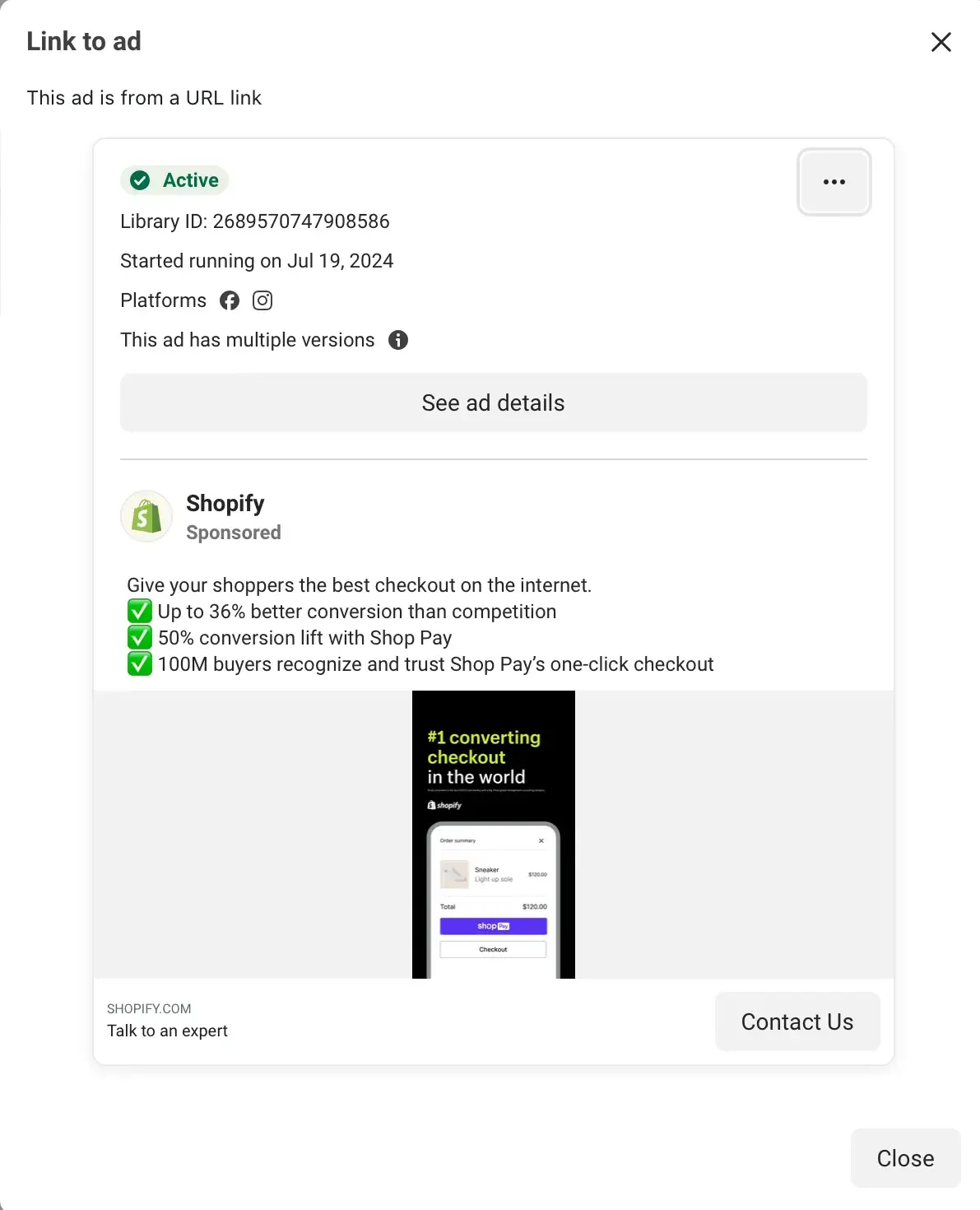
Looking at the details of this ad, I can see they’re running it across the Meta platform, both on Facebook and Instagram. So, based on their target audience, they might see the Shopify ad in their Facebook feeds and then again on Instagram as they scroll through the app. Choosing to run this ad on both platforms ensures Shopify catches all of its audience members multiple times.
Shopify doesn’t stop there with its marketing. Instead, they’ve found a creative place to put their ads. Nearly all of the podcasts I listen to feature a Shopify ad. Typically, the Shopify ad is in the middle of the show, meaning that users will hear it because they’re invested in the content. Shopify also partners with content creators and gets them to read their ads. This helps create trust with the listeners.
If I sold physical products on my website or in a storefront, I would consider using Shopify — just because I hear about it so much.
3. Canva
Canva also uses cross-channel marketing to bring in new leads. As a former teacher, I used Canva quite often to create presentations. However, when I left the classroom, the way I used Canva changed.
Here’s how they draw me as a customer with their emails now:
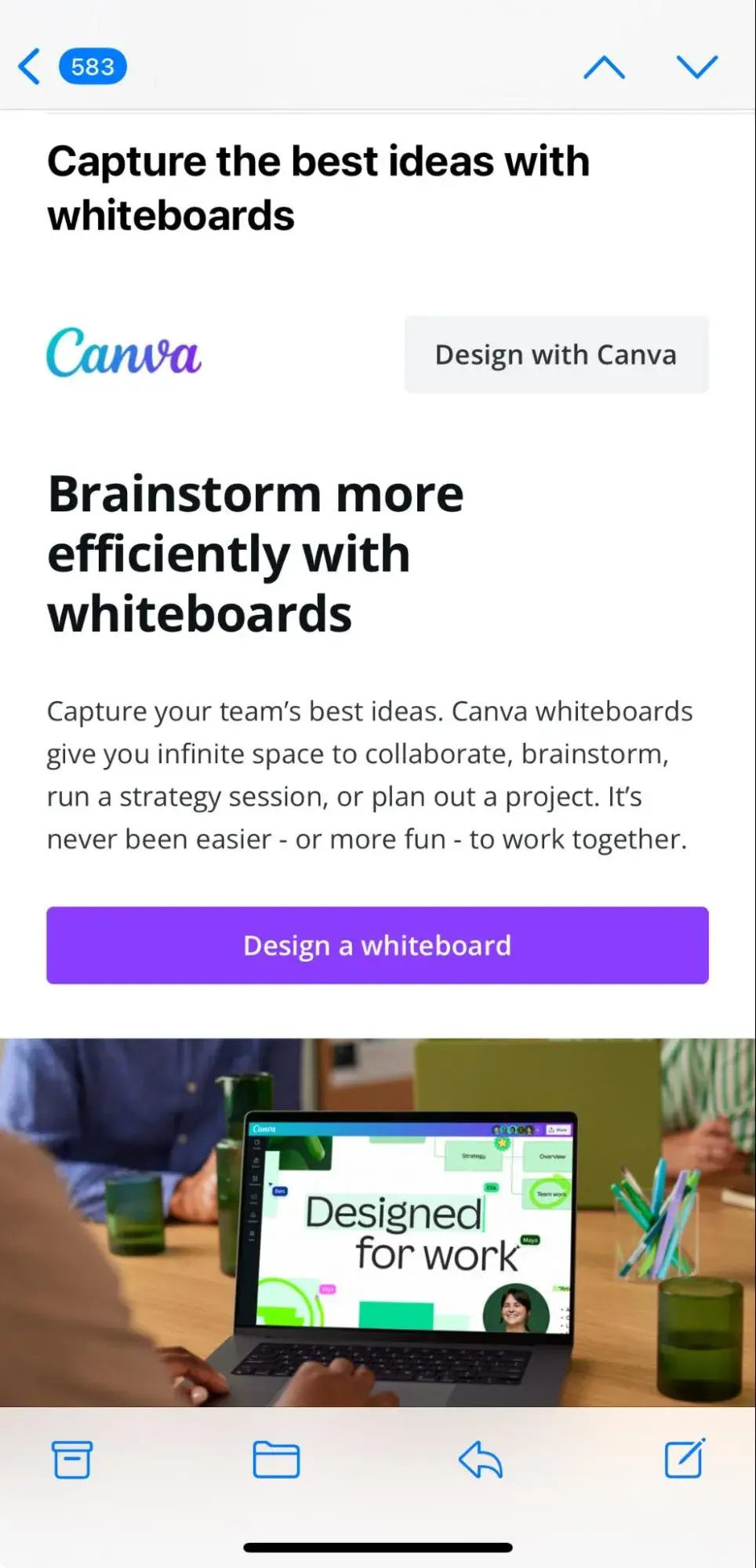
Instead of using teacher language, they use business lingo (strategy sessions, anyone?). Using the right wording in your ads and emails can capture the right audience that you want to focus on. For example, if this email mentioned something like, “Use this whiteboard to teach a virtual lesson,” I would have ignored it. I’m no longer in the classroom so that no longer appeals to me.
Imagine seeing this email in your inbox, and then you see this YouTube ad before a video:
Chances are you’ll remember Canva’s functionality and be interested enough to check it out the next time you need to create something for your job.
How to Get Started with Cross-Channel Marketing
When starting with cross-channel marketing, it‘s important to remember that you’ll likely need to tweak your approach and make ongoing optimizations as you get better at it. The more data you collect, the better you‘ll understand your customers’ cross-channel buying experience, giving you insights into improvements you can make across each channel.
Here’s how to launch a cross-channel marketing campaign of your own:
1. Create your customer persona.
If you haven’t clearly defined your customer persona, do so before diving into cross-channel marketing. Defining your customer persona is the first step and the backbone of any successful cross-channel strategy. This helps you have unified data within a customer data platform (CDP).
Your business’s customer relationship management (CRM) platform will often be able to manage this data, so you can likely get started by building on your existing tools. For example, if you use HubSpot’s customer platform, you can create customer persona markers, which will help you organize your data better.
2. Set up your analytical tools across your CDP.
Speaking of CRMs and CDPs, Miller made a point about how important it is to integrate your tech. He suggested, “Use tools like HubSpot to manage campaigns across channels and connect your CRM for better tracking so nothing falls through the cracks.”
Regardless of the specific CDP you choose, you‘ll want to ensure you have the analytics data available to capture each of your leads’ touchpoints. Remember, Halilov told me that tracking data can be a challenge, but there are analytics tools to help.
Typically, this will involve tracking URLs or browser cookies to associate online actions with an individual lead‘s contact profile. You’ll want to be able to see which emails they‘ve been sent and have interacted with, which social media campaigns have made an impression on them, the blog posts that they’ve read, PPC campaigns they’ve clicked on, and conversations that your sales or service team have had with that customer. Whatever channels you have used for marketing — or will use — need to be reflected within your CDP.
3. Clarify your customer segments.
What I find neat about leads and customers is that while they’re similar, they’re not all the same. You can segment customers together based on their interactions with your brand. Based on the collected data, you can determine which customer belongs to which segment.
Ideally, your CDP will be able to create meaningful reports across customers that help you visualize and understand this data. But, even if you have to do some number-crunching by hand, your third step to getting started with cross-channel marketing is to understand the varying segments within your customer persona.
It’s easy to think your customer persona encompasses a single customer profile. However, the longer I’ve been in marketing, the more I realize that customers’ interactions with your brand can vary from one lead to the next. These interactions can distinguish between a successful cross-channel campaign and a failure.
4. Analyze your customer data to uncover trends.
Once you’ve collected enough data, you’ll need to analyze it to identify trends and patterns. Miller told me this can “help you understand different paths your customers take and make sure each touchpoint feels seamless.”
For example, you’ll likely notice that most of your leads who have already converted into customers have something in common. Those commonalities could be the minimum number of interactions before converting, the average time spent interacting with your marketing efforts before converting, or even specific campaigns with high conversion rates.
By analyzing your customer data and creating a clear mental picture of the segments within your contact database, you can determine which channels to prioritize and the type of content that performs best for your business across each channel.
Pro tip: I find it important to document and contextualize each interaction so that you can successfully cater your content to your customers.
5. Use smart content to unify your interactions.
If your CDP is integrated with your content management system (CMS), I have good news! This step will likely be easier than if they‘re operating independently of each other. Even if they aren’t integrated, you can still be successful with cross-channel marketing; it may just require more hands-on work to personalize your content.
With your customers analyzed and segmented based on their interactions, your next step is to begin the process of customizing your content so that it matches each viewer’s needs.
The most direct way of accomplishing this is to utilize smart content. Smart content is dynamic content determined by a certain set of criteria. To put it simply, smart content says, “If a viewer has done this, show them that.” This is why it‘s necessary to have all of your customer interaction data unified within your CDP. You’ll be able to identify who has done what clearly, so your subsequent interactions will be built upon established touchpoints.
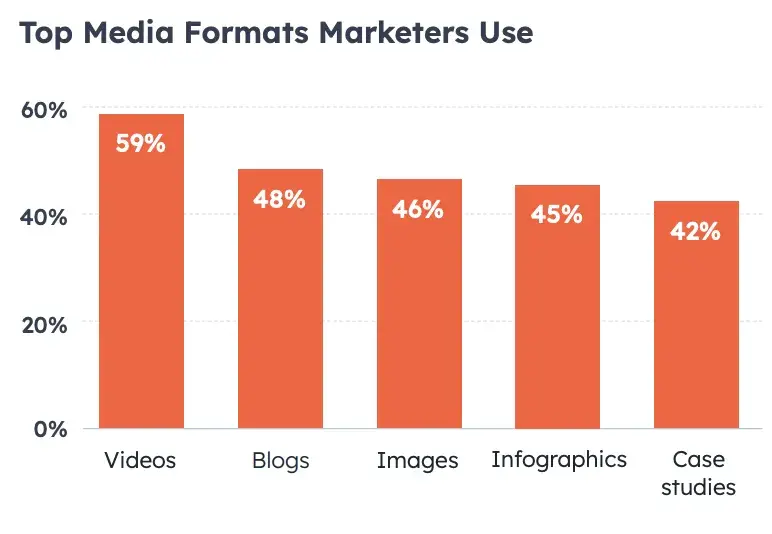
If your CMS is able to utilize smart content, create content — or at least sections of content — based upon the segmented lists you’ve broken your contacts into.
I find giving an example helpful to explain how smart content works. Let‘s say you’re publishing a blog post about one of your core services. You can customize this blog post for various segments. It might look like this:
- Based on past interactions, the warmest leads will see a CTA to contact sales to get started.
- If another customer has already viewed your pricing page, this CTA may show an offer for them to claim 10% off.
- For contacts who haven’t had many interactions or for whom this is their first interaction, this section may be replaced with recommended content about the same topic.
Regardless of where these readers are in the buyer‘s journey, you’re showing them the most relevant content to their situation. If your CMS isn‘t integrated with your CDP or CRM, you’ll want to leverage other means of communication to tailor your content to your viewers’ individual needs manually.
For example, if you’ve identified three distinct variations of one of your personas, put that information to good use. I suggest creating three variations of your next newsletter so that each segment gets the most relevant content. Additionally, you can use this knowledge to create custom audiences for targeted advertising on social media.
6. Optimize and repeat.
In my opinion, one of the biggest advantages of cross-channel marketing is that you can report on and analyze the ways in which your marketing strategies in one channel affect another. Simply having this data gives you valuable insights into your ROI.
However, if you want your cross-channel marketing to be even more productive, you can also analyze this information to find ways to optimize your approach continuously.
Use this data to your advantage and run experiments like:
- A/B testing in your emails.
- Adjusting the traits of your target audience for Facebook ads.
- Tweaking placement of your calls-to-action to continue unearthing new and valuable insights into your customers.
As you prepare to implement additional cross-channel marketing campaigns, you can enrich each step with the data you’ve already gathered.
7. Maintain consistency.
Halilov advised me that a cross-channel marketing strategy only works if you maintain consistency across your platforms. This doesn’t mean creating one post and blasting it across your channels. Instead, I find cross-channel marketing works better when you tailor your content to each channel.
Nathaniel agreed that this is the way to go, too. He told me, “Your brand voice should be recognizable everywhere, but don’t forget to adjust the content to match the vibe of each platform.”
It’s also important to tap into the type and format your customers consume most. For the fourth year in a row, our Marketing Trends Report found that videos, especially short-form videos, are the most popular with marketers and audiences — 30% of marketers who do not currently use video in their strategy plan to start in 2025.
But keep in mind that creating videos for TikTok and cross-posting doesn’t always work. An example of this is the emergence of Threads. According to a Buffer experiment, cross-posting on Threads doesn’t work as well as on other platforms. This is because Threads is very niche-specific and has its vibe, which brings me to another nugget of advice from Halilov. He told me, “Research all the platforms you use to understand what works best for them.”
It may take some trial and error to nail down the copy for each of your channels, but trust me, it’s worth it. You can maintain consistency across your channels by creating cohesive content focused on each channel’s vibe.
How Will You Grow with Cross-Channel Marketing?
By leveraging cross-channel marketing, your team will be able to execute powerful marketing strategies, and by unifying your data within a customer data platform, you‘ll also have more meaningful insights into your customer’s behavior. That knowledge means that you‘ll have greater opportunities to cater your sales, marketing, and customer service interactions to each and every one of your contacts. When you can access that information, you’re on track to delight your customers at every turn. From there, you can grow wherever you want to.
Editor’s note: This article was originally published in December 2018 and has since been updated for comprehensiveness.
![]()
Why You Need An AI Customer Data Platform (+ Top Picks)
Customer data: can’t understand it, can’t afford NOT to understand it. That’s how I used to feel about data, and I thought throwing AI into the mix would make the confusion even worse. I’m happy to report just how wrong I was. Artificial intelligence (AI) […]
ServiceCustomer data: can’t understand it, can’t afford NOT to understand it. That’s how I used to feel about data, and I thought throwing AI into the mix would make the confusion even worse. I’m happy to report just how wrong I was.
Artificial intelligence (AI) makes collecting, interpreting, and acting on customer data far easier than traditional data tools. There are also countless products on the market to help make this process as effective and fast as possible.![Download Now: How to Use AI for Data Analysis [Free Guide]](https://no-cache.hubspot.com/cta/default/53/34eef95d-5e05-4093-801d-4da4349554a5.png)
Customer data platforms have been a resource for companies of all sizes for a long time, and AI has added a level of operational ease that will assist even the most numbers-adverse individual (raises hand) in confidently making data-backed decisions. Let’s look at what unique opportunities AI brings to the customer data conversation, and which platforms are the most popular (and why).
Table of Contents
- What Is an AI Customer Data Platform?
- How Does an AI Customer Data Platform Work?
- Benefits of an AI Customer Data Platform
- Pitfalls to Avoid
- Examples of Some AI CDPs I Recommend
- Detangling Your Data
What Is an AI Customer Data Platform?
An AI customer data platform (CDP) is software that gathers, organizes, unifies, and interprets customer data using artificial intelligence. It offers an unparalleled understanding of your customers’ first-party data, aiding in decision-making in every department.
Data collection must be done ethically to remain lawful and have adequate privacy compliance, and the data infrastructure must be secure to avoid breaches and outages.
How Does an AI Customer Data Platform Work?
The first step in using an AI CDP is setting it up to collect data. Your chosen platform will automatically sync with your website, email, CRM, etc., to unify diverse data sources into a single source of truth.
Then, a variety of AI functions, such as natural language processing (NLP), machine learning, and predictive analytics, will process your data.
Once your data is processed, you’re provided with actionable recommendations that advance your sales, marketing, and advertising efforts.
Benefits of an AI Customer Data Platform
While you can choose a CDP that doesn’t have an AI focus, I think there are endless applications of artificial intelligence worth considering. Here are the specific benefits you can expect when using an AI CDP.
Future-Facing Data Process
The data landscape is changing — rapidly. Cookies are dead. Regulations are changing. AI is being thrown around like confetti (and not always responsibly).
Many data platforms are working AI into their infrastructure, but not every platform is monitoring the changes on a larger scale. This can lead to important details being missed, for example not adhering to new regulations like the EU Artificial Intelligence Act.
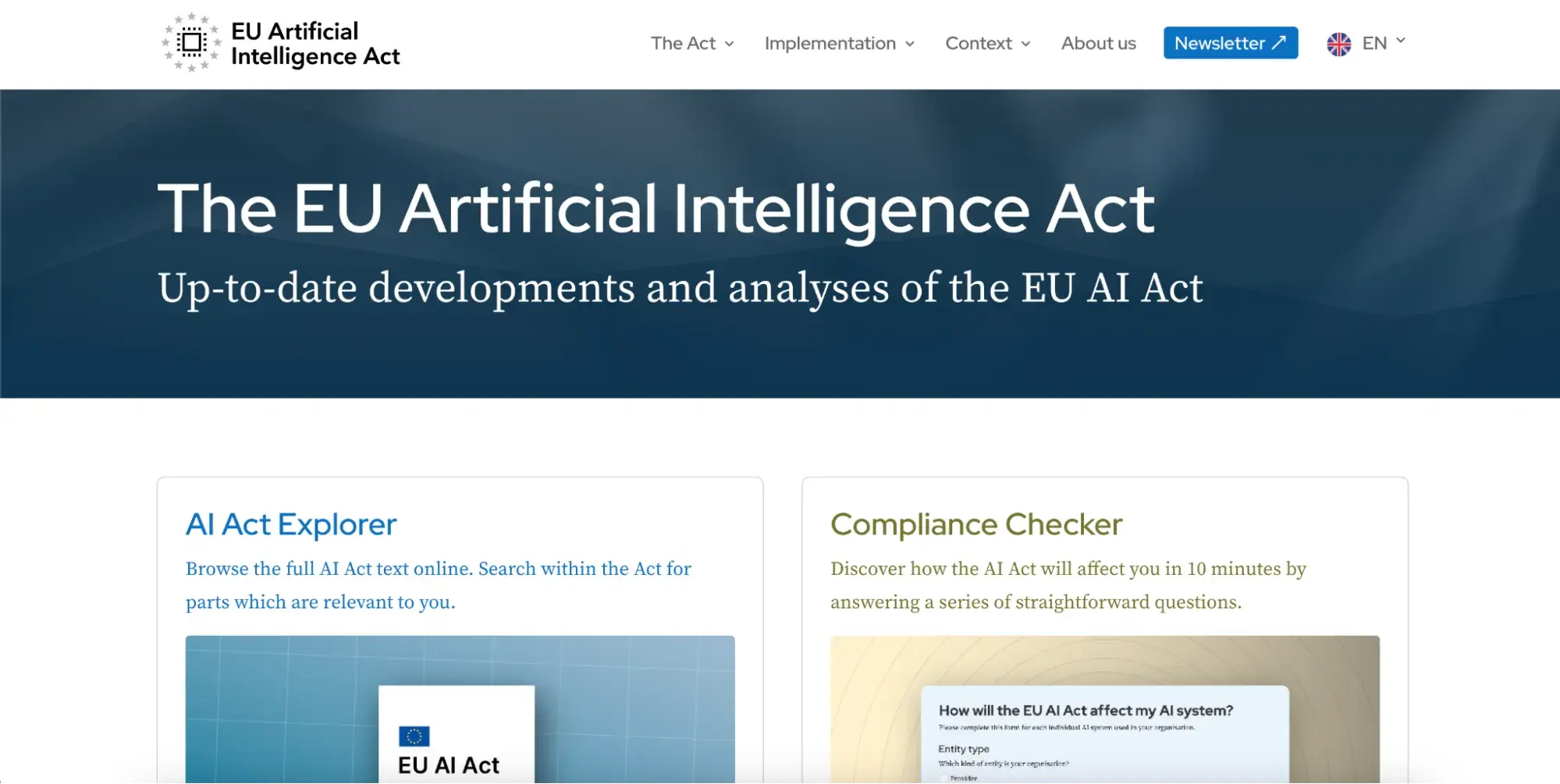
What if you’re not keeping up with the times? Your platform could still be relying on cookies, which have gone stale.
Statistic: When Google announced its phase-out of website cookies, 41% of marketers said their biggest challenge would be their inability to track the right data.
Data platforms that aren’t aggressively surveying and responding to changing regulations won’t be keeping up with the times for long. Small business owners aren’t data scientists; they can’t be expected to run their businesses, monitor the data landscape, and react accordingly.
This is why I think it’s beneficial to use CDPs that are leaders in the AI space, who will monitor AI’s evolution and adapt.
Get predictive insights.
AI can provide deeper predictive analytics than traditional data software. This predictive modeling turns a pile of numbers into actionable insights that can offer more personalized customer experiences.
Example: AI CDP platform Blueshift generates a rating for each customer based on their likelihood of converting, which updates automatically as more data is collected. This creates predictive segments, making highly targeted campaigns easy to develop and employ.
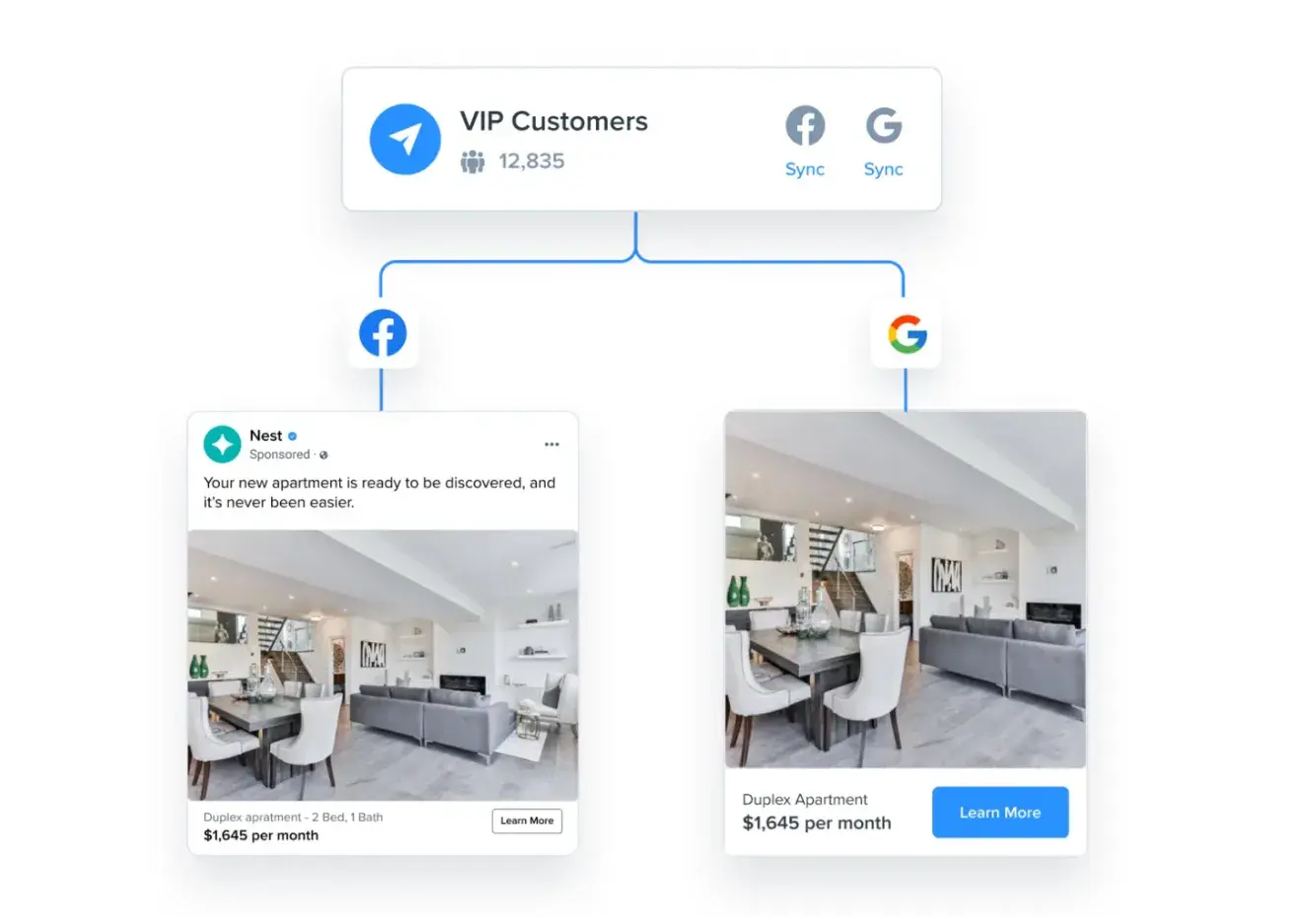
Improve customer experience.
Data isn’t only used by sales and marketing to help woo new customers — existing customers benefit greatly from it as well.
Customers’ information being gathered and processed by AI helps your customer service team deliver faster, more relevant support. Customer profiles contain more information than just purchase history and first-party data. AI platforms gather communication across channels and provide unique and actionable insights for service reps.
I know this can make some users nervous, but I welcome this because I’ve seen firsthand how AI is improving customer service for platforms that I use. And I’m not the only one.
AI in the wild: The next time you’re engaging with customer services, look critically at the conversation and see if you can notice past communications being accounted for.
Leverage machine learning.
Machine learning is a very powerful function of AI that enables software to read your data, learn from it, and make predictive insights. While similar results can come from data analysis tools, machine learning does this automatically without needing to be programmed. In marketing and sales, it enables data-driven decision making.
Pro tip: I suggest you start using machine learning with a focused scope to improve accuracy. The vast amounts of data will naturally lead to a lot of unnecessary data, and starting with a wide focus won’t get the same results.
https://www.youtube.com/watch?v=fBqFqcWVjCo&list=PLlw9qxNtFom2JqbUWKTALkvQ8TYl2Z5F0
Personalize customer experiences.
Recommender system algorithms changed the online experience radically — these algorithms took millions of social media posts and identified which ones you would like most. It offered a tailored experience to each user, which can now be taken to even further heights with AI-powered insights into customer interests. This can advance your sales, customer service, and marketing efforts.
Statistic: A study by Accenture discovered that 91% of consumers reported being more likely to shop with brands that remember, recognize, and provide relevant recommendations and offers.
For example, your data platform can leverage behavioral data to identify customers at a specific stage of the customer journey. Then, run targeted ads to that unique group. You can further the financial impact of personalization by only targeting high-value customers with a high customer lifetime value.
Pitfalls to Avoid
We don’t need to dwell too long on the downsides of using an AI CDP, but I think it’s worth touching on briefly. You’re not ready for an AI CDP if the following statements describe you:
- Lack of a plan. Gathering data without knowing how to use it is like setting sail without a destination.
- No team training. It’s a miscalculation to assume that your team understands AI and how it’s working to help them (not replace them).
- Lackadaisical approach to AI ethics. Ignoring AI ethics puts you on the fast track to losing customer trust and sinking below industry standards.
Pro tip: Understanding your KPIs is essential for leveraging customer data efficiently. Use our free customer service metrics calculator to help.
With the benefits and pitfalls understood, let’s get up close and personal with some of the most-recommended platforms on the market.
Examples of Some AI CDPs I Recommend
I’ve reviewed five of the most popular AI CDPs out there. Here’s a summary of their key features, stand-out qualities, and a summary of what online reviewers have to say.
1. Twilio Segment
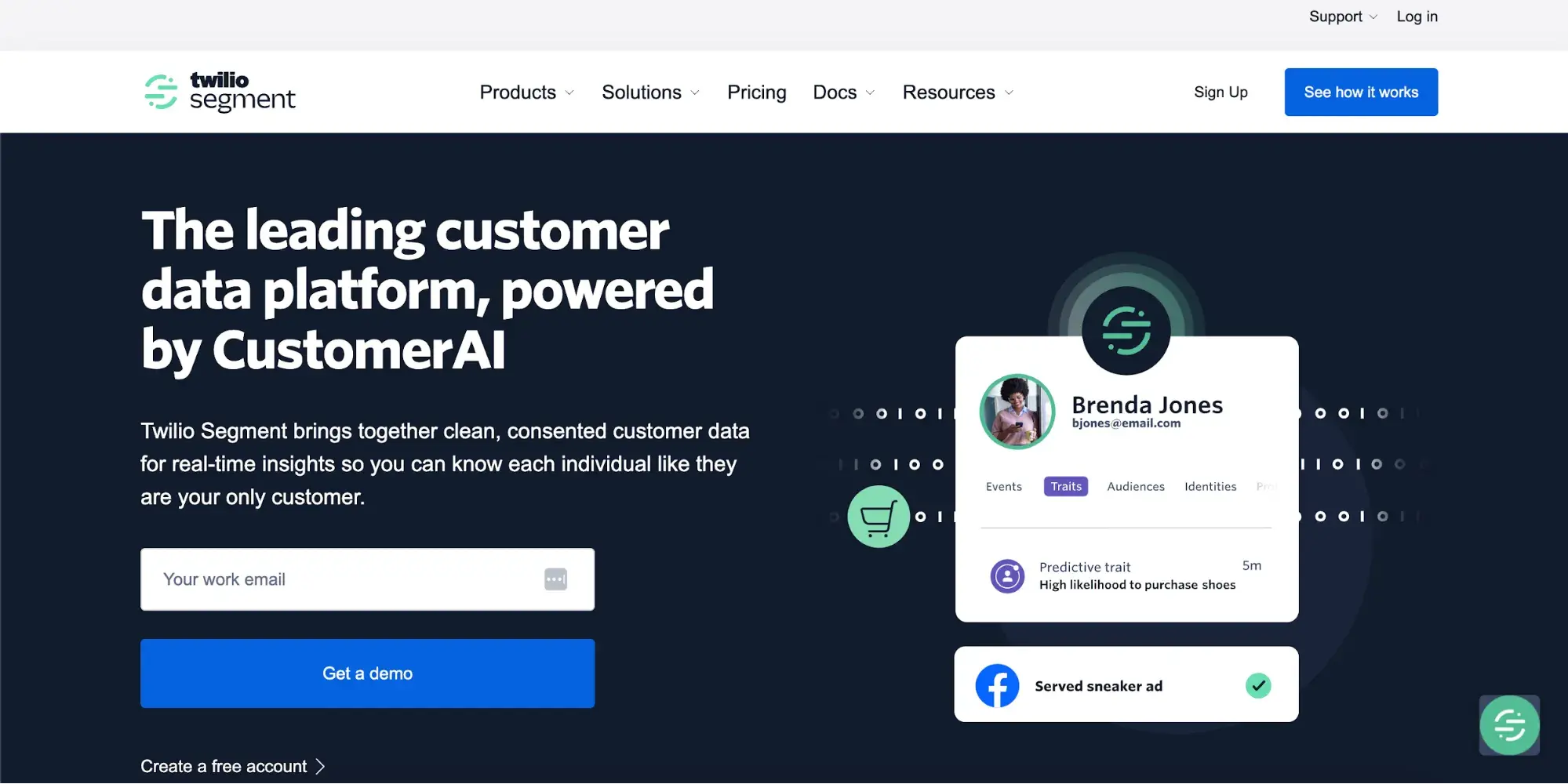
Twilio Segment (previously just Segment) has a heavy emphasis on using data and improving customer satisfaction and experience. I like the focus on activating customer data using pre-built tools in your dashboard. Key features include a unified view of customer data, predictive insights, and 400+ advanced integrations.
A powerful element is the Protocols feature, which tackles data cleansing. You can also explore features that are specific to individual departments, like data, marketing, and products. When you set up your account, you can select which department you work in. Then, you get a specific guided onboarding process. I thought this was a great touch that helped reduce overwhelm.
Price: Free trial followed by company-specific pricing.
Reviews: Online reviewers like the robust integration library and real-time data processing but complain about the price.
What I like: Twilio Segment has some catchy copywriting on its homepage: “Know each individual like they are your only customer.” This is an easy thing to say, but they followed through. I saw firsthand the personalized customer experience. On my first visit, the AI chatbot provided this message:
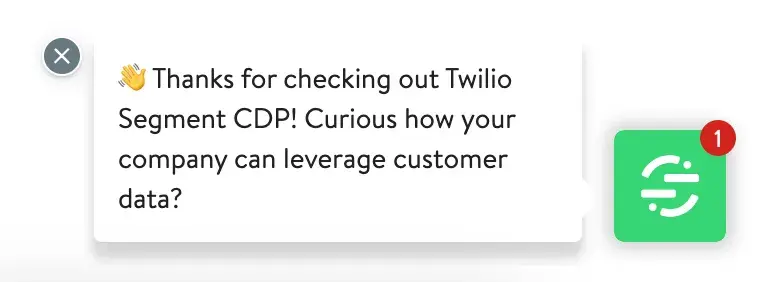
Then, on my second visit, it customized the chatbot based on my time already spent on their website:

This type of data usage felt natural and personal; more than anything, it got my attention.
2. Adobe Experience Platform
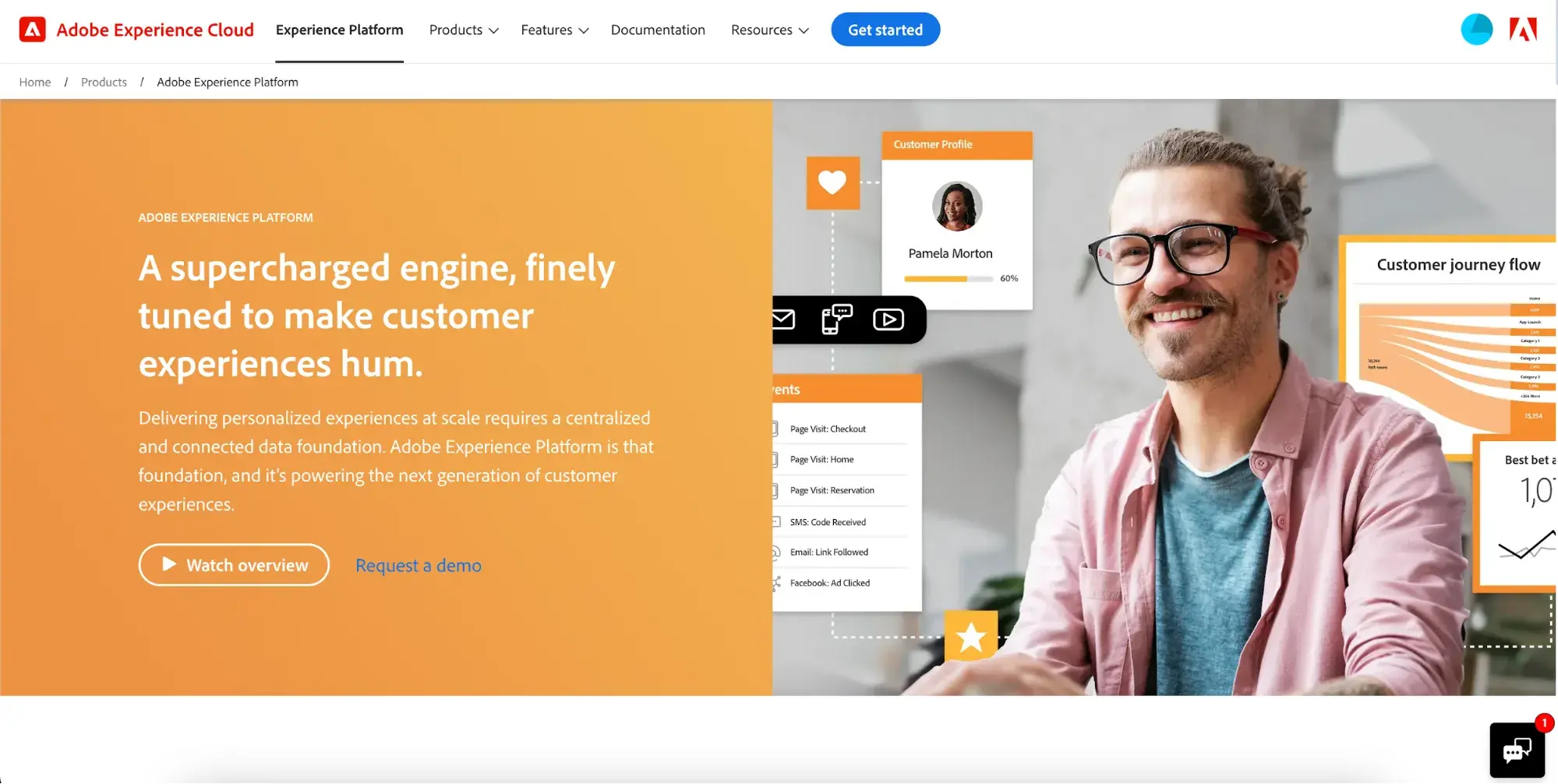
The Adobe Experience Platform is a powerful AI-fueled CDP that funnels many data points into one unified profile that updates in real time, without relying on third-party cookies. It integrates seamlessly with other Adobe products as well as major platforms you may use, like Salesforce, Paypal, Amazon, etc.
Data is pulled from both internal and external data sources, creating a holistic view of your customers at a glance. Not only is your customer data gathered for your review, but you can also have a conversation about it with Adobe’s AI system, called Adobe Sensei. For example, you can ask, “What’s my top audience this quarter?” and get immediate answers pulled from your sea of company data. I think this feature is amazing!
Price: Tailored pricing for each client.
Reviews: Online reviewers like the platform for both data activation and governance but cite steep learning curves as a drawback.
What I like: The ease of creating a customer or audience segment. Customer segmentation allows you to speak directly to specific groups within your customer base. Sometimes, these groups are easy to identify, such as customers who purchased a certain product within a set timeframe. Other times, AI can help you find much more nuanced groups, such as customers who are disengaged with your content and most likely not renew their subscription.
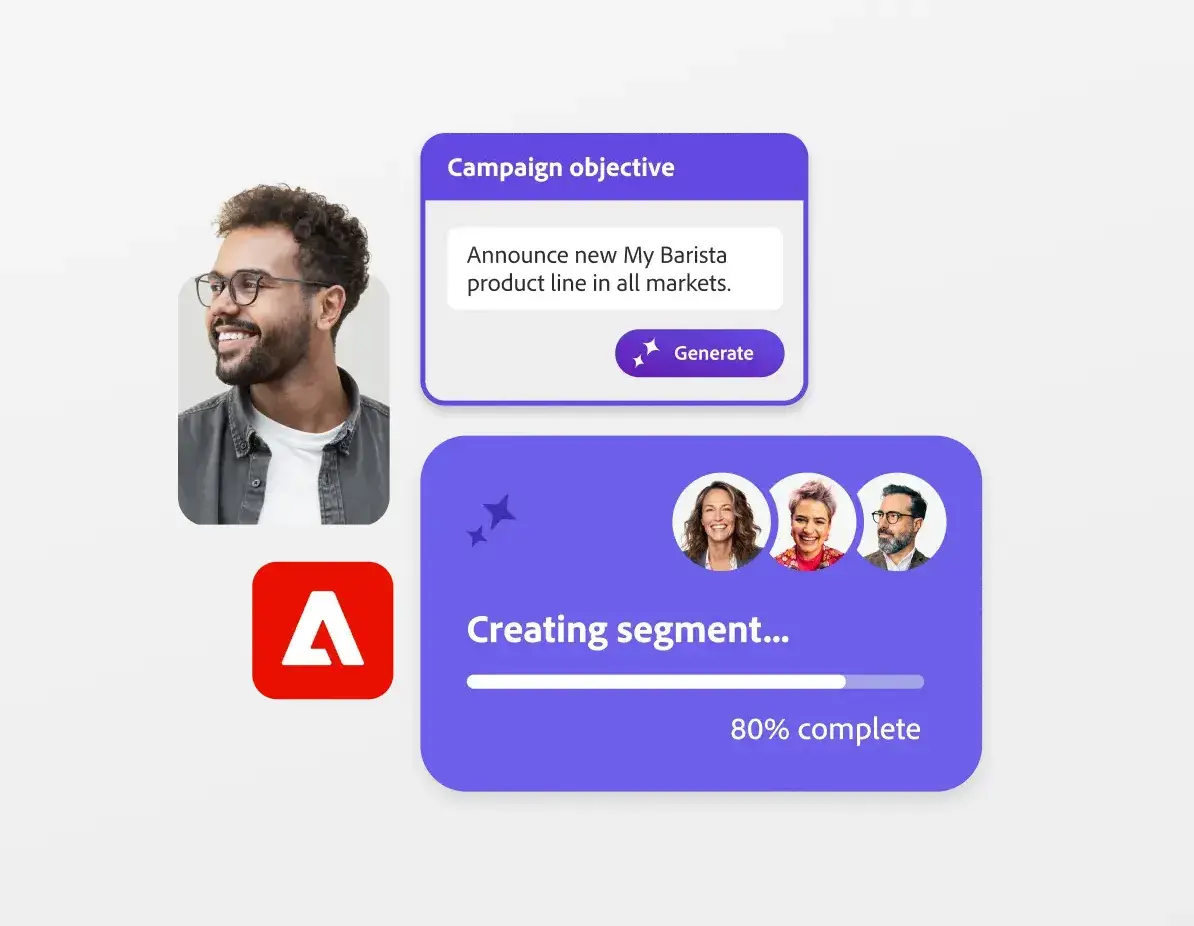
3. Salesforce Customer 360
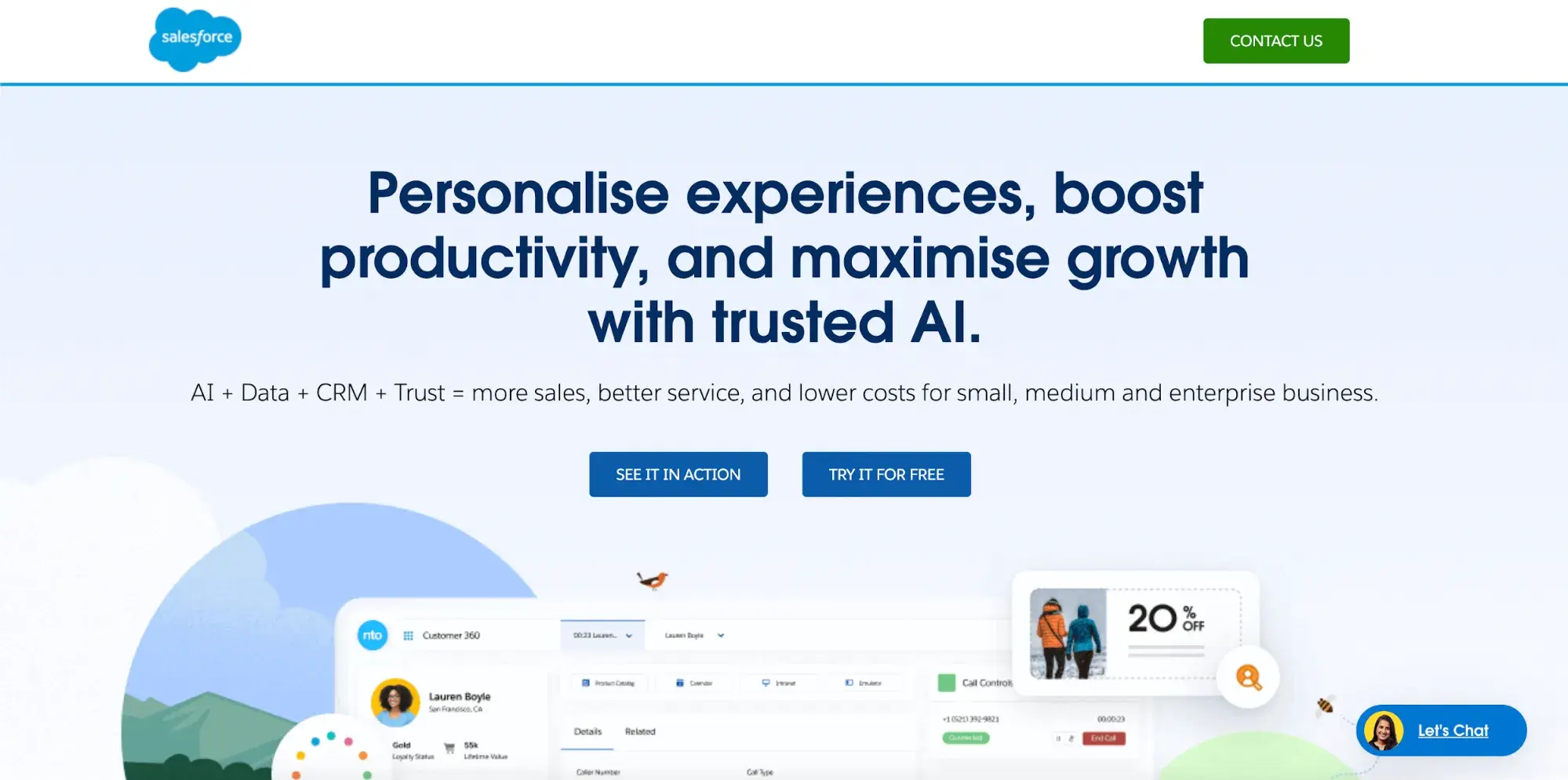
Salesforce Customer 360 is technically a customer relationship manager (CRM), but it’s a large, umbrella software that also fulfills the role of an AI CDP. Salesforce summarizes their platform capabilities this way: AI + Data + CRM + Trust. The Salesforce name is synonymous with trust. The company is a longtime pillar of the data world, and they’re now leading the way with how AI and data are integrated.
Price: Free trial followed by company-specific pricing.
Reviews: Online reviewers like the flexibility and scalability of the product, but the learning curve is cited as a common complaint.
What I like: I used Salesforce at my first salaried job out of college, and I remember how overwhelming I found it. In hindsight, I think that there’s no way for a software this enormous to feel approachable at first use. Salesforce invites you to set up a free one-on-one call with their team so they can discuss their software’s application in your business, which will help offer you a map through this massive platform.
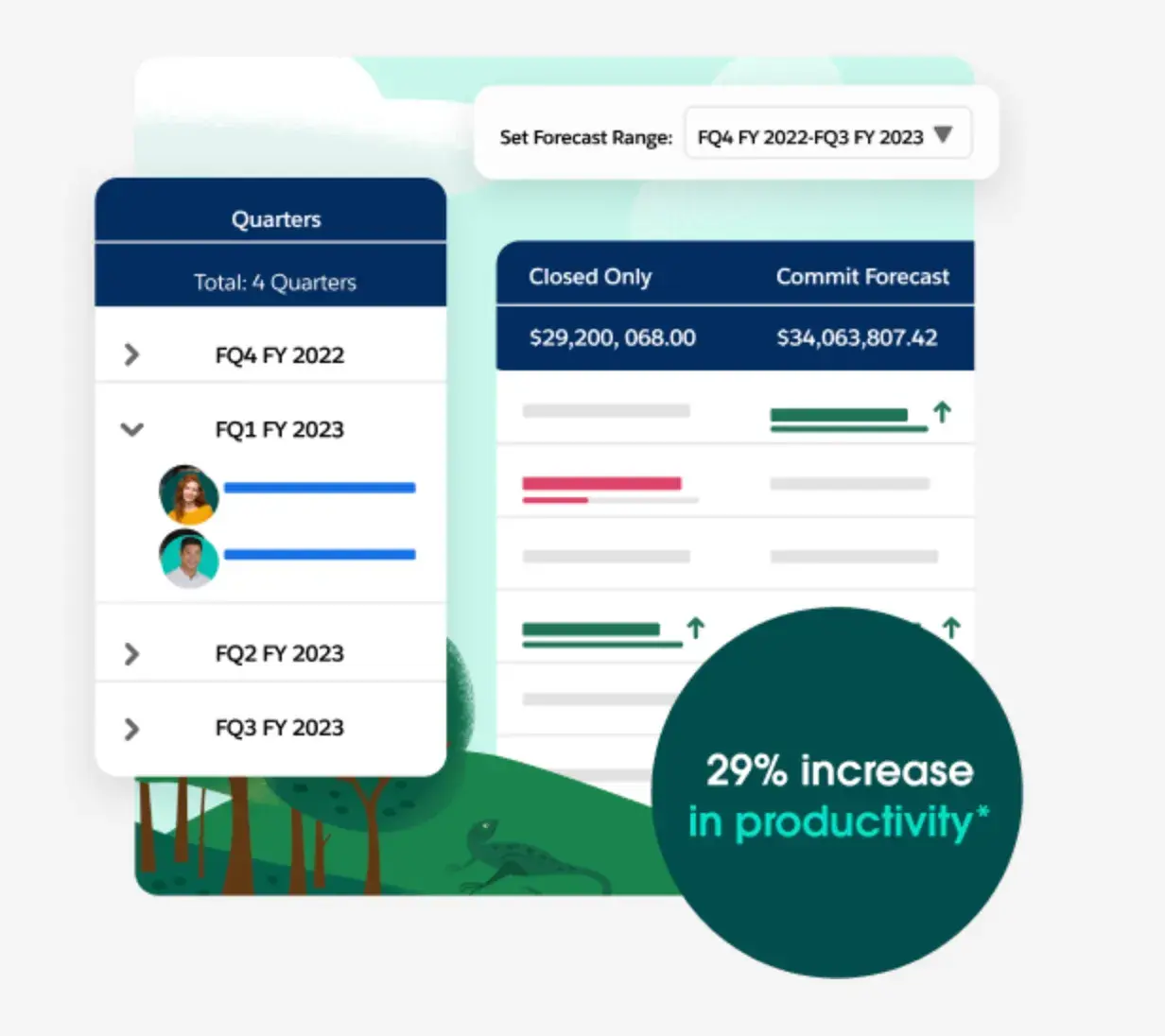
4. ActionIQ
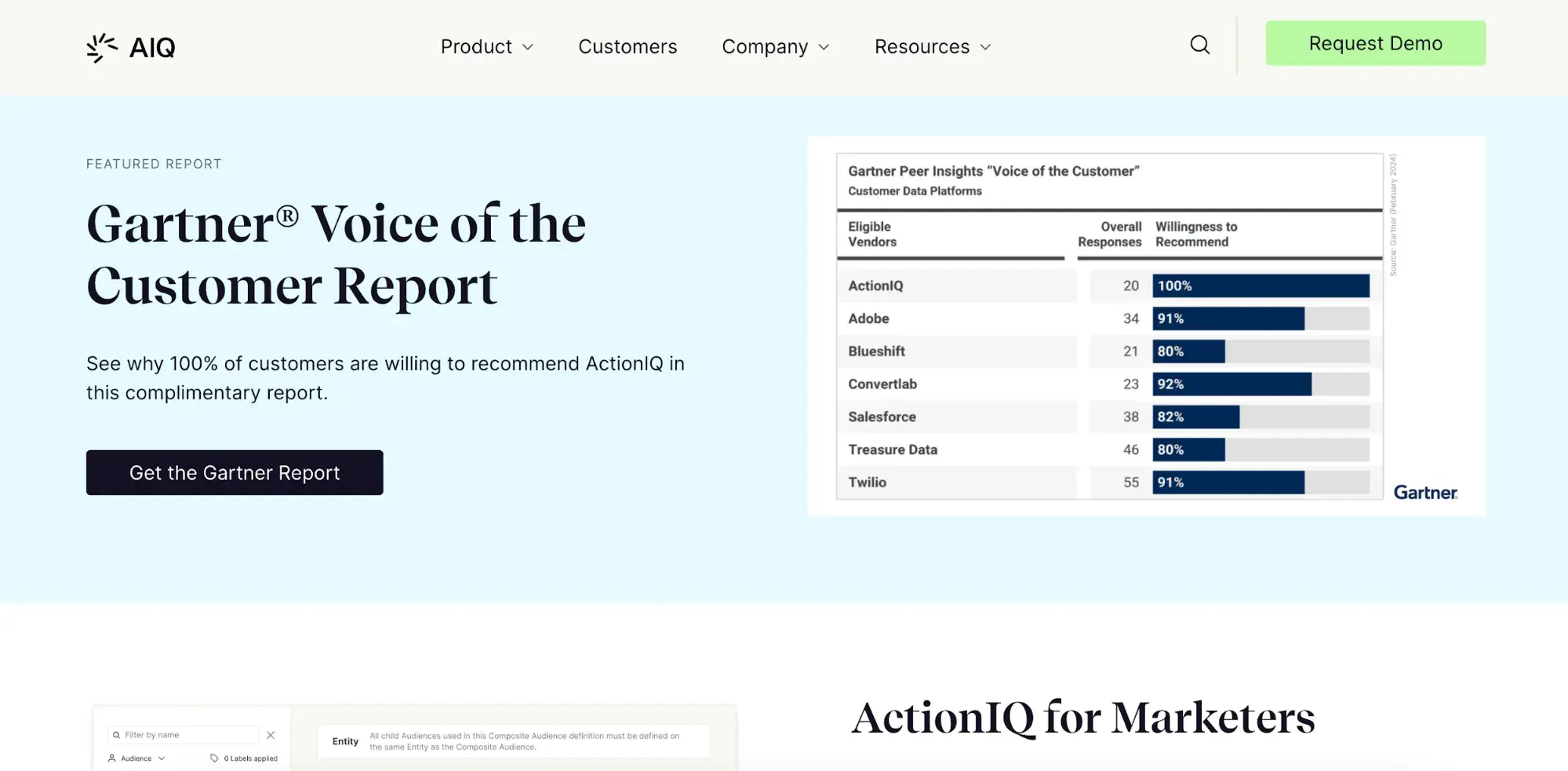
ActionIQ is a more contemporary AI-fueled data platform with advanced data architecture options. It’s a much younger platform than Adobe and Salesforce — Adobe is old enough to be ActionIQ’s parent. The advantage is that it feels more modern. As a user, I also feel like there’s a focus on adoption. Instead of reading endless info on product features, you can look at specifics for your different departments: marketing, information technology teams, data teams, and advertising.
Price: Tailored pricing for each client.
Reviews: ActionIQ has fewer reviews than other platforms, but customers shared that they liked the customer support and expertise of the team. Some reviewers also mention that there are kinks still being worked out.
What I like: Combine the comfortable user experience with its customer support, and this platform is very approachable for small businesses. I felt seen (and slightly called out) when they described their platform as having a “marketer-friendly interface.” This wasn’t just a line of sales copy — looking at the user interface, I feel like it rings true.

5. Blueshift
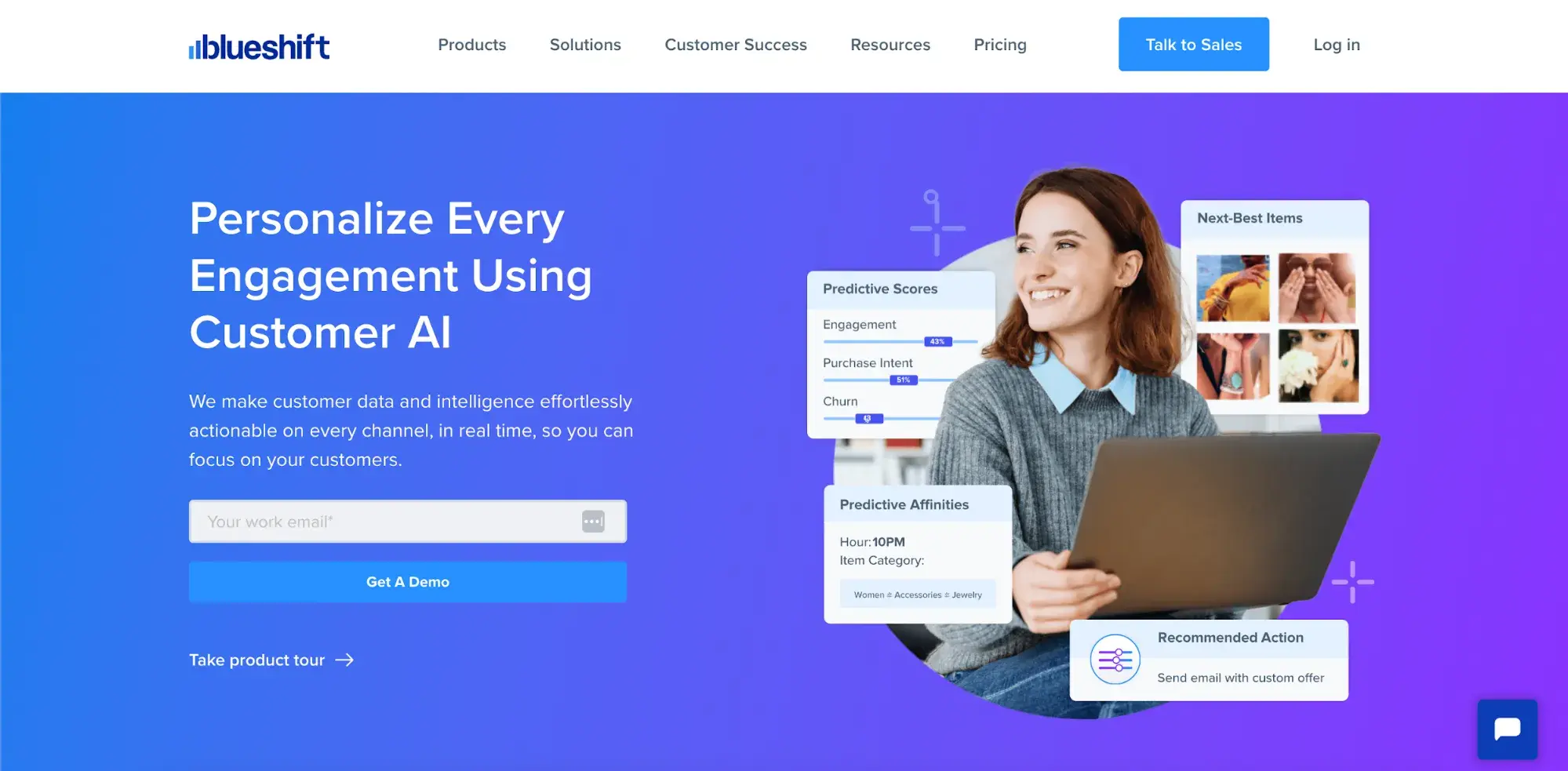
Blueshift describes itself as a three-piece combo: a CDP, an AI-based decision aid, and a cross-channel marketing platform. It focuses on data unification across channels, then leveraging AI decision-making to save time and improve efficiency. Customer reviews cite the ease of use and customer support as the biggest pros. Blueshift gets credit for being the only AI CDP on this list with a free plan.
Price: Free and $750+ per month.
Reviews: Online reviewers cited the automation and onboarding process as pros, while others mentioned some complexity when implementing.
What I like: The volume of data available is incomprehensible to me, so I like Blueshift’s emphasis on data activation. It feels to me like this platform was designed with the entire team in mind, which helps with software adoption and avoiding data silos. The focus on the customer journey, paired with the built-in generative AI features, paints a really exciting picture of what data can mean for your marketing efforts.
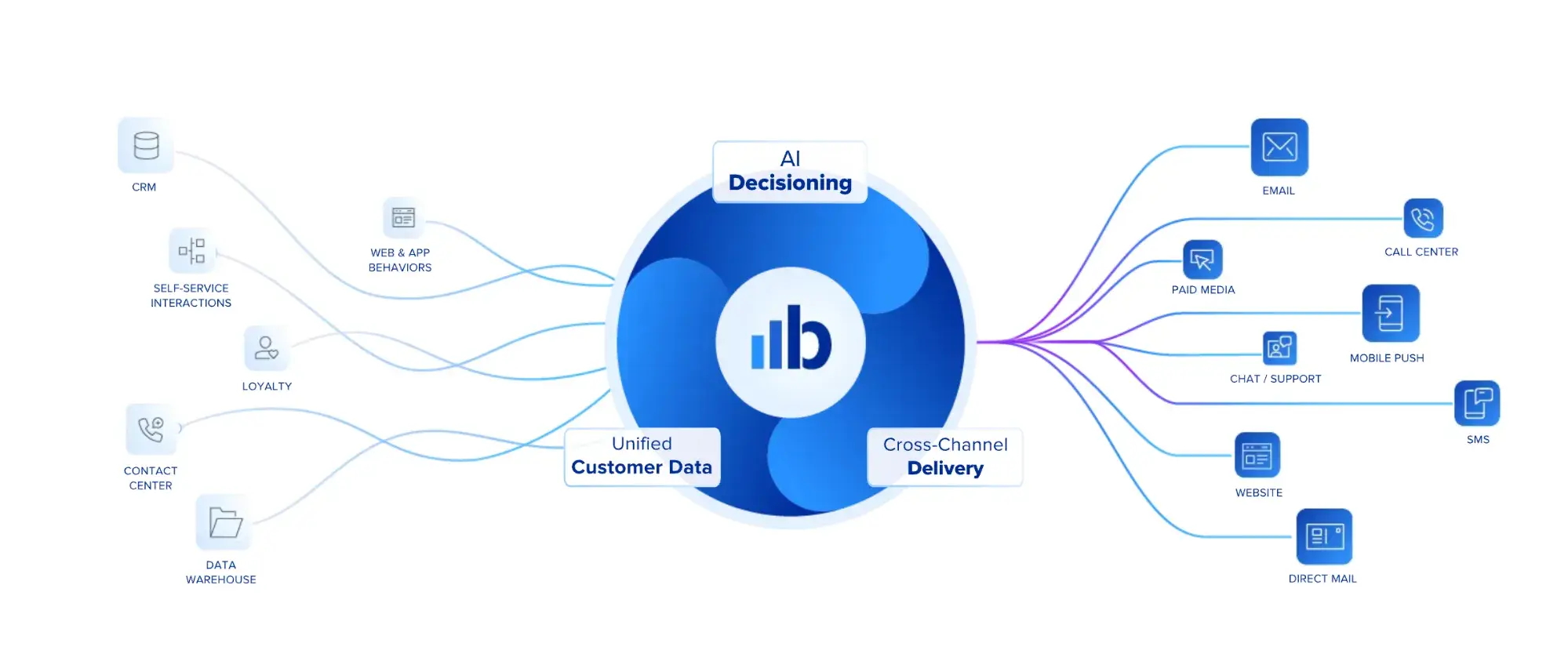
Detangling Your Data
It shouldn’t take a data science team to use an AI CDP. Thankfully, there are enough products on the market for each business to find what suits them best. I hope these statistics, tips, and product recommendations helped demystify the process of inviting AI into your data management process.
The presence of AI everywhere makes it feel like you’re living in the future, doesn’t it? To quote Spock, “Data is the key to everything.” Boldly take your customer data where no one has gone before.
![]()
Top 21 Survey Email Subject Lines & Survey Titles to Boost Response Rates
You did it — you created the perfect survey! But what’s the point if no one takes it?? I’ve found a good survey email subject line is the key to getting customers to open your survey and share their feedback. And since customer feedback is […]
ServiceYou did it — you created the perfect survey! But what’s the point if no one takes it??
I’ve found a good survey email subject line is the key to getting customers to open your survey and share their feedback.
And since customer feedback is invaluable, I’ll review the best survey titles and survey email subject lines to help guarantee that first click.
Continue reading or jump ahead:
Survey Subject Line vs Survey Title
A survey title is written directly on the survey landing page. Its function is both internal and external: Each survey title will be used by companies to track survey results, and it will also compel readers to begin taking the survey.
A survey subject line is displayed in customers’ email inboxes. Subject lines have one core purpose: to compel readers to open the email. There’s an enormous amount of psychology and research that goes into crafting the most successful email subject lines possible.

Get our free guide: 100+ email subject lines that work.
What Makes a Great Survey Title?
Did you know that survey pages can have very high bounce rates? You may have gotten a reader to click on the survey link, but that doesn’t mean that they’re compelled to complete it just yet.
Here are some survey title characteristics I’ve discovered that successful campaigns embody:
- Unique title every time. Your company may run the same survey every quarter or year, but it needs to be given a unique name so that you can track each campaign accurately.
- Personality. You’re asking customers to put time into your survey, so start off on the right foot by putting in some effort yourself. Avoid generic titles like “Customer Satisfaction Survey.” When I see a survey with these blank generic titles, I assume the company put very little thought into it.
- Include the customer. One of the most powerful words in copywriting is “you.” Tell us your opinion, we want your thoughts, how did you find us? Break the fourth wall and look the customer directly in the eyes.
I’m going to share a lot of examples of these principles in action as you read on.
In most cases, your survey title and your survey email subject line may go hand in hand. Let’s review some examples of survey titles based on the type of survey you’re running.
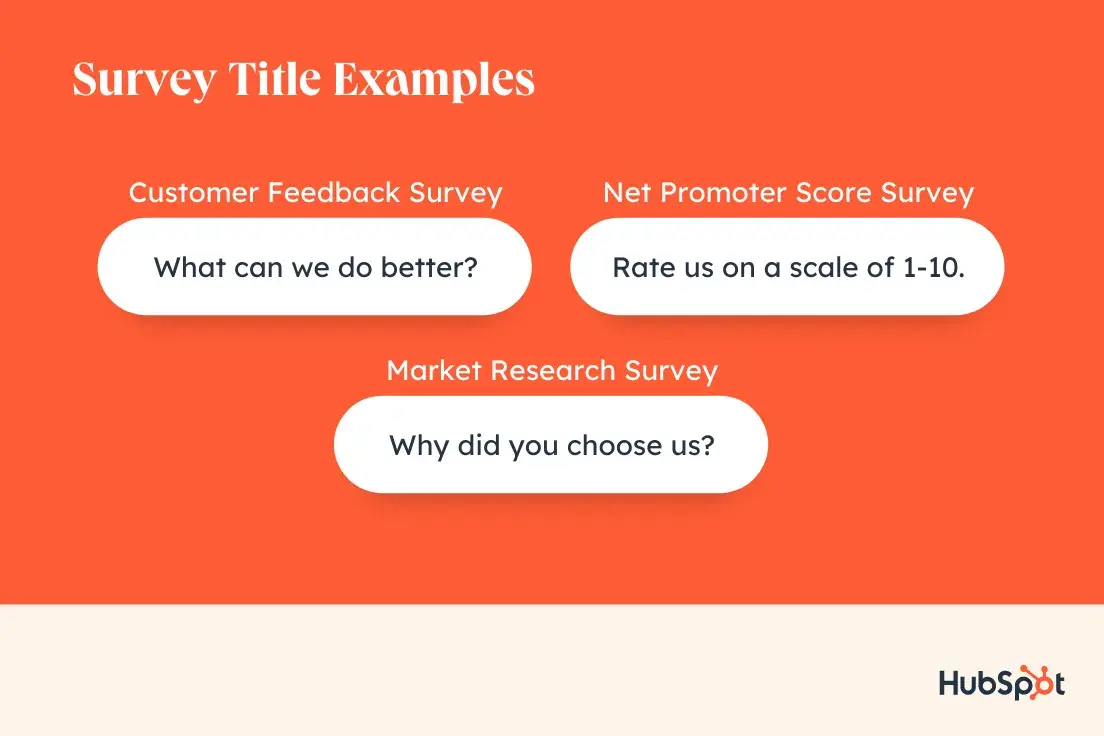
Customer Feedback Survey Titles
Here are a few customer feedback survey title ideas:
- How did you find us?
- Tell us about your last customer service experience.
- What can we do better?
Use our free customer satisfaction survey templates to gather this information quickly!
Net Promoter Score® Survey Titles
Here are a few NPS survey title ideas:
- How likely are you to recommend us to a friend or colleague?
- Rate us on a scale of 1-10.
- How do you feel about our product?
Market Research Survey Titles
Here are a few market research survey title ideas:
- What motivates you to do business with us?
- Share how you would rate our pricing for this product.
- Why did you choose our services?
What Makes a Great Subject Line for a Survey?
Your subject lines make or break your survey campaigns, in my opinion.
Statistic: 35% of customers report opening emails based on the subject line alone.
Here are some characteristics that successful email subject lines are made of:
- Clear intent. While survey emails with curious subject lines may get high open rates, they won’t necessarily yield more responses. I hate feeling tricked into opening an email with a misleading subject line — no one likes feeling like this. Clear subject lines build trust.
- Personalization. Email personalization is easy to achieve, and it helps subject lines stand out. I personally find that seeing my name at the end of the email subject line gets my attention more than any other type of personalization.
- Familiar tone. When I regularly open emails from a business, I know their tone, and it rings alarm bells when the tone suddenly changes. Ultimately, I recommend letting your normal email marketing team have the final say on the subject line copy to keep your company on brand.
Pro tip: A/B test your email subject lines to help you gain insight into how your audience reacts to your content.
To build on these principles, let’s look at the best survey email subject lines.
Best Subject Lines for Surveys
Below, I’ve compiled 21 captivating survey email subject lines to help you grab your audience’s attention and increase survey participation.
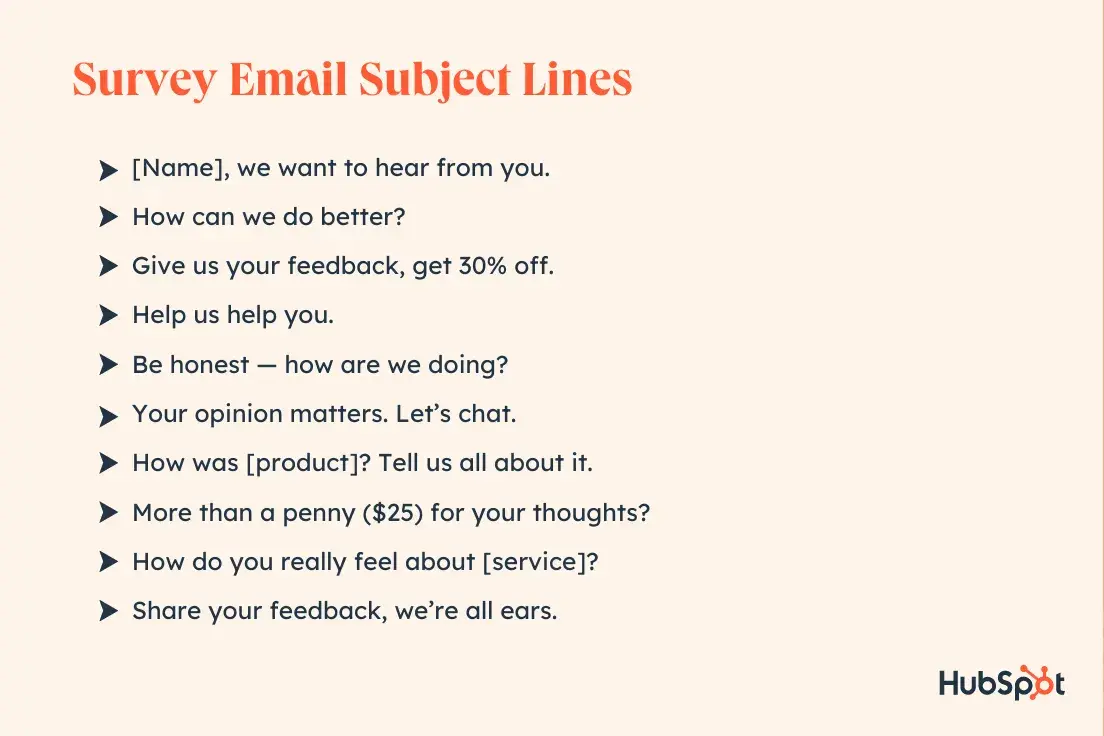
1. [Name], we want to hear from you.
Why this works: The name personalization in the subject line makes the outreach more human, and you’re letting the customer know that you’re listening.
2. How can we do better?
Why this works: You’re recognizing that your products and services aren’t perfect, but you’re also willing to take the necessary steps to improve. I think this show of humility gives customers more confidence in your brand.
3. Give us your feedback, get 30% off.
Why this works: This shows the customer that you want to create a mutually beneficial relationship, and it incentivizes them to take your survey.
4. Help us help you.
Why this works: This is another relationship-building tactic because it tells the customer that you want to work together to meet their needs.
5. Be honest — how are we doing?
Why this works: By encouraging honesty, you’re creating an environment where customers are empowered to speak freely and more likely to contribute their thoughts and ideas. In my experience, honest feedback is the most valuable feedback.
6. Your opinion matters. Let’s chat.
Why this works: You’re letting the recipient know that you care about how they feel, and you’re giving them a forum to make their thoughts heard.
Here’s an example of this subject line copy in the wild, sent by Ring.
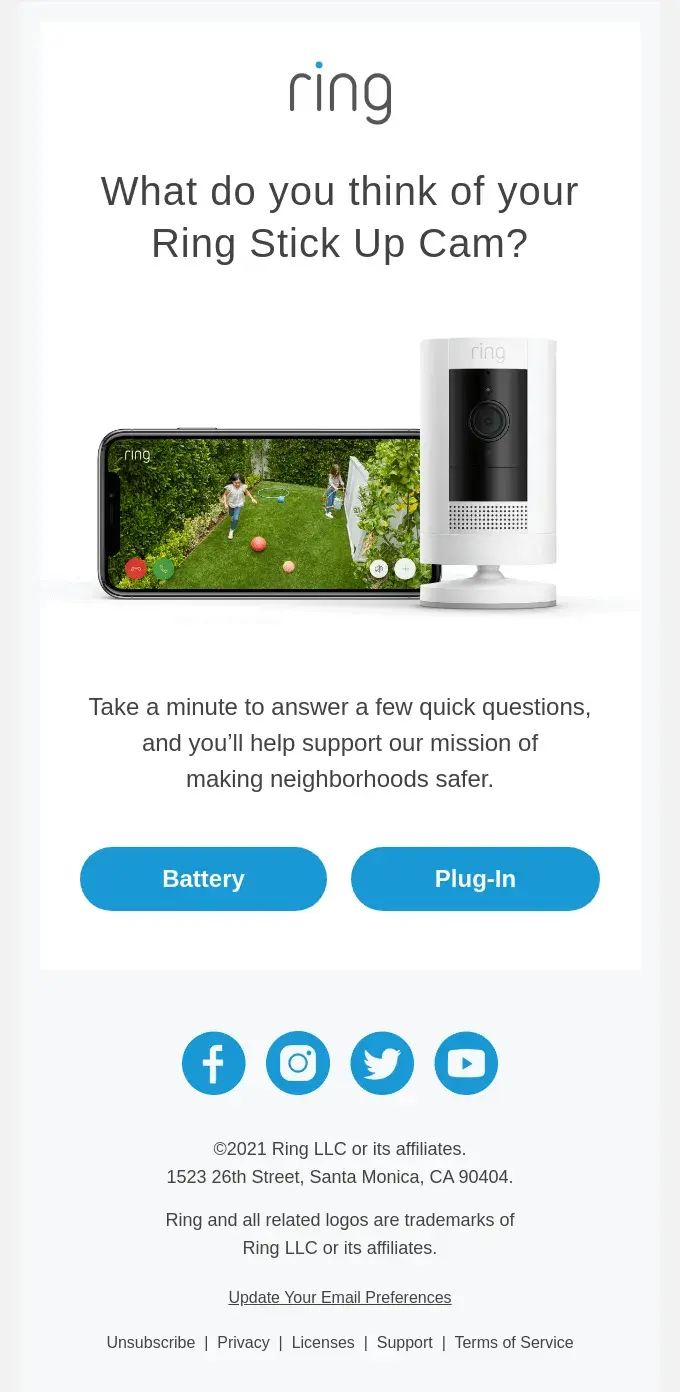
7. How was [product]? Tell us all about it.
Why this works: I like how the product personalization allows you to specify the type of feedback you’re requesting, and it makes the customer feel like you appreciate them as an individual.
8. More than a penny ($25) for your thoughts?
Why this works: This recognizable play on words is eye-catching, and the incentive gives customers a reason to participate in your survey.
I found an example of this subject line in the wild, sent by Tailor Brands:
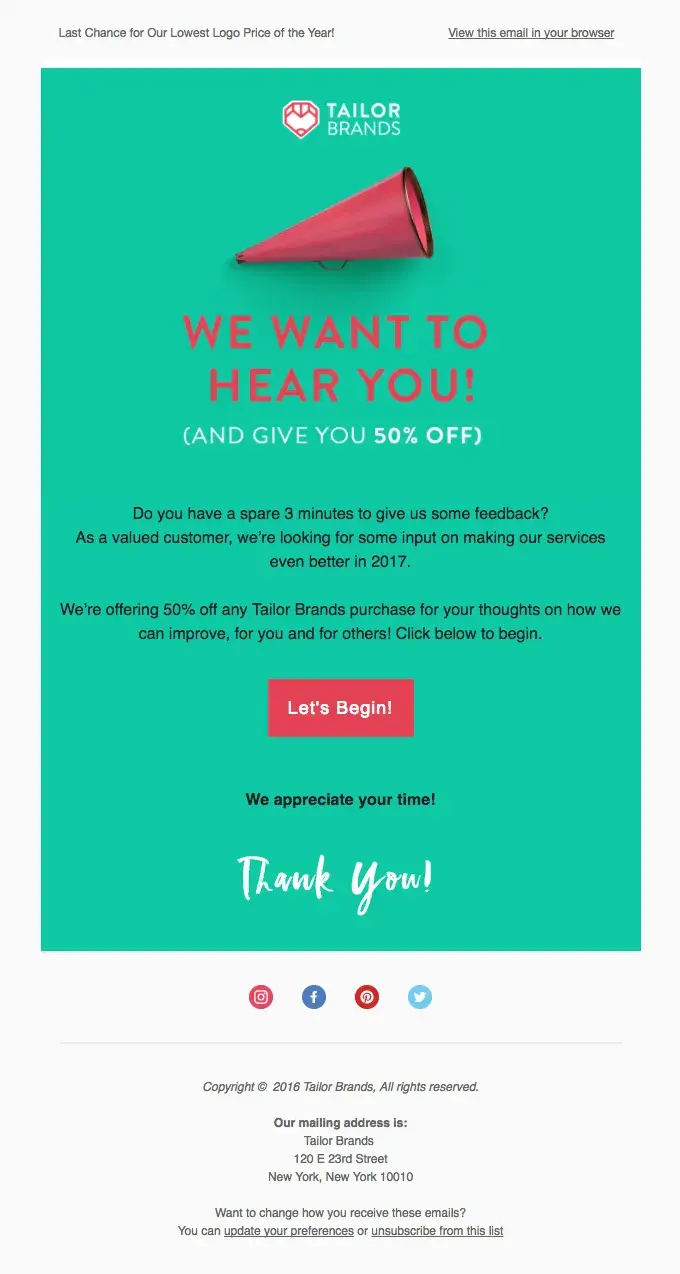
9. How do you really feel about [service]?
Why this works: This encourages customers to air out their true feelings, and the service personalization adds that human touch that customers are looking for.
10. Share your feedback. We’re all ears.
Why this works: I think the “we’re all ears” phrasing emphasizes that your company is willing to accept feedback with open arms and ready to act on it.
11. Thoughts on our customer service? 👂
Why this works: When you make customers feel valued, you win. Plus, existing customers can point out holes and shortcomings with your customer service better than your internal team can.
Statistic: 64% of customers say they’ll choose a new company to purchase from if the original company doesn’t have good customer service — no matter how enjoyable they find the product.
Need help managing your customer feedback? Use the HubSpot customer feedback tool.
12. It’s been 14 days. How’s it going?
Why it works: Automating this customer success email survey to send within a close time frame after purchase can help turn a one-time purchase into a long-term relationship. You also get incredibly powerful data from customers by asking if they’ve quickly achieved their goals with your product.
The subject line was inspired by the company Bellroy, which sent me the below email using the subject line “Day 30. What’s happened so far?”

13. What’s NOT working with [product], [name]?
Why it works: Negative customer feedback, while unpleasant, is an enormous opportunity for companies. To quote Bill Gates, “Your most unhappy customers are your greatest source of learning.” I find it feels honest and authentic to see a company asking to hear your complaints.
Statistic: 62% of customers have reported that they share a bad experience with others. I think it’s better to hear that bad experience directly so you can address it head-on.
14. Survey closing 🚨 last day to share your thoughts
Why it works: Putting a time limit on your survey creates a sense of urgency for readers and inspires action, getting attention and improving response rates.
15. Name, how did you like [purchase]?
Why it works: While getting big-picture feedback from customers can feel like pulling teeth, it’s much easier to engage customers in specific satisfaction surveys. This is another type of customer success email survey that can help you get very specific insights into how customers are finding your product or service.
Inspired by this automated email sent by Amazon:
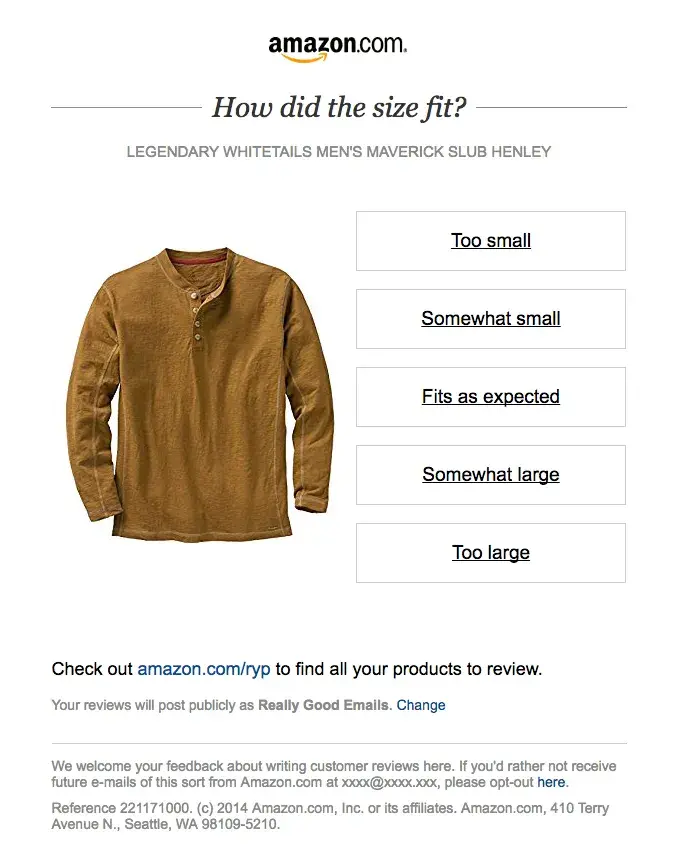
16. Not your average satisfaction survey 👀 (takes 60 secs)
Why it works: Customer surveys are a dime a dozen, and customers are constantly asked to participate. Give viewers a reason to feel that yours is worth completing. Just make sure that you deliver something “un-average” in your email body!
17. Our survey is literal trash without you, [first name]
Why it works: This funny, candid subject line is less corporate-speak and more friendly text. Old, large companies rarely have the flexibility to take risks with humor (who wants to upset board members by being “unprofessional?”), so a casual tone is a superpower only wielded by the little guys.
18. Tell us what you think of [company name] in 30 seconds
Why it works: The 30-second time clock is the secret ingredient of this email’s subject line. Who doesn’t have 30 seconds to spare? Customers will appreciate the ease and give quick, candid feedback.
Here’s an example of this email survey subject line I found in the wild, sent by Thumbtack:
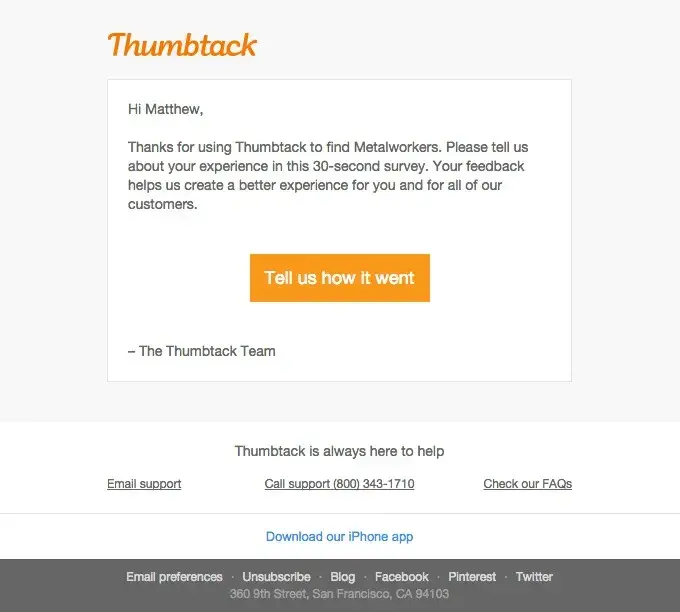
19. Yes, a company survey (but NOT a waste of time) 🦄
Why it works: Pulling the viewer’s attention to the word “NOT” is eye-catching and creates intrigue. It’s slightly clickbait-y, but just make sure you follow through on your promise in the email body. The unicorn emoji is a nod to the slang definition of “unicorn,” meaning that this is rare.
20. Want your ideas reviewed by the team?
Why it works: Everyone likes to feel listened to, and this subject line plays right into that customer psychology. It also implies that readers have valuable insights that the team can benefit from, building a positive connection.
21. We’d looooooove your feedback, [name]!
Why this works: The exaggeration and candid nature of this subject line make it feel less like corporate marketing and more like a text from a friend.
This subject line was inspired by the below example from Flywheel. I love that they followed this subject lineup with a line of party emojis inside the email body copy.

Now that we’ve reviewed some survey email subject line examples, let’s discuss best practices for writing your own.
These are my best practices I hope you consider when writing your next survey email subject line.
Align with your goal.
Your survey email subject line should support your overarching survey goal. Since there are many different types of surveys to choose from, think about the following:
- Why did you choose that particular survey method?
- What are you hoping to get out of the survey?
- How do you plan to leverage the feedback you receive?
I recommend you make it clear to customers why you’re running the survey so they understand how they can contribute. Here’s a great example from South Dakota tourism that aims to re-engage cold email subscribers by asking them to click on the tourism experience that the recipient would enjoy most.
The subject line “Let’s Reconnect ❤️” is short and sweet, which makes it no surprise that it leads to a very short survey. The results of this survey may feed the brand’s content creation plan or feed future tailored email campaigns.

Keep it concise.
The best survey email subject lines are brief and to the point. You have the body of the email to capture the nitty-gritty details, so only include the most compelling information in the subject.
I think a good rule of thumb to follow is to keep your subject line under 10 words and to use no more than 40-50 characters.
Brevity gets the recipient’s attention and respects their time — it’s a copywriting superpower. Here’s a great example from Virgin Airlines — the subject line “Tell us all about it” says everything it needs to say in 20 brief characters.
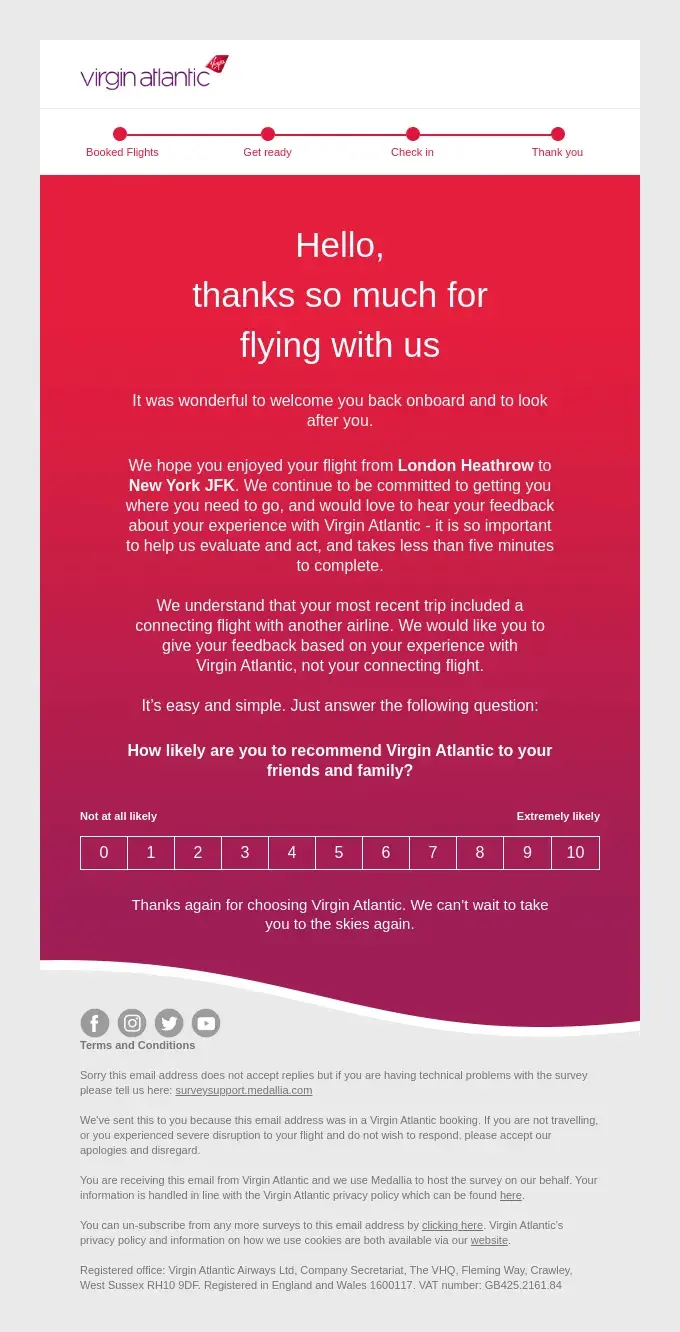
Make it personal.
Customers want to feel like you value them personally, so it’s important to craft a subject line that humanizes the interaction and adds a personal touch. I suggest using their name or specific details about their purchase history as part of your survey communications to show them you acknowledge them as an individual.
Warning: Using someone’s name alone isn’t effective enough to get a positive response rate. I saw an email from one company that simply used the subject line “👋 Hey [First Name]!” I imagine this got pretty good open rates… and a fair share of unsubscribes. This is a flop in my book.
It feels sneaky to use someone’s name as clickbait to trigger their curiosity. Instead, try thoughtful, personalized subject lines. Here’s an email example of a more effective personalized subject line from Golden State Warriors that used the subject line “[First Name], We Want to Hear Your Thoughts!”
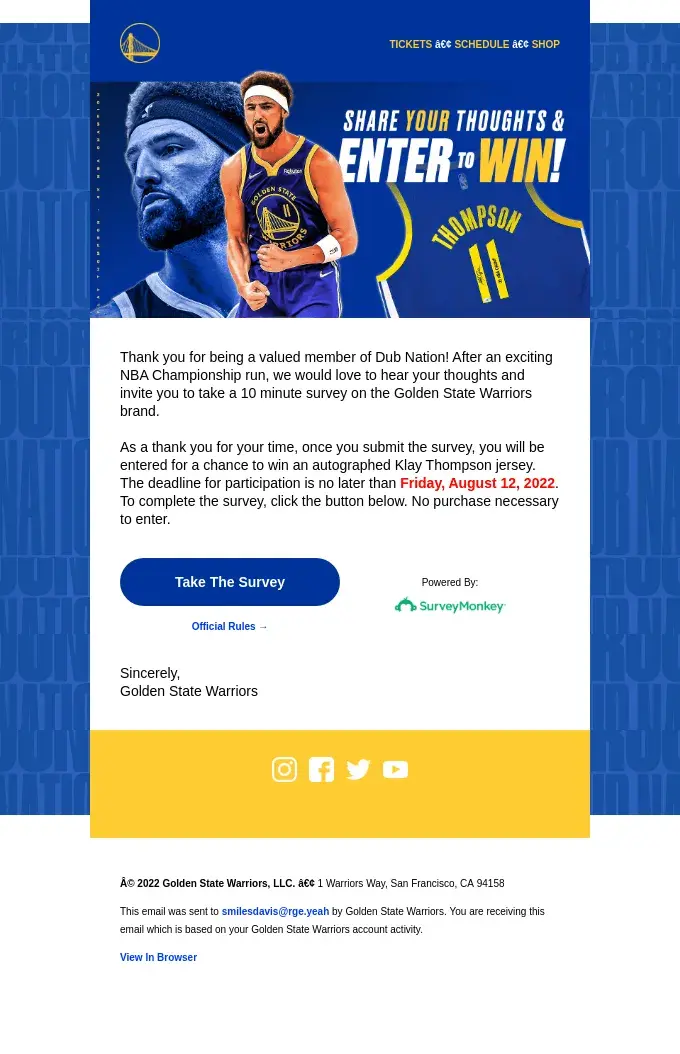
Highlight incentives.
In a crowded inbox, a gift stands out (let’s be honest, where DOESN’T a gift stand out?). If you’re giving out a reward for survey participation, let your customers know that upfront.
You can (and should) highlight discounts, freebies, and other offers directly in the subject line. In other words, tell customers what they’ll get in return for their participation. Quid pro quo. A good subject line highlights this right away to hook the reader.
Here’s an example from coffee company Grind: “Answer a five-minute survey, win a Coffee Machine.” As you’re writing these incentivized headlines, be sure not to step into the spam territory (next time).
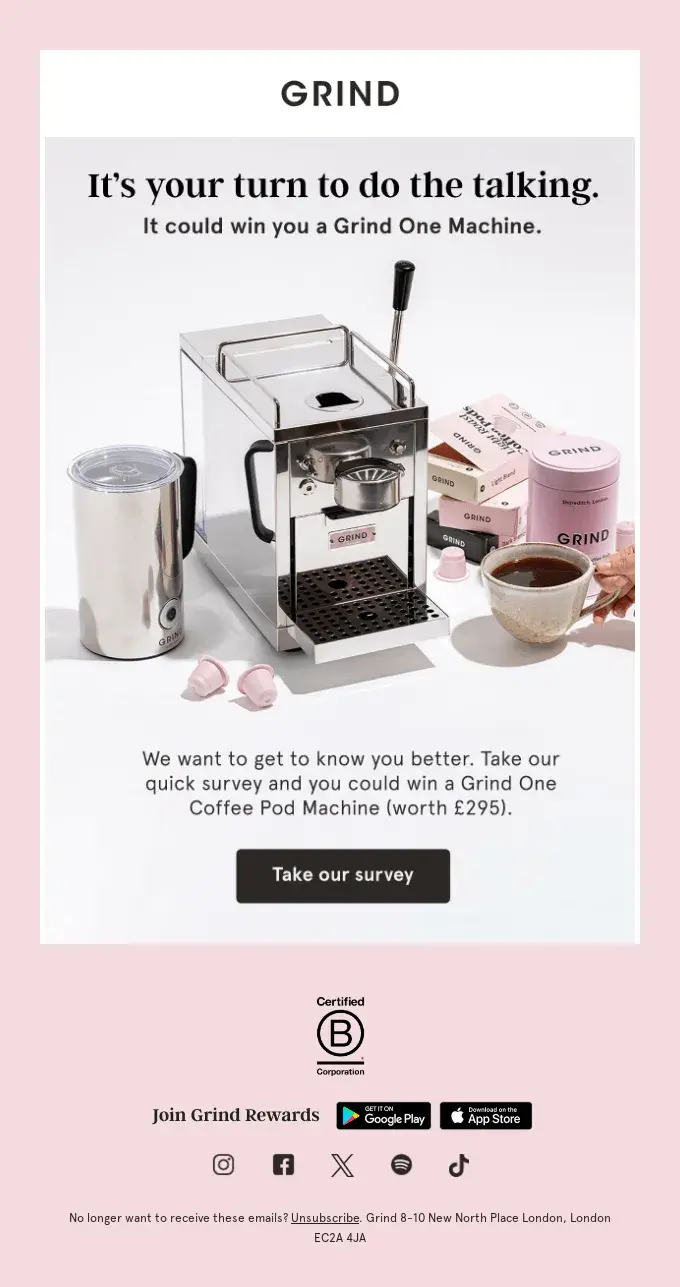
Avoid inbox spam filters.
Did you know that certain email subject lines can send your emails straight to the inbox graveyard — the spam folder? Large numbers, like saying “$1 million,” can get your email marked as spam. You may be surprised to hear that the word “free” is also on that list, though using one trigger word isn’t an automatic sentencing.
I should also mention you’re not just trying to avoid inbox spam detectors here; you also don’t want the recipient assuming the email is spam.
Statistic: 69% of customers report marking an email as spam based on the subject line alone.
Here’s a great subject line example from Lonely Planet: “Help Lonely Planet map our next chapter 🗺️.” There’s no exaggerated language that raises concerns with viewers — just a simple invitation.
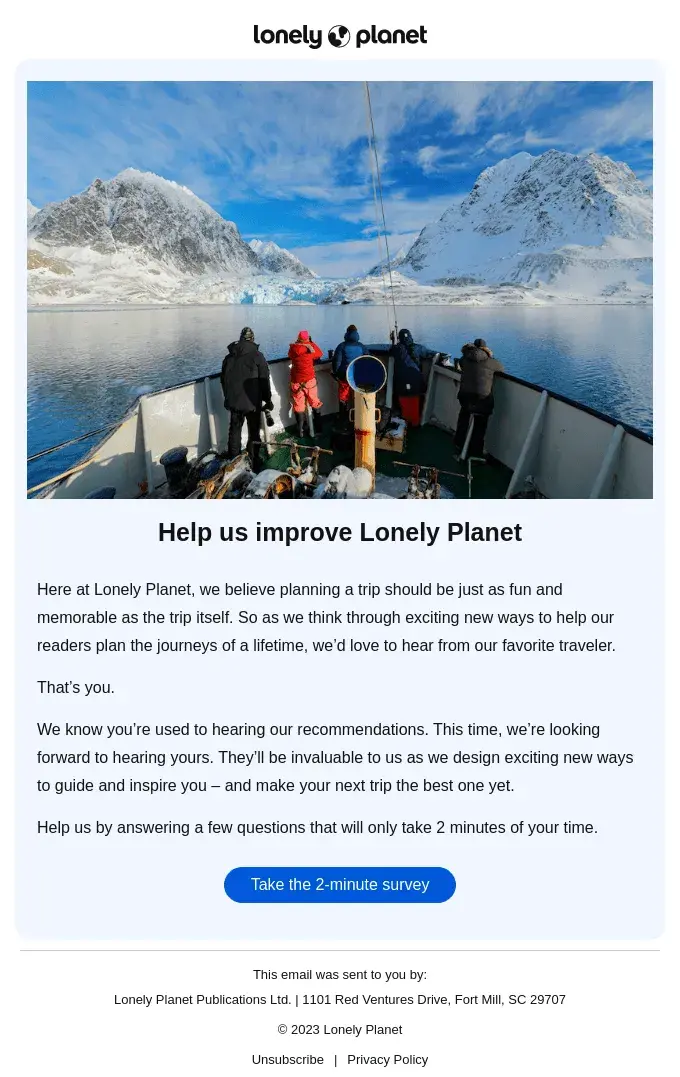
Center the customer.
I currently have a survey email in my inbox with the subject line “[Company] Needs Your Feedback!” and… it misses the mark. Why? Because it centers the company instead of the customer.
The best email surveys make viewers feel like the CENTER of the company’s universe. Beyond offering an incentive, email survey subject lines can also communicate to viewers that the survey is meant to improve their experience.
The below answer is from The Browser Company, and it’s not a typical survey email. The bulk of this email campaign is spent letting viewers know how customer feedback has improved the platform. I think the subject line “Arc Update | Your feedback = our new features” hooks readers, then at the bottom, with just a single paragraph, it invites more user feedback.
Most companies tell customers that their feedback matters; this email shows customers.

Consider an ethical angle.
As helpful as a customer satisfaction survey is, customers know that this feedback helps the company ultimately improve its sales. But I think you have an opportunity here to shine a light on the mission-based part of your company’s work with your surveys and subject lines. This is powerful because users care about the values of the companies they support.
Statistic: 82% of shoppers report preferring to support a company with values that align with theirs.
Here’s an example I found from the clothing brand Eton that asks users to weigh in on their sustainability agenda. The subject line “Take part in our sustainability survey” immediately helps readers identify this as a mission-based email survey and makes them feel included in a positive initiative.
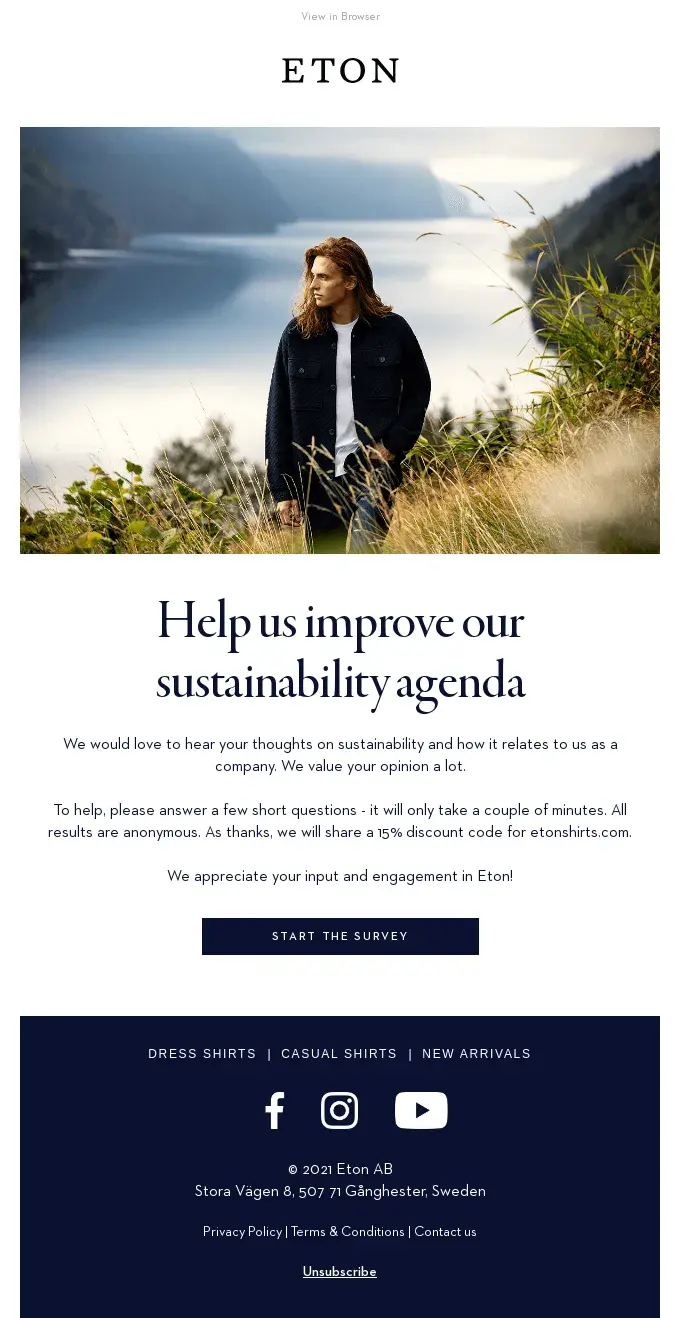
Use emojis 🕺
Emojis — whether you think they’re fun or unprofessional, you can’t deny that they draw your eye (especially in a crowded inbox). I find emojis are a 🚀 powerful tool for improving survey response rates.
Statistic: 60% of email subject lines containing emojis perform better than those without emojis 😳
The below survey email from Best Day Brewing has the subject line “Can We Ask You One Question? 🙏,” which sticks out thanks to the candid tone and personal feel of the emoji. I also like how the company followed through on its promise of a quick survey. They caught viewers’ attention and made it easy to engage, which is a recipe for a good email survey.
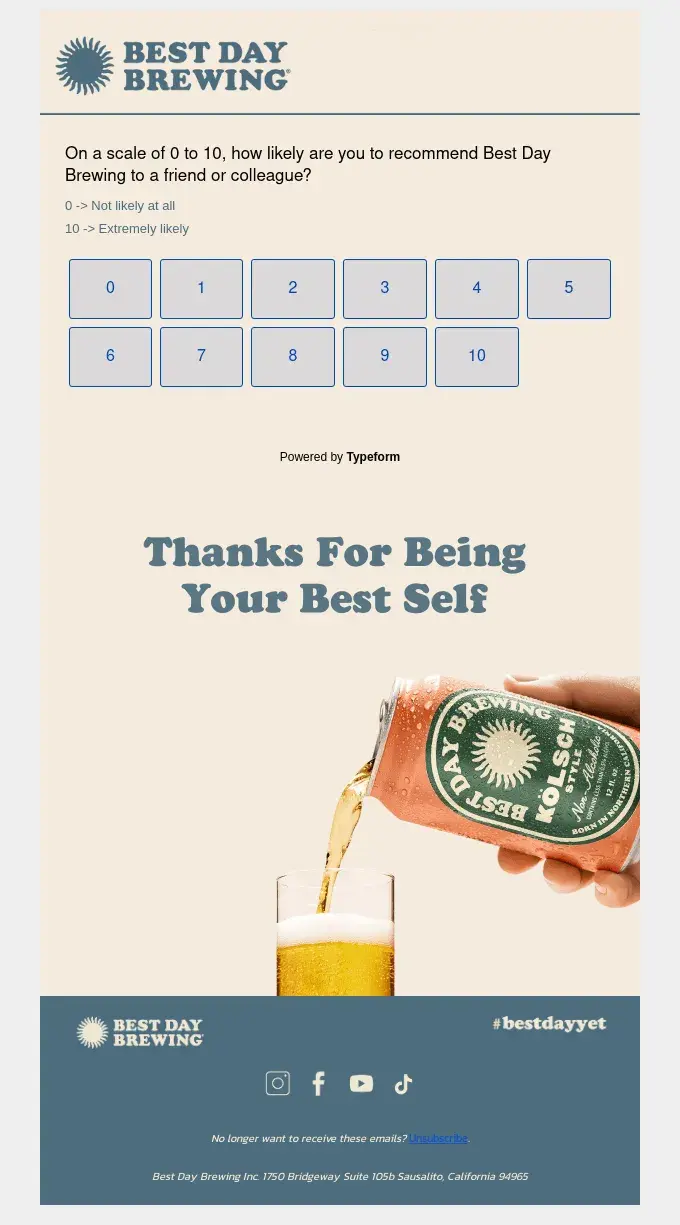
Final Thoughts
The world (okay, my inbox) would be a better place with more intentional use of email marketing. Let’s all do the secret marketer’s handshake 🤝 and agree to be brief and intentional with people’s inboxes.
It’ll save us ALL some time. And increase the likelihood of people responding to your surveys.
Even the best surveys can go unnoticed if they don’t have the support of a strong survey email subject line. Use the tips and examples in this article to get the most out of your next survey.
Editor’s note: This post was originally published in February 2023 and has been updated for comprehensiveness.
![]()
I Dove Deep Into the 10 Best Customer Engagement Platforms (and Found Out How to Choose One)
Businesses live and die on their customer relationships, but engaging customers effectively is a heavy lift. Customers expect personalized help, immediate responses, and an all-knowing understanding of past conversations. If you’re asking yourself, “How do companies do it?!” I have a simple answer for you. […]
ServiceBusinesses live and die on their customer relationships, but engaging customers effectively is a heavy lift. Customers expect personalized help, immediate responses, and an all-knowing understanding of past conversations. If you’re asking yourself, “How do companies do it?!” I have a simple answer for you.
They use a customer engagement platform — it changes everything about the customer (and internal team) experience. But before you can engage customers better, you have to sort through dozens of platforms and choose one for your business.
Table of Contents
What Is a Customer Engagement Platform?
A customer engagement platform is software that helps businesses manage customer interactions successfully. Basic features include messaging channels and help ticket resolution. Advanced platforms combine customer service tools with artificial intelligence (AI) and customer data analysis to improve customer engagement. With a customer engagement platform, it’s possible to manage complex customer relationships en masse.
How I Tested the Best Customer Engagement Platforms
Like all SaaS tools, customer engagement platforms come in different shapes and sizes. After hours of research, review, and testing, here are the criteria that I used to evaluate the most popular customer engagement platforms:
- Price. It’s not just a number. Access to customer engagement tools is determined by the price. Scalable pricing catering to both small businesses and enterprise companies is a plus.
- Features. Each platform has dozens or hundreds of features; I looked for the basic boxes to be checked, then examined the features that are unique and noteworthy.
- AI Integration. AI has become synonymous with customer engagement. I evaluated how AI is integrated to help save time and improve customer satisfaction and user experience.
- Reviews. How satisfied are current customers? It’s the elephant in the room when you’re making a software purchase. I’ve read reviews for all these customer engagement platforms and will give you the gist.
10 Best Customer Engagement Platforms
The number of platforms on the market is overwhelming. You don’t have to drown in the endless lists of features, customer reviews, and statistics — board my life raft, and I’ll give you the overview you need to see where each platform shines.
1. HubSpot Service Hub
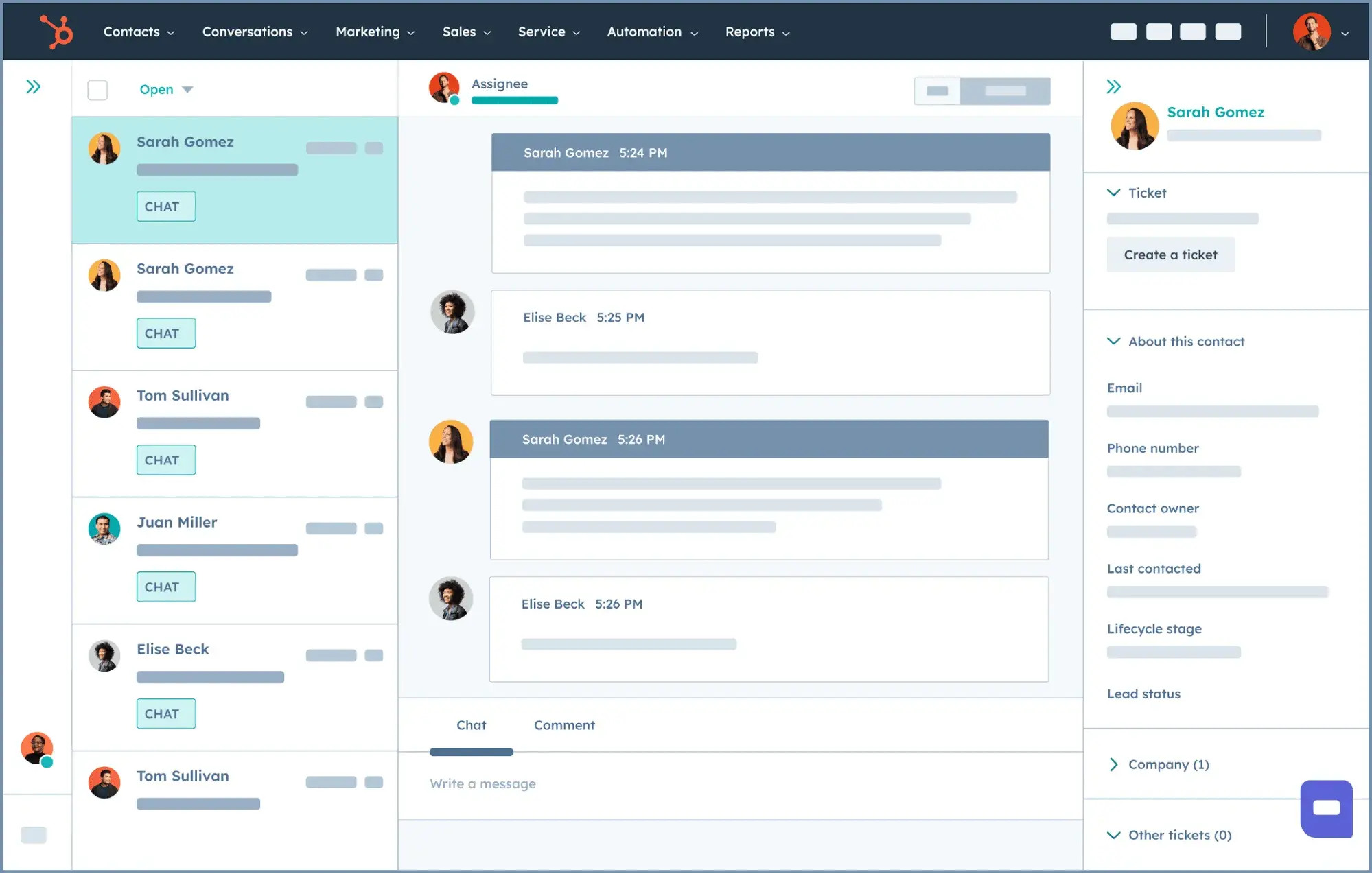
HubSpot Service Hub is a platform that handles everything from basic customer support requests to complex customer interactions. You can easily switch between messaging channels, like email and live chat, in the simple in-app messaging platform. Your resource center, meetings, and other customer support resources are all integrated, and you prioritize enhancing customer satisfaction with built-in service level agreements.
Price: Free plan, then $20 per month.
Key Features
- Advanced customer help desk support.
- Customer calling.
- Knowledge base.
- Messaging capabilities.
- Built-in AI.
- Integration with HubSpot CRM (our beloved customer relationship management tool).
AI Integration: Built-in AI automatically tracks and updates customer ticket status based on your interactions. You can leverage AI in other helpful ways, like writing a message to a customer and then asking AI to change the tone (for example, making your message more professional).
Reviews: Customers love the engaged support that they receive from the HubSpot support team when they call or have a support ticket. This has been my experience as a HubSpot customer as well — even when using free products, you get an immediate response from a human. Customers also love the ease of use, while some wish it had more features.
What I like: I test a lot (a LOT) of SaaS tools and the ease of the HubSpot Service Hub is above and beyond. The focus on rapid onboarding makes it the most user-friendly customer engagement software.
2. Salesforce Service Cloud
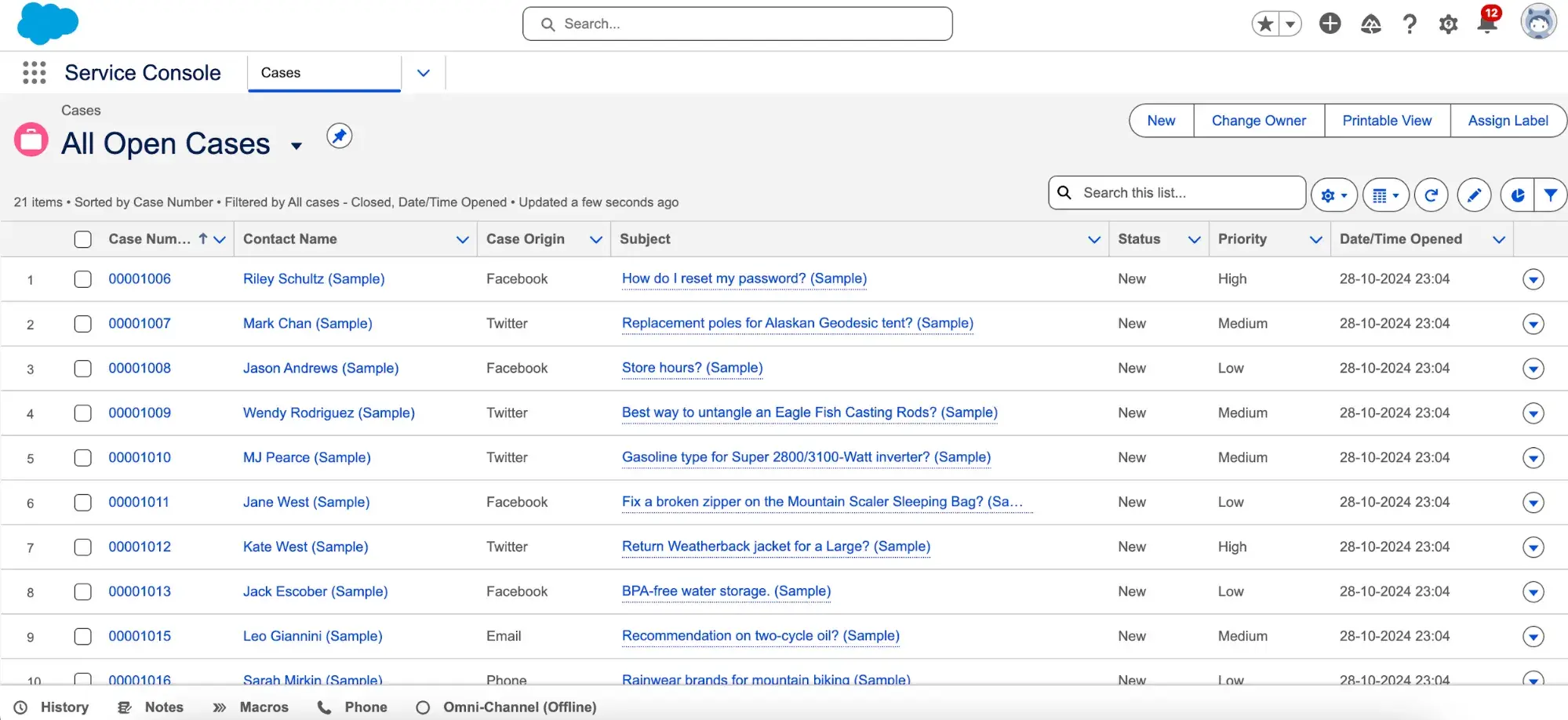
While this platform is technically a CRM, Salesforce itself says that a CRM can serve as a customer engagement platform when it integrates customer engagement tools. The integration between email, social media messaging, WhatsApp, chatbots, and more provides a really complete picture of customer communication touchpoints. All of these engagements are funneled into the Service Cloud, where you can quickly manage customer interactions.
Price: Try it for free, then pay $25 per user/month.
Key Features
- Mobile app for field service reps.
- Omnichannel messaging.
- Customer service routing automation.
AI Integration: Salesforce’s generative AI bot, called Einstein, has a wide range of functions, including text messaging response. AI is also used to help customer service reps navigate internal knowledge bases faster, shortening response times.
Reviews: Customers rave about the diverse applications but some say it’s easy to get lost in the endless features and settings of the platform. That’s been my experience as well.
What I like: The platform is undoubtedly powerful, but I echo some of the customer reviews that the interface feels clunky.
3. Zendesk Support Suite
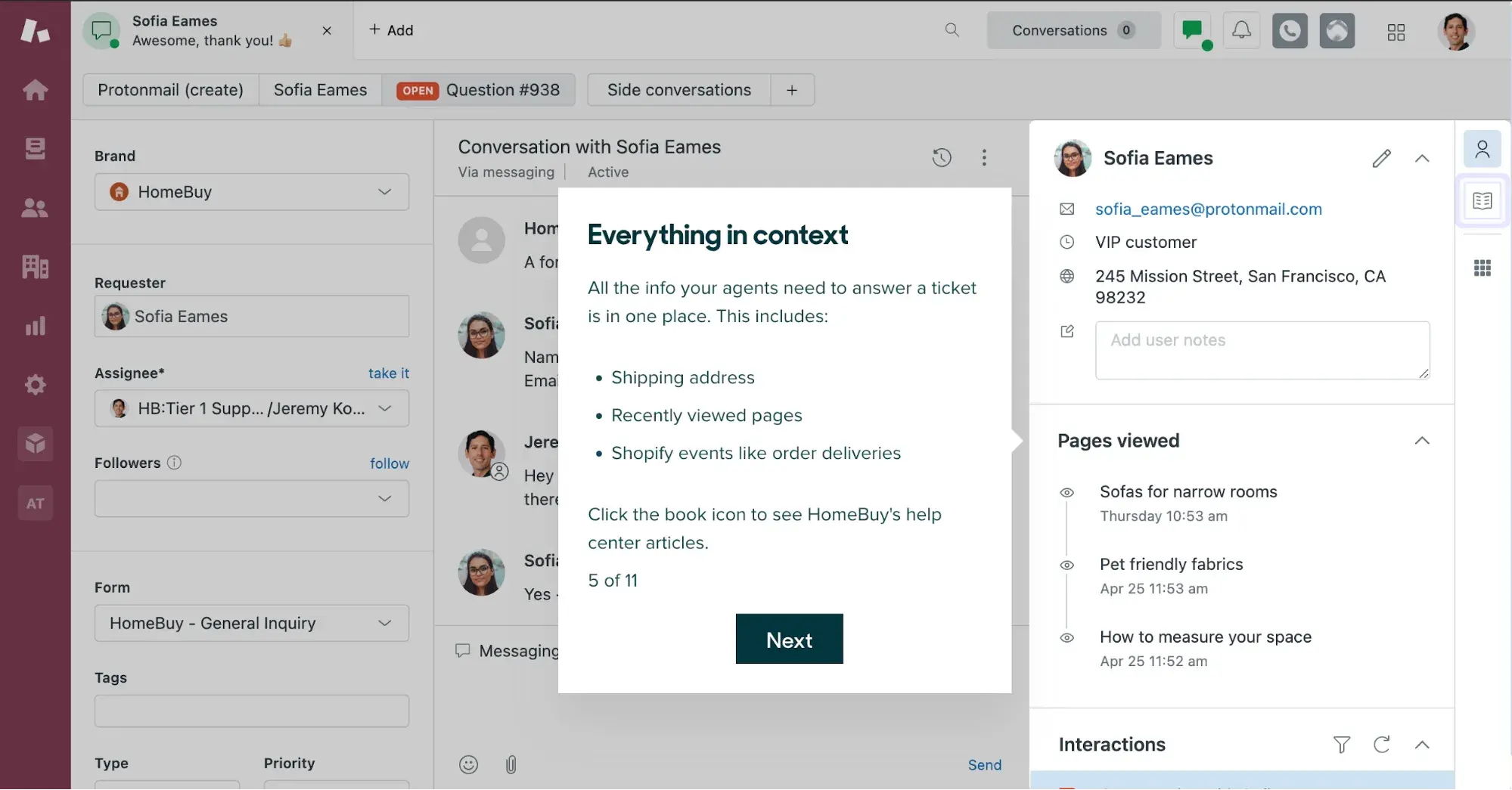
Zendesk Support Suite is an AI-driven customer engagement platform that integrates diverse communication channels into one dashboard. While all customer engagement platforms manage help tickets and calls, Zendesk Support Suite also manages comments on community forums. When customers reach out on multiple channels, all communication is condensed into one help ticket to save your customer service team’s time.
Something I like is the onboarding process. New customers answer a few questions about their company and then are onboarded based on their needs. Then, you’re given an account setup checklist and a guided walk-through.
Price: Free trial, then $19 per month when billed annually.
Key Features
- Thorough communication channels like messaging, live chat, and voice.
- AI-integrated agent workspace and help center.
AI Integration: AI is deeply embedded in the Zendesk Support Suite, both on the front-facing customer side and the internal agent side. Customers’ tickets are resolved more quickly with AI support that takes previous interactions into account while processing queries. The copilot AI feature proactively gathers customer information to brief agents before they even begin their customer interaction.
Reviews: Users love how customizable this platform is but wish that it had more features.
What I like: I like how customizable and modern the platform is. Zendesk really prioritizes the user experience and that speeds up onboarding and personalizing the platform to your business.
4. Freshdesk
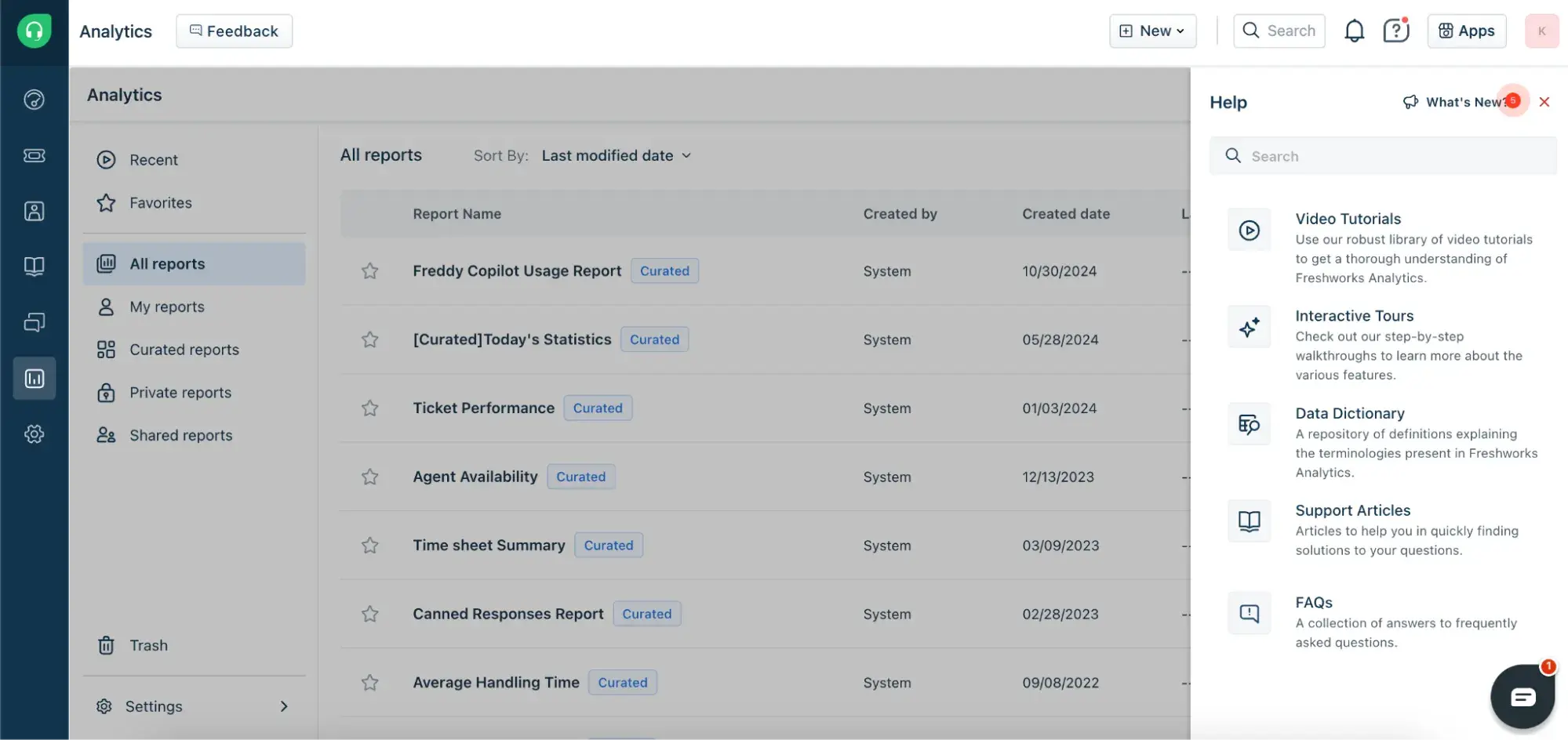
Freshdesk by Freshworks is a customer engagement platform that boasts fast onboarding and minimal training required to help your team hit the ground running. This intention comes through right away when you sign up — you start with a guided setup, and then you’re invited to a live hands-on training with staff that helps new users set up their accounts.
I think Freshdesk is great because it integrates with more than 1,000 other tools, scales as your business grows, and has a detailed ticketing system.
Price: Free plan, then $15 per month billed annually.
Key Features
- Advanced support ticket management.
- Streamlined agent space.
- Real-time analytics to provide immediate data insights.
AI Integration: Freshdesk AI aims to reduce agents’ time spent on email, using generative AI to help respond to tickets, assess tone, and edit. Emails can be generated with just a few keywords. Customers also benefit from AI via chatbots and automated routing to get assigned to an agent more quickly.
Reviews: Customers enjoy that Freshdesk is simple and easy to use, with many features available, with some complaints of the platform being slower than others and having less control over platform customization.
What I like: Freshdesk checks the technical boxes like similar tools, but I really like the addition of Freshdesk Arcade. This is a gamification system that awards points to agents as a way to encourage and energize repetitive tasks. I think it’s a brilliant approach to making a customer engagement platform enjoyable for the internal team.
5. Tidio
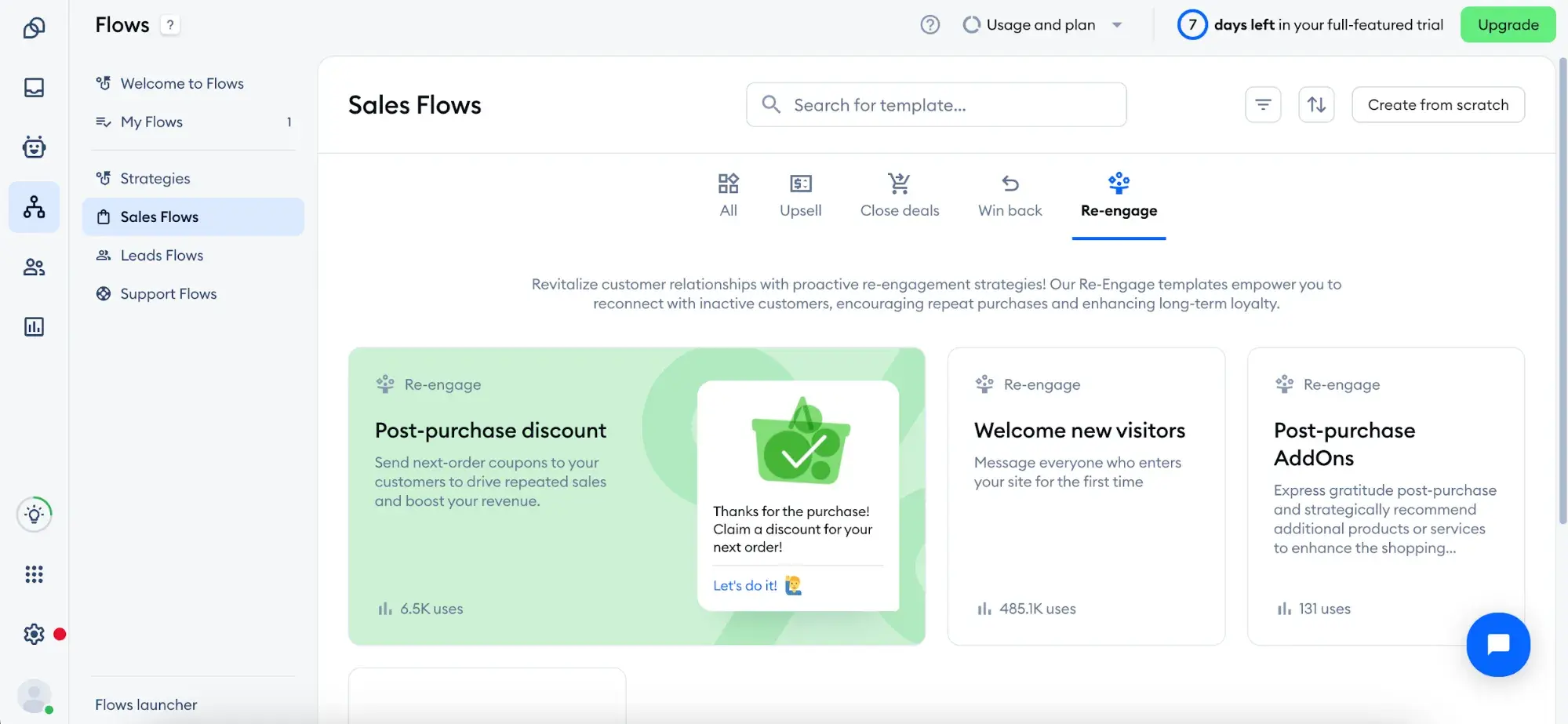
Tidio is a user-friendly customer engagement platform that was designed for ease of use; they even say that you can get it up and running within five minutes! I think they follow through on that promise — the interface is intuitive and guides you through creating your first chatbot.
The more advanced features naturally take longer to implement. The customer tracking feature generates insights into where each customer is at in the customer journey and what they need to engage and convert. Tidio integrates with 125+ tools, which is more restrictive than competitors (for comparison, Freshdesk integrates with 1,000+).
Price: Custom pricing for each company.
Key Features
- Advanced custom bots that are sales-oriented, such as an abandoned cart bot, first-time customer bot, and product recommendation bot.
AI Integration: Standard AI features are included, like AI chatbot and sentiment analysis. The chatbot feature is more robust and ecommerce-oriented than many other tools.
Reviews: Online reviewers love the onboarding ease but some say the platform is on the slower side, with some saying it slowed down their entire website.
What I like: I really like the “flows” feature. Flows are organized in your dashboard according to goals (upsell, re-engage, etc.), and you can see how many times certain flows have been used by other Tidio customers.
This makes me feel like I can easily follow in the footsteps of other big brands while I’m getting oriented, which is a really cool feature for small business owners who are wearing a lot of different hats and trying to make quick decisions.
6. Kustomer

Kustomer is a customer engagement platform acquired by Meta in 2023, which should make it no surprise that it has a heavy data focus. The data and functionality of the platform dive deep into the customer experience. I think it’s interesting that they actually built their platform around customer profiles instead of open tickets.
Price: Prices are customized to each company.
Key Features
- AI agents for customers.
- AI assistants for reps.
- CRM.
- Cross-channel communication consolidation.
AI Integration: Kustomer uses AI to enable fast, personalized interactions. Some customer support issues are handled completely by AI, such as simple inquiries, while customer service reps also get AI agents to assist them.
Reviews: Kustomer has fewer online reviews than other platforms, but the reviews are glowing. Reviewers love how easy it is to use and frequently say that they have no product complaints.
What I like: Customer data can be overwhelming, and I like that Kustomer focuses on making the data actionable. The interface is also simpler and more intuitive than some of the more expansive platforms.
7. Khoros
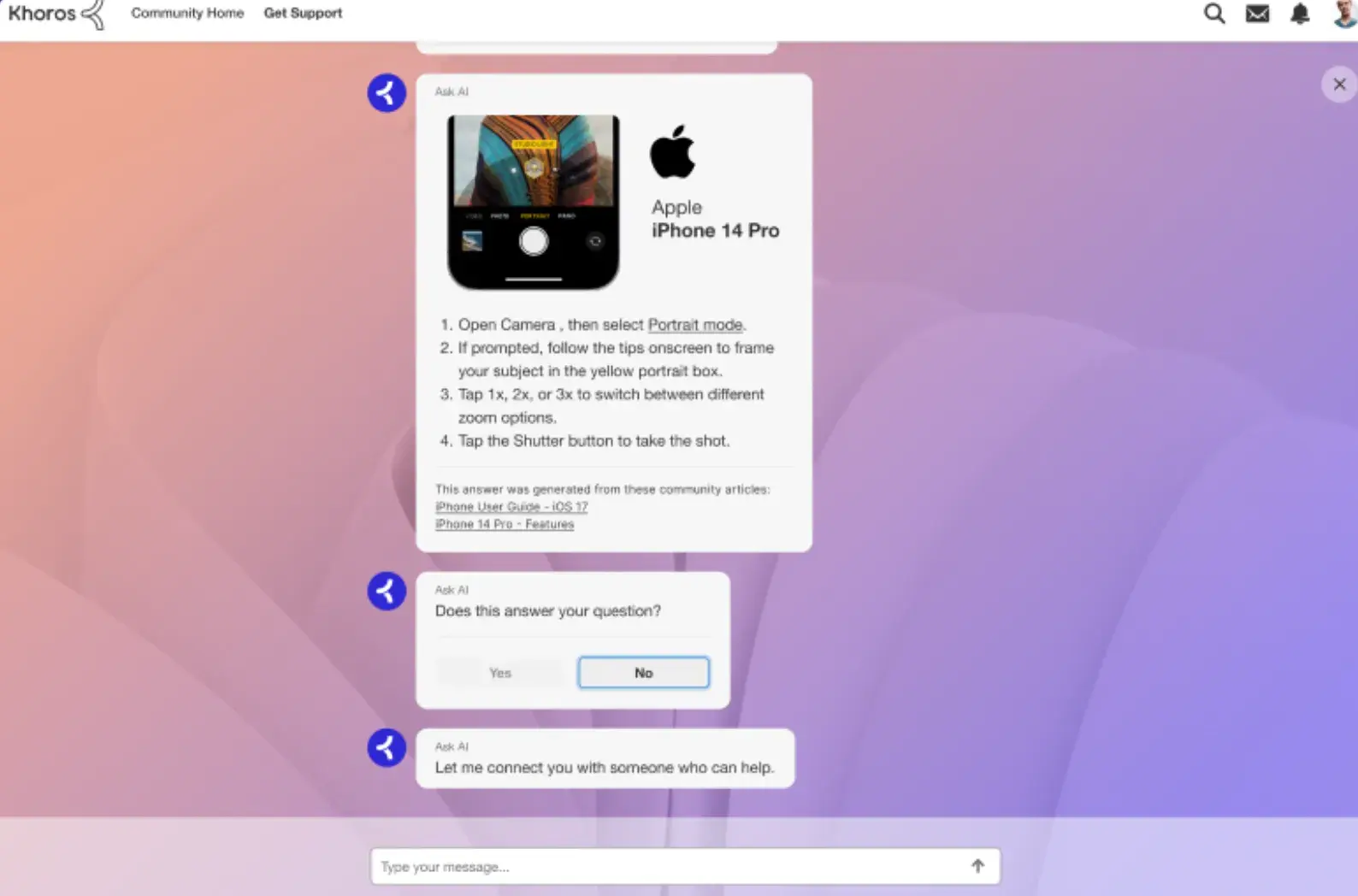
Khoros is a customer engagement platform that also serves as a social media management software that brings social listening into your reach. I like how this platform uses task prioritization, tagging, and routing to improve efficiency for communication across all digital channels and voice calls.
Based on the lack of free trial and a very underwhelming product tour, I was not sold on the value of Khoros until I saw the impressive roster of tech companies that use it, including Microsoft, Airbnb, and Zoom. These tech giants made me do a double take and look at what makes Khoros special.
Price: Pricing is customized to each company, but online reviewers mention that it’s pricey.
Key Features
- All standard features, such as self-service and agent assist, are covered by Khoros.
- A unique feature is Khoros Communities, which creates forums and rewards peer-to-peer interactions.
AI Integration: Chatbots, internal AI assistants, and all standard features are present in Khoros. This platform also offers AI to moderate your community forums, which is a unique feature (and very timely).
Reviews: Online reviewers like the powerful features of Khoros, but comment on the steep learning curve and the price. Likewise, I didn’t get the sense that this was a tool you jump into quickly without a time-heavy setup.
What I like: Community forums have had a resurgence in popularity (have you noticed all of the Reddit and Quora results on Google?), so I really like the advanced communities feature; it feels very forward-thinking. I think the gamification aspect for members, where they earn points for being active, is brilliant and has huge returns for companies that have chatty online communities.
8. Zoho
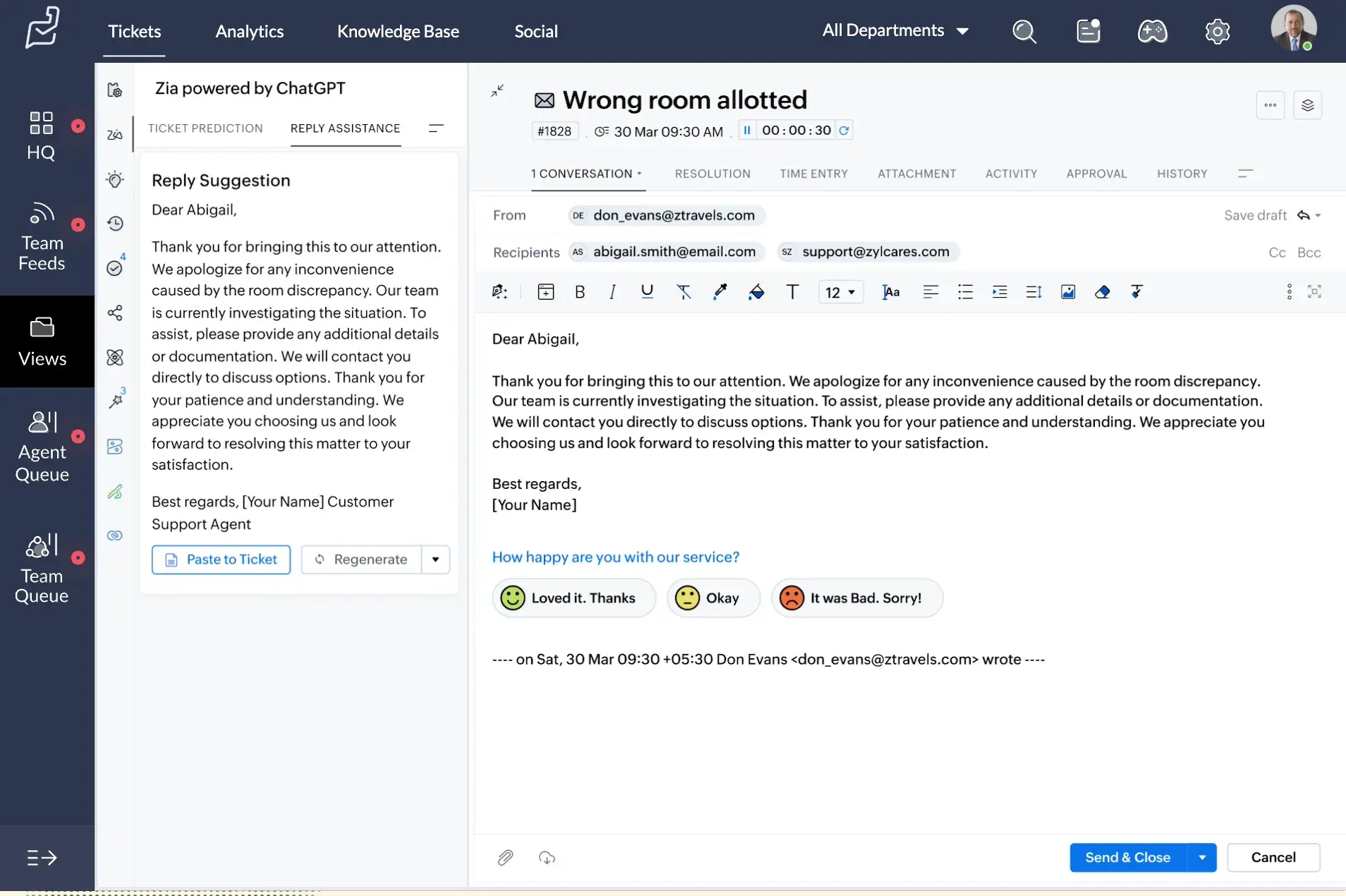
Zoho has dozens of applications, two of which merge to create a powerful customer engagement system: Zoho CRM and Zoho Desk. Zoho CRM focuses on attracting, tracking, and closing leads, and it integrates with Zoho Desk to fulfill customer support needs.
You can get both of these (and much more) with Zoho One, an umbrella subscription that encompasses all of Zoho’s applications in one massive customer engagement tool. Zoho’s logo includes building blocks, which I find is very representative of how the platform works.
Price: Zoho One pricing starts at $37 per month and scales with the number of employees.
Key Features
- Customer support ticketing.
- Privacy and compliance.
- Sales and marketing automation.
- Omnichannel communication.
AI Integration: AI is integrated throughout the entire customer journey and user experience — generative AI, chatbots, anomaly detection in data, and more.
Reviews: Reviewers are happy with the advanced functionality and tool integration, while complaints include the learning curve and customer support.
What I like: The onboarding process is undoubtedly intimidating, thanks to all of the applications and options, but those with the patience to set it up are rewarded with advanced functionality. My experience has taught me that more isn’t always better with software, so I don’t think this is the right fit for simple needs.
9. Intercom
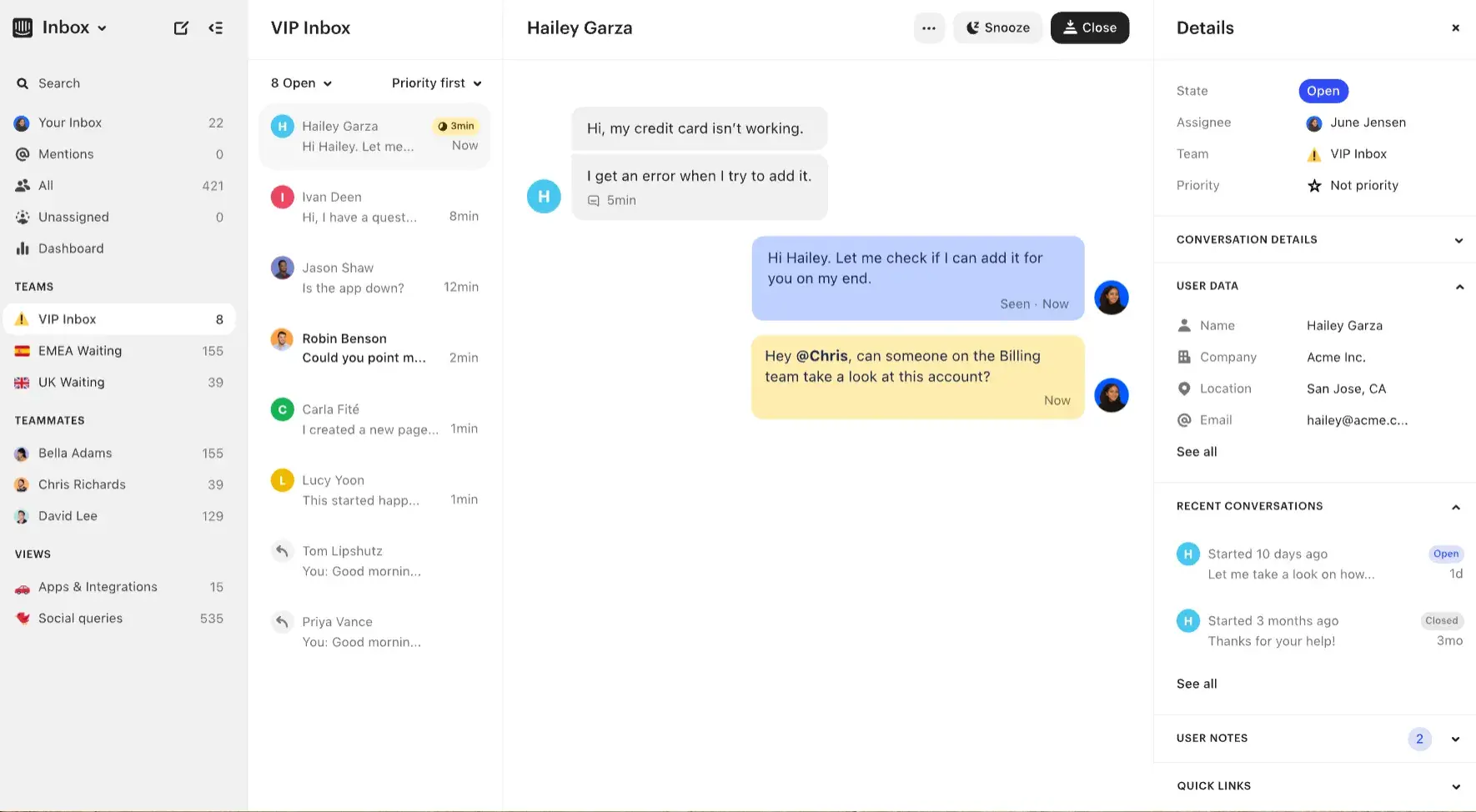
Intercom is a customer engagement platform with a focus on ease of use and robust communication. Users can easily switch between communication channels, going from chatting to voice calls to video calls to customer screen-sharing within the application. This is a unique feature that’s ideal for SaaS companies.
Price: Free trial, then $29 per month.
Key Features
- Inbox management.
- Help desk customization.
- Workflow design.
- Fluency in 25+ languages.
AI Integration: Intercom describes itself as an “AI-first” customer service platform, and has an AI agent for customers, an AI copilot for customer reps, plus an AI analyst generating recommendations for leaders.
Reviews: Intercom gets raving reviews. In G2’s 2024 customer satisfaction survey, Intercom had the highest scores in the help desk category.
What I like: Most tools focus on two user groups: customers and representatives. I like that Intercom also brings leaders into the conversation and makes it easy for them to understand the data and take action. They don’t assume you have an entire data department briefing you, which I appreciate as a small business owner.
10. Sprinklr Service
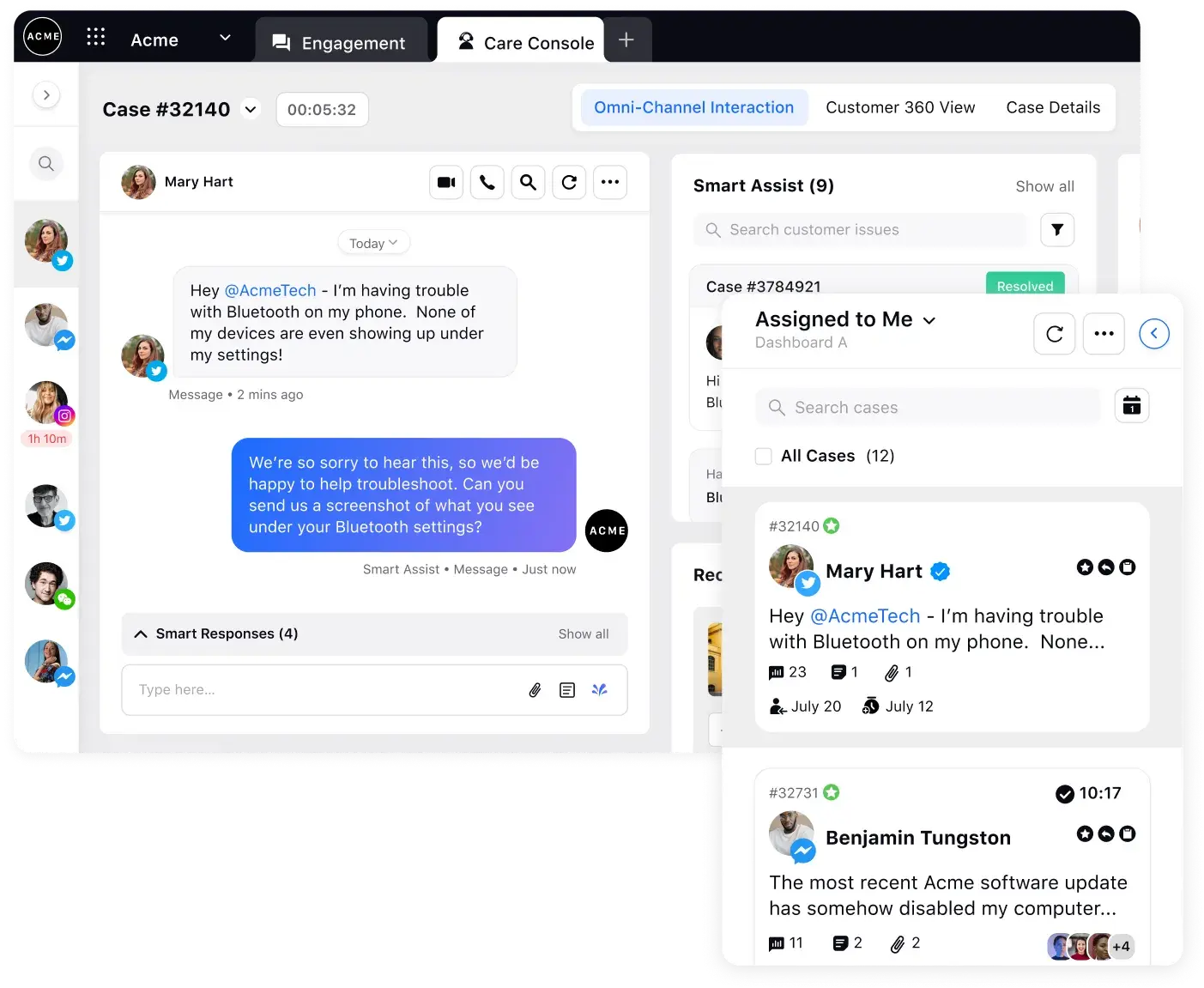
Sprinklr Service is an engagement platform that works to reduce customer support resolution times and costs. I like the focus on improving the internal team experience by creating a collaborative view, consolidating all customer contact points into one area so new agents can be briefed on complex customer relationships immediately. This also improves customer service, working hard so that customers never need to repeat themselves.
Price: Free trial, and then $199 per month when billed annually.
Key Features
- Multilingual support.
- Monitoring for irregularities and trends.
- Chatbots.
- Agent assistance.
- Advanced reporting.
AI Integration: AI is used for all standard features (automation, sentiment analysis, etc.), as well as quality monitoring. This is a unique feature that I think adds a lot of value to companies that are trying to recover from poor customer satisfaction ratings.
Reviews: Existing customers like the robust features and the ease of use, but slow load times and software bugs were top complaints. I second this, because I experienced bugs while testing — I followed their steps to sign up for a trial and was immediately hit with an access denied page and this message: “Welcome to Sprinklr! Looks like the app for which you have permission is disabled by the admin.”
What I like: All platforms provide reporting, analytics, and AI, but I really like the specific application of combining these into the quality monitoring feature.
Making Moves for Your Customers
There’s a lot of money on the table when it comes to engaging customers, and customers keep expecting more and more. Thankfully, with the tools on the market and their rapidly evolving capabilities, companies are able to meet those high expectations at scale.
I hope that my walk-through of the most popular platforms makes their similarities and differences easier to understand — and easier for you to choose the right platform for your team.
![]()
A Beginner's Guide to Customer Behavior Analysis
You probably know your best friends well — their likes, dislikes, where they shop, why they prefer certain brands, and even what they’d buy before walking into a store. Wouldn’t it be great to know your customers this well, too? What are their shopping preferences? […]
ServiceYou probably know your best friends well — their likes, dislikes, where they shop, why they prefer certain brands, and even what they’d buy before walking into a store.
Wouldn’t it be great to know your customers this well, too? What are their shopping preferences? How often do they shop? How do they prefer to contact you? And the list of questions goes on …
Enter customer behavior analysis. The science of understanding what goes through your customers’ minds, how they engage with your product, and how they respond to a social media advertisement.
In this article, I’ll take you through how to perform a customer behaviour analysis, its importance, and how using the right data can improve revenue and customer lifetime value.
In this piece, we’ll cover:
- What Is Consumer Behavior?
- Consumer Behaviors That Impact Sales [New Data]
- What Is a Customer Behavior Analysis?
- How to Conduct a Customer Behavior Analysis
- 3 Customer Behavior Analytics Platforms
Customer behavior doesn’t describe who shops in your stores but how they shop there. It reviews factors like shopping frequency, product preferences, and how your marketing, sales, and service offers are perceived.
Consumer behavior doesn’t merely rely on one aspect. Instead, it is derived from various factors, including psychology, biology, and economics.
For instance, economic factors such as their allocated budget and how they want to leverage the resources within this budget.
Based on my experience in data analysis, here are the factors that most businesses consider.
Factors That Affect Customer Behavior
Personality Traits
A customer’s behavior in your store is heavily influenced by their personality, background, and upbringing. Some will be jovial and outgoing, others quiet and collected, and some will fall in between.
Similarly, a customer may like a long product walkthrough and specialized onboarding, whereas other customers may get frustrated with the long product demos.
I’ve found that understanding where your target audience lies in this category is vital to understanding customer behavior.
Psychological Responses
Psychological responses can be challenging to predict, but they play a significant role in customer behavior because someone’s response to a situation is based on perception and attitude, which can change daily.
For example, say I got a promotion, I’m having a celebratory dinner, and my server accidentally spills a glass of water on my shirt. I might be more forgiving in this instance because I’m in a great mood and having a good day. However, if I was just fired from my job, I might be more frustrated with the situation.
Customers can be patient and satisfied one day, but the next, they’re pressing your rep on an urgent issue. Understanding that a customer’s psychological response doesn’t represent who they are as a person can help your team defuse stressful situations and prevent potential churn.
Social Trends
Social trends are external influences that customers listen to, like peer recommendations, societal norms, or fads. Some of these influences can be temporary, but others can affect customers permanently.
I’ve just gone over some examples of factors influencing customer behavior; now, let’s discuss some data-backed examples of consumer behaviors that directly impact customer service.
Consumer Behaviors That Impact Sales [New Data]
I think a great, real-life example of how consumer behaviors impact sales is the ways that different audience segments prefer to discover new products from the businesses they purchase from. The HubSpot Blog’s 2024 Consumer Trends Report asked 700 U.S. consumers about their preferences and the actions they take because of them.
It revealed that social media is the future of commerce. In 2024, Gen Z and Gen X have discovered more products on social media than any other channel.
The following image gives generation-wise data on product discovery on social media:
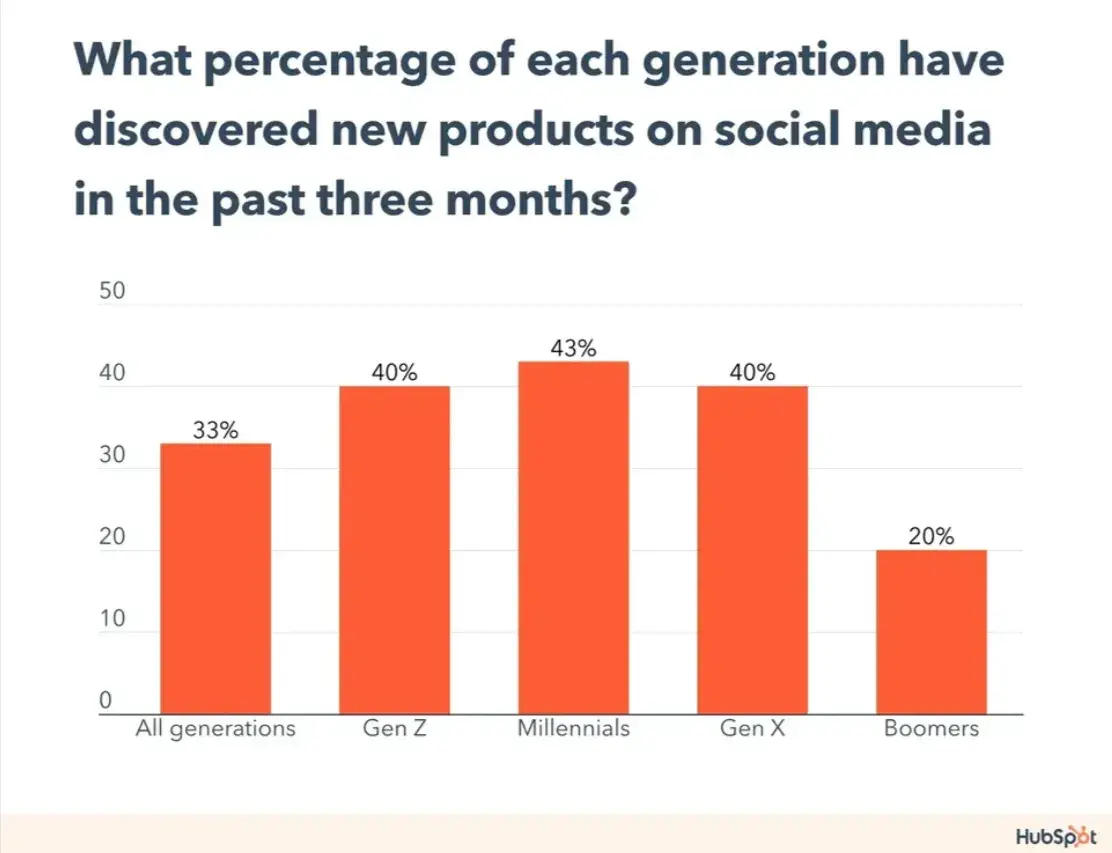
Moreover, 25% of social media users prefer buying on social media this year, with Gen Z and millennials being the most active ones.
Also, 21% of the 700 respondents believe that influencer recommendations have impacted their buying decisions. Despite the number of social media channels, Facebook still remains the most trusted social media platform for the shoppers.
Now that I‘ve outlined customer behavior and how it impacts customer buying habits, let’s learn how to analyze it in the section below.
What Is a Customer Behavior Analysis?
A customer behavior analysis is a qualitative and quantitative observation of how customers interact with your company. You begin by segmenting customers into buyer personas based on their shared interests. Then, observe each group at their respective stage in the customer journey to see how the different personas interact with your company.
I think this analysis is valuable because it gives insight into the variables that influence your audiences and the motives, priorities, and decision-making methods customers consider during their journey. It also helps you understand how customers feel about your company and if that perception aligns with their core values.
Consumer behavior analysis is based on certain frameworks or, say, consumer behavior models, that help create the shopping patterns and how consumers make purchase decisions.
Why is customer behavior analysis important?
I think customer behavior analysis provides an edge to businesses over their competitors since they have granular details about their customers and their buying patterns.
Here are more reasons why I think customer behavior analysis is important for businesses:
Identify Behavioral Patterns
It’s likely that your customers have something in common with one another (which is why they are your customers). By identifying their patterns of behavior, businesses can tap into a large segment of customers with a common trait.
In fact, a Salesforce survey of over 6,000 consumers found that 66% of them expected companies to understand their needs and expectations, and a Redpoint Global survey found that 82% of respondents expect businesses to accommodate their preferences and meet their expectations.
For example, Starbucks’s consumer behavior strategy is rooted in understanding its customers’ personal, cultural, and social backgrounds. This way, Starbucks caters to its customers’ needs, such as understanding their local tastes and modifying its offerings accordingly.
Content Personalization
Research by Nojitter suggests that 56% of consumers will become repeat buyers after a personalized shopping experience. Understanding customer behavior helps you create targeted content and craft your product or service better than your competitors.
Again, I find you can use the patterns to segment your customers and create a unique personalized experience for each segment. Collecting customer feedback is yet another successful strategy that most businesses adopt for content personalization.
You might’ve even seen the survey from YouTube at the start of a video. YouTube uses this data to improve its search engine and suggest more personalized content.
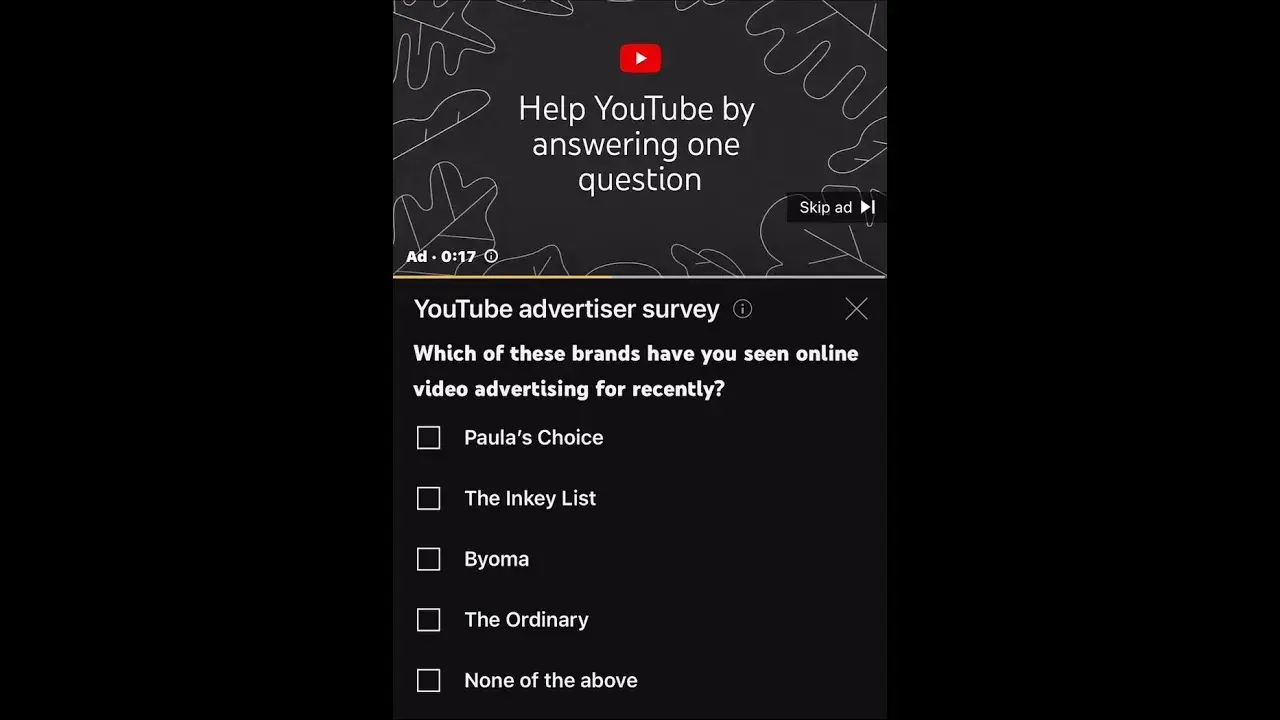
Customer Retention
What keeps your customers coming back? What do they like, and what do they want to improve in your product? Are there any missing features that your existing customers want? Customer behavior analysis gives answers to these questions all at once.
It provides deeper insights into what your customers like and what they don’t. A behavior analysis can help your team reduce this customer churn by identifying good and bad customer traits.
Improve the Buyer’s Journey
The results you obtain from customer behavior analysis can be phenomenal in shaping your customer journey. It helps you identify the optimized experience for customers and how to deliver it.
Optimizing the customer journey means reducing the roadblocks, improving areas of confusion, and enhancing the aspects you already do well. For example, if most of my customers pay using credit cards, I can use this insight and suggest credit cards as the preferred payment method every time customers check out.
Or, say, my customers often buy two products together; bundling them together can reduce their efforts to perform searches and drive more sales.
How to Conduct a Customer Behavior Analysis
1. Segment your audience.
The first step to a customer behavior analysis is segmenting your audience.
Key segmentation models are demographic segmentation (age, gender, etc.), psychographic segmentation (personality, values, etc.), geographic segmentation (country, town, etc.), and other behaviors like frequent actions and product use, preferred media channels, and online shopping habits.
You’ll also want to identify the characteristics of customers that are the most valuable to your business. One way to do this is through an RFM analysis, which outlines how recently a customer has purchased from you and how frequently they purchase from you.
2. Identify the key benefit for each group.
Each customer persona will have a unique reason for choosing your business, and it’s imperative to identify it. I suggest you look beyond the product or service and consider the external factors influencing the customer’s buying decision.
For example, was it a purchase of convenience? Or did they make a conscious decision to seek out your brand? How urgent was the purchase, and how much do they want to spend? I’ve found thinking about the context of customers’ needs is a great way to determine areas to improve the customer experience.
Since qualitative data is crucial to your customer behavior analysis, read about how you can better segment your customer base using customer profiling.
3. Allocate quantitative data.
Some resources may be more accessible than others, and I believe it’s important to derive information from both internal and external sources to ensure you get a complete picture of both micro and macro consumer trends.
From within, your company can pull stats such as blog subscription data, social media insights, and product usage reports. Secondary outlets can offer assets like consumer reviews and competitor analytics. Third-party data isn‘t specific to one company but provides general statistics across an entire industry. Through the combination of the three, you’ll have a broad scope of information to work with when analyzing customer behaviors.
4. Compare your quantitative and qualitative data.
After you’ve collected your data, the next step is to compare the qualitative data against the quantitative.
To do this, go through your customer journey map using the data sets as a reference. Look at which persona bought what product, when they bought it, and where. Did they return for another visit? By comparing the two sets of data against the customer experience, you can develop a detailed understanding of your customer’s journey.
Comparing data should help you identify recurring trends. I encourage you to look for common roadblocks that seem to pop up at different lifecycle stages and note any unique behaviors specific to a customer type. Circle back to your high-value customers and flag anything that stands out with their buying behaviors.
5. Apply your analysis to a campaign.
As I discussed earlier, you can use your findings to optimize your content delivery. Pick the best delivery channel for each persona and take advantage of opportunities to personalize the customer experience.
Nurture customers throughout the entire customer journey by responding to roadblocks on time. The insights you’ve gained from conducting your customer behavior analysis should give you a good idea of where to make updates to your marketing campaigns.
Before rolling out your new initiatives, I suggest you use your analysis to determine what your customers will think about these changes.
Customers are habitual creatures, and some will push back on change, even if it’s for the better. These customers tend to be more loyal to your brand, so you must do your best to keep them. Consider different ways to introduce change to these customers, and remember to be receptive to their feedback.
6. Analyze the results.
Once you‘ve given ample time for testing, you’ll probably want to know if your changes worked. Use metrics like conversion rate, acquisition cost, and customer lifetime value to determine the effect of your updated campaigns.
It‘s important to continuously analyze your results as new tech, politics, and events constantly influence customer needs. I find revisiting your analysis frequently ensures you capture new trends in the customer’s journey.
Looking for some help with conducting your analysis? Check out these platforms, which I think are great for analyzing customer behavior.
3 Customer Behavior Analytics Platforms
1. HubSpot
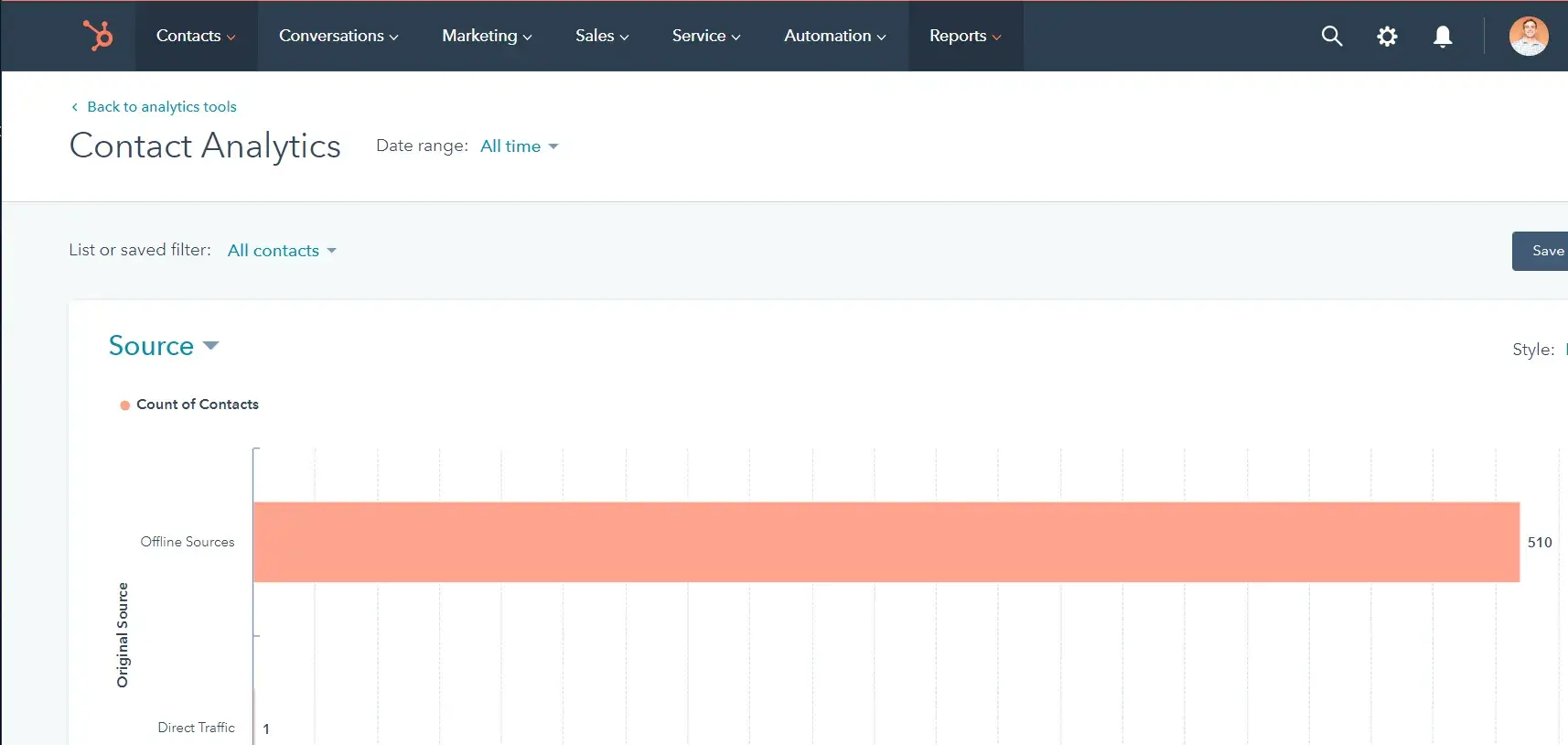
As a former HubSpot support rep, I spent the last year working closely with HubSpot‘s analytics platform. HubSpot’s reports and CRM features provide unique insight on both customer characteristics and engagement activity.
You can use its reporting tools to view web traffic for contacts and build lists based on their engagement history. HubSpot even offers an automatic attribution function that applies characteristics or scoring attributes once a contact completes an action.
Price: Starts free; up to $3,200/month.
2. Alteryx
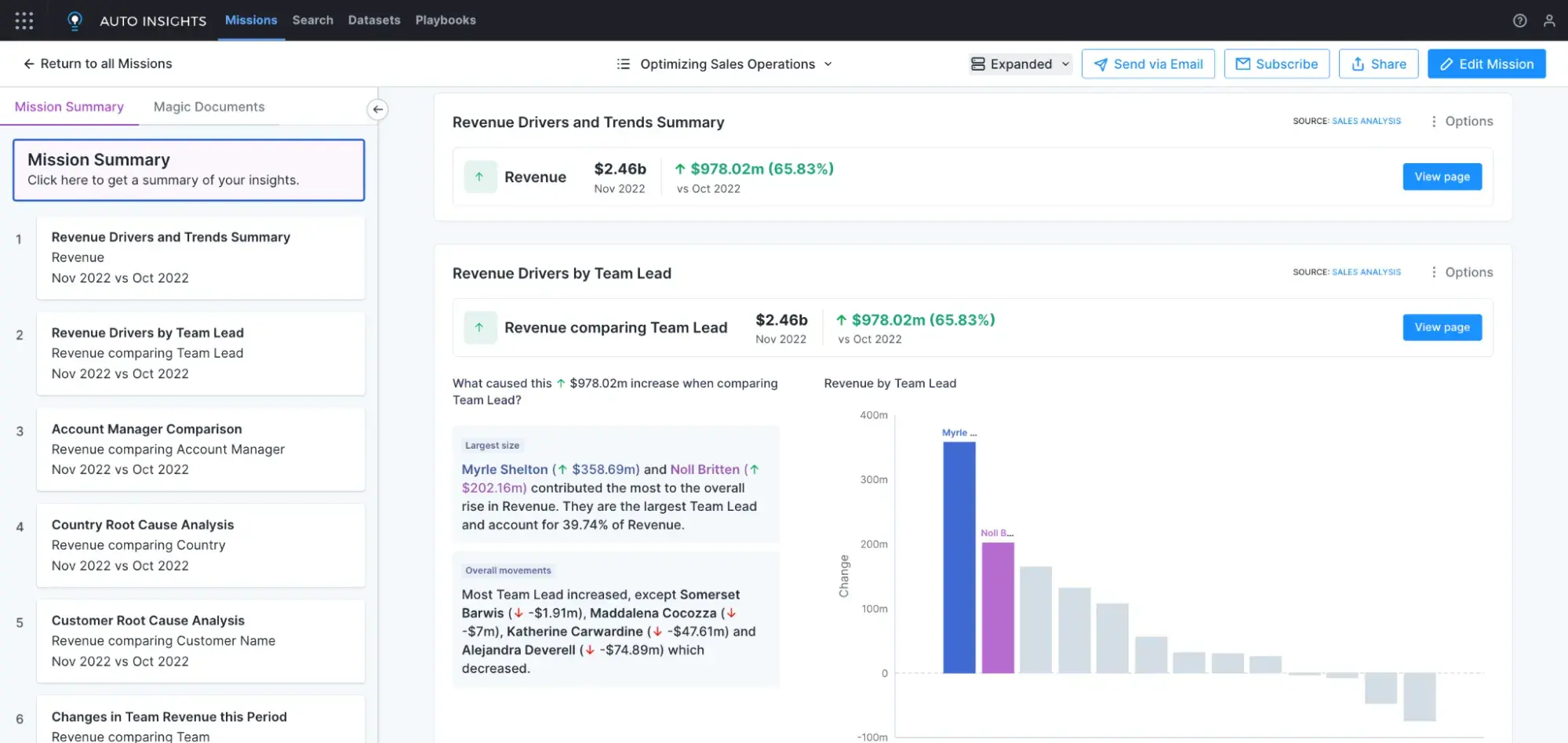
Alteryx’s analytics platform features an in-depth analysis of your customer data powered by insights from AI. The tool creates an automated visual representation to make it easy to identify trends and outliers. It then evaluates the data, and makes predictions and suggestions for where you can improve your customer experience.
Price: Starts free; variable for premium tiers.
3. Opentext Vertica
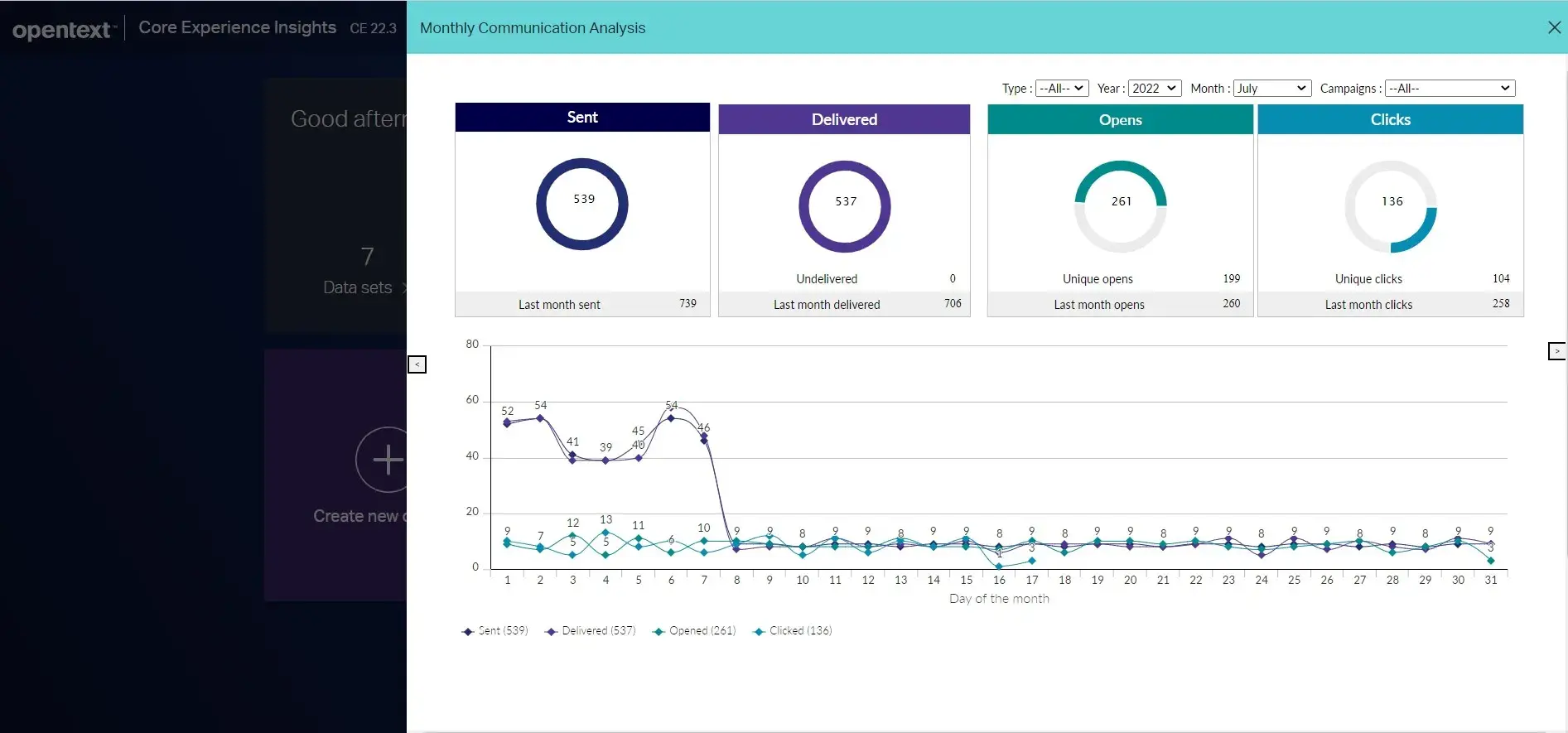
Opentext Vertica is ideal for processing high-volume data requests coming from a range of resources. The tool takes advantage of underused servers in your data center to create a speedy and cost-effective organization of your data. This lets you upload more data on your customers without sacrificing any time. Opentext can also sync to Google and Microsoft cloud servers to ensure all data is stored in one location.
Price: Starts free; variable for premium tiers as reported by G2 Crowd.
Getting Started
With a customer behavior analysis, your business strategy no longer has to be a guessing game. By surveying your customers and analyzing the quantitative and qualitative data you collect, you can be sure to better reach each segment of your audience, meeting their needs in marketing, sales, and service.
My takeaway is that by analyzing customer behaviors you can both better serve your clients and increase the success of your business.
Editor’s note: This article was originally published in December 2018 and has since been updated for comprehensiveness.
![]()

75 Catchy Referral Slogans & How to Write Your Own
One of the biggest challenges brands face when implementing a referral program is grabbing their audience’s attention. Using a catchy referral slogan is a great way to capture interest and get people curious about your referral program. But crafting a truly effective slogan is more […]
ServiceOne of the biggest challenges brands face when implementing a referral program is grabbing their audience’s attention. Using a catchy referral slogan is a great way to capture interest and get people curious about your referral program.
But crafting a truly effective slogan is more than just stringing a few words together. It requires understanding your audience, highlighting the value proposition, and creating a sense of excitement.
I realized this early on in my career while working on various projects for a small events startup based in San Francisco. We initially launched our referral program with a rather bland slogan. It didn’t resonate with our target audience, and the results were underwhelming.
That’s when I realized the value of well-crafted referral slogans. We went back to the drawing board, brainstormed new ideas, and finally landed on some catchy ‘join us’ phrases. The impact was immediate — high-quality referrals increased, attendance and engagement soared, and the program became a key driver of growth.
In this article, I’ll share my insights and guide you through the process of creating referral slogans that truly resonate with your audience and encourage them to take action.
In this article:
- What Are Referral Slogans?
- 75 Catchy “Join Us” Referral Slogans
- How to Write a Catchy Referral Slogan
- Key Takeaways for Crafting Referral Slogans That Convert
75 Catchy “Join Us” Referral Slogans
Referral slogans can be the deciding factor in whether or not your customer decides to share your product or service with their friends and family. A strong referral slogan is short, memorable, and conveys a clear message.
I’ve compiled 75 catchy referral slogans, breaking down what I like about each of them.
Incentive-Driven Slogans
1. “Earn [Benefit] For Every New [Customer] You Refer”
What I like: This slogan directly communicates the reward, encouraging users to bring in more customers.
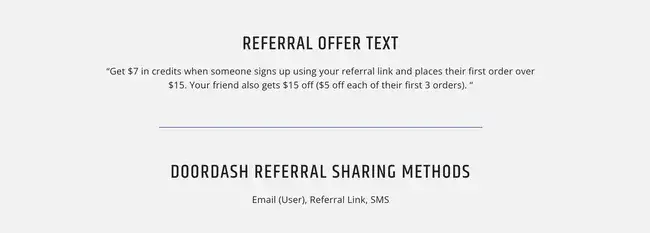
2. “Treat Yourself With Rewards”
What I like: I like that this slogan is short and easy to understand. It encourages customers to reward themselves using the referral process, which can be highly motivating and memorable.
3. “Earn Up To [Benefit] For Every Successful Referral”
What I like: The phrase “Earn up to” generates excitement by suggesting a high potential for a reward for the customer.
4. “Pass It On: Rewards Await”
What I like: This slogan is direct and encourages sharing with the promise of enticing rewards.
5. “Together Is Better: Refer And You Both Earn”
What I like: This slogan promotes community and provides mutual earning opportunities.
6. “Earn [$$] With Each Referral”
What I like: The direct mention of a financial incentive is likely to capture attention and motivate referrals.
7. “Refer & Win X”
What I like: This slogan is short, to the point, and clearly communicates the benefit of making referrals.
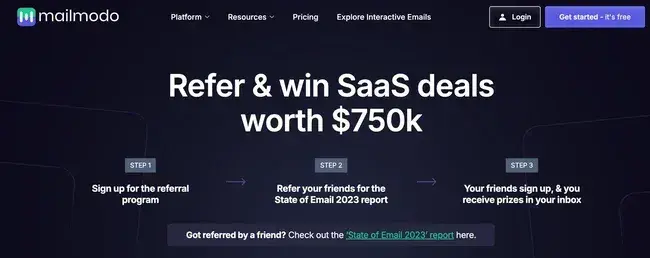
8. “Talk It Up – Refer One, Earn One.”
What I like: The rhythm and rhyme make this slogan catchy. It connects referring and earning, making the process sound simple and attractive.
9. “Pass It On, Cash It In”
What I like: This catchy phrase creatively conveys the referral program’s financial incentive.
10. “Refer A Friend And Earn Up to [$$]”
What I like: This directly communicates the benefits of referring friends for a financial reward.
11. “Share the Love, Reap the Rewards!”
What I like: This slogan effectively conveys the reciprocal nature of a referral program while maintaining a concise and memorable structure.
12. “Become a [Brand Name] VIP! Refer Friends and Unlock [Exclusive Reward]”
What I like: This leverages the concept of exclusivity and high social status to incentivize referrals. By positioning referrers as VIPs, it taps into a desire for recognition and special treatment, effectively motivating participation in the program.
13. “Refer, Earn, Repeat!”
What I like: Simple and action-oriented. It clearly outlines the cyclical process of the referral program, encouraging continuous participation and highlighting the recurring nature of rewards.
14. “Referrals = Rewards!”
What I like: This one employs a straightforward equation to communicate the direct correlation between referrals and rewards. It emphasizes the value proposition of the referral program.
Slogans That Spotlight Free Gifts
15. “Giving Away [Gift] For Every Referral”
What I like: The phrase “Giving Away” immediately captures attention. The promise of a gift or a kickback makes the offer more appealing.
16. “Spread the Word and Unlock Exclusive [Benefits]”
What I like: This slogan combines sharing with the enticement of exclusivity, inspiring users to participate.
17. “Friends Tell Friends – Free Gifts Await!”
What I like: The repetition and rhythm create a compelling call to action, emphasizing the bond of friendship.
18. “Share Now & Get a Free Month On Your Subscription”
What I like: This offers a valuable incentive of extended “Subscription” while creating urgency with the phrase “Share Now.” It also can help generate social proof as new users are provided with a success story accompanied by a call to action to try out your product.
19. “Share X, Score [Perks]”
What I like: This slogan uses playful wording to connect sharing with receiving free perks.
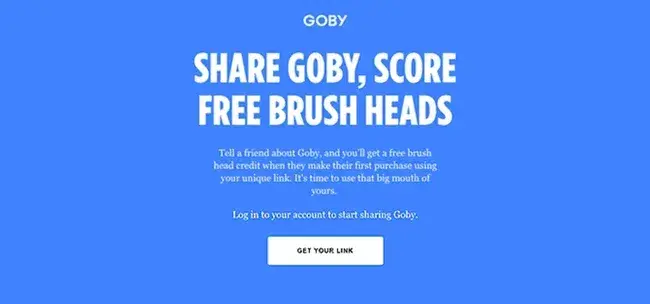
20. “Refer and Receive [Free Gifts]”
What I like: This slogan is straightforward, enticing users to refer other customers so they can receive “free gifts.”
21. “Share the Secret, Score Free [Goodies]!”
What I like: The word “secret” adds a touch of exclusivity to the brand, making users want to share it.
22. “Friends Never Let Friends Miss Out on Freebies!”
What I like: This slogan cleverly plays on the bond between friends and pushes people to share the “freebies” with others. It’s almost like a guilt trip to talk about your business with close friends and family.
23. “Connect & Collect – Free Surprises for Both!”
What I like: The rhyming words “connect & collect” make the slogan catchy and appealing to the user.
24. “Share and Shine With Free [Bonuses]!”
What I like: This slogan encourages sharing to receive free bonuses, making it more enticing for the user.
25. “Sharing is Caring, and It Comes with Freebies!”
What I like: The adaptation of the common phrase “sharing is caring” adds a relatable and positive connotation to the referral program. By connecting sharing with tangible rewards, this slogan incentivizes participation and emphasizes the benefits of spreading the word.
26. “Want Free Swag? Refer a Friend to [Brand Name]!”
What I like: The slogan’s direct and informal approach creates a sense of familiarity and excitement. Its concise structure ensures it’s easily digestible and memorable for potential referrers.
27. “Step into the [Brand Name] spotlight and shine with exclusive perks!”
What I like: It positions referrers as individuals who deserve recognition and “exclusive perks,” tapping into a desire for status and rewards. This approach motivates participation by associating referrals with positive outcomes and a sense of belonging within a select group.
Friend-Centric Slogans
28. “Sharing is winning. Bring a friend and win [$$].”
What I like: This slogan cleverly talks about how the user and their friends have the opportunity to win [$$].
29. “Get [$$] for Every Friend You Refer”
What I like: This slogan is direct and to the point, offering immediate clarity on the incentive.
30. “Give Your Friends X% Off”
What I like: This slogan is short and direct. It highlights the immediate value proposition, making it more compelling.

31. “Sharing with friends is always a great idea.”
What I like: This slogan appeals to the universal sentiment of friendship, promoting the idea that sharing is both fun and profitable.
32. “Refer Your Friends and Start Earning”
What I like: This slogan is straightforward and highlights the mutual benefit for both the referrer and the referred.
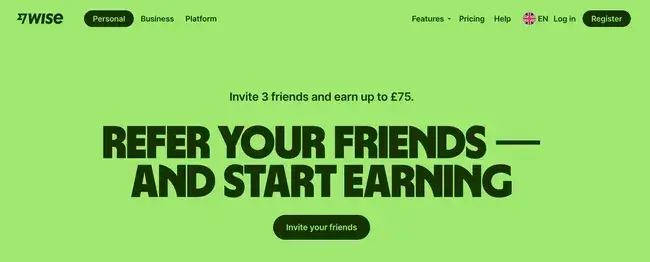
33. “One More Perk of Friendship”
What I like: This slogan adds a personal touch, highlighting there can be more perks of friendship when they participate in the referral program.
34. “Refer Your Friends: They Get [Benefit], You Get [Benefit]!”
What I like: This slogan is engaging and clearly explains the rewards for both parties.
35. “Because Friends Don’t Let Friends Miss Out”
What I like: This slogan evokes emotion and plays on the familiar saying about friendship, making it relatable.
36. “Bring a Friend, Both of You Win!”
What I like: This slogan’s straightforward promise of a mutual benefit is clear and enticing.
37. “Tell a Pal, Get a Deal!”
What I like: The rhyme and brevity of this slogan make it memorable and effective.
38. “It Pays To Have Friends”
What I like: This slogan is clever and highlights the financial benefit of having friends.
39. “Invite Your Friends & You Both Get $$ Off”
What I like: This slogan creates a win-win scenario, emphasizing mutual benefits for both parties.
40. “Share the Love, Share the Earnings”
What I like: By referring to the “love” that users have towards the brand, this slogan combines a sense of community with a financial incentive, creating a warm, inviting message.
41. “Got Friends? Get Rewards!”
What I like: It’s a playful and direct way to communicate the benefits of the referral program.
42. “Get [Benefit] By Inviting Your Friends To [Brand]!”
What I like: The direct call to action of inviting friends and a promise of a benefit make this slogan effective.
43. “Friendship is Rewarding! Refer a Friend and Earn Together.”
What I like: It emphasizes the benefits for both the referrer and the referred person, fostering a sense of shared reward and encouraging participation.
44. “Good Friends, Great Deals! Refer a Friend and You Both Save.”
What I like: By highlighting the potential for mutual gain, it incentivizes referrals and positions the program as a win-win for all parties involved.
45. “Friends Who Share, Care! Refer a Friend and You Both Win.”
What I like: It effectively leverages the power of social proof by implying that caring individuals participate in the referral program. It also creates a sense of shared benefit and encourages participation.
Creative Referral Slogans
46. “It pays to join [Brand]’s referral program.”
What I like: This slogan implies a financial gain for the user simply by joining this program, making participation seem straightforward.
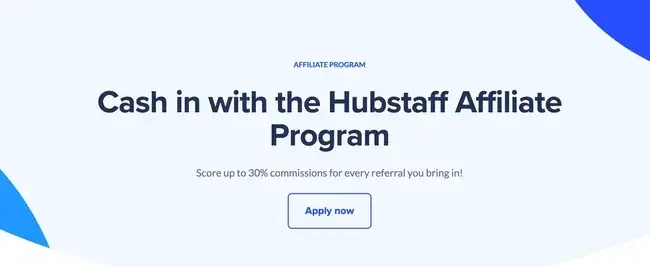
47. “Here’s an Easy Way To Show You Care”
What I like: This slogan taps into emotions and makes the referral process feel meaningful beyond mere financial incentives.
48. “This is Just Our Way of Saying Thanks”
What I like: Framing the referral program as a token of gratitude humanizes the brand and enhances trustworthiness.
49. “Spread The Love”
What I like: By tapping into values like love, this resonates widely and encourages sharing in a heartfelt manner.
50. “They Win, You Win, We Win. It’s a Win-Win-Win.”
What I like: The repetitive use of “win” makes the slogan catchy and emphasizes the shared success.
51. “Cash in on Connections”
What I like: This slogan cleverly plays on the dual meaning of “cash in,” suggesting both a financial gain and leveraging one’s network.
52. “The best compliment you can give us is a referral.”
What I like: This slogan highlights the value of appreciation and urges users to spread the word if they like the brand.
53. “Together We Thrive – Refer and Grow”
What I like: This slogan emphasizes collective growth that could foster a stronger brand and customer bond.
54. “Rewarding customers for their referrals is our love language.”
What I like: This take on meme-esque language brings a self-aware approach that’s purposefully wordy and witty — but also makes the customer benefit quite clear.
55. “You Share, We Care. Gift for Both!”
What I like: This slogan highlights mutual appreciation. Users share recommendations, while the brand reciprocates with gifts, fostering a sense of partnership and reward.
56. “Give [X], Get [Y]”
What I like: This is simple, catchy, and directly communicates the give-and-earn nature of the referral program.
57. “Because Sharing is Rewarding”
What I like: This ties into the age-old saying that “sharing is caring,” giving it a modern twist.
58. “A Treat for You, A Treat for Them”
What I like: The repeated structure and the promise of a win-win make this slogan appealing.
59. “Give Some, Get Some”
What I like: This slogan has a rhyming tone and clearly conveys the reciprocal reward system of the program.
60. “Friendship is a Key, Referrals Unlock the Glee!”
What I like: The playful rhyme and alliteration in this slogan make it memorable. By associating referrals with positive emotions, this slogan encourages participants to share the “glee” with their friends.
61. “Spread the Good Vibes! Refer a Friend and Ride the Reward Tides!”
What I like: Uses positive language and imagery to associate referrals with good fortune and exciting rewards. It’s engaging and encourages participation.
62. “Be a Referral Champion! Refer a Friend and Claim Your Victory!”
What I like: It effectively positions referrers as winners and motivates participation by associating referrals with a sense of accomplishment.
63. “Hop on the Referral Train, Rewards to Gain!”
What I like: This one employs a simple and memorable analogy to convey the concept of joining the referral program. The imagery of the “referral train” suggests a journey towards rewards.

Holiday-Inspired Referral Slogans
64. “Unwrap a Reward This Holiday Season! Refer a Friend and Treat Yourself.”
What I like: This slogan connects the act of referring a friend with the excitement of unwrapping a present during the holidays. It also emphasizes the element of treating oneself, which can be a strong motivator.
65. “Make their holidays merry and bright! Refer a friend to [Brand Name] tonight.”
What I like: This one uses a classic holiday phrase and adds a call to action with a sense of urgency, “tonight.” It also connects the referral with bringing joy to others during the holiday season.
66. “Let it snow, let it snow, let the referrals flow! Share the joy this holiday season.”
What I like: This cleverly adapts a well-known holiday song, “Let it Snow,” to create a catchy join us phrase. It connects referrals with the joyful spirit of the holiday season.

67. “Jingle all the way to rewards! Refer a friend and make their holiday.”
What I like: Another classic holiday phrase that connects with the reward of referring a friend. It also emphasizes the positive impact of the referral on the friend’s holiday experience.
68. “‘Tis the Season for Sharing! Refer a Friend and Unlock Holiday Rewards.”
What I like: It uses a memorable holiday phrase and connects the act of sharing with the reward of referring a friend.
69. “Holiday wishes do come true! Refer a friend and get rewards for you.”
What I like: This slogan connects the magical element of holiday wishes with the tangible reward of referring a friend. It creates a sense of possibility and excitement.
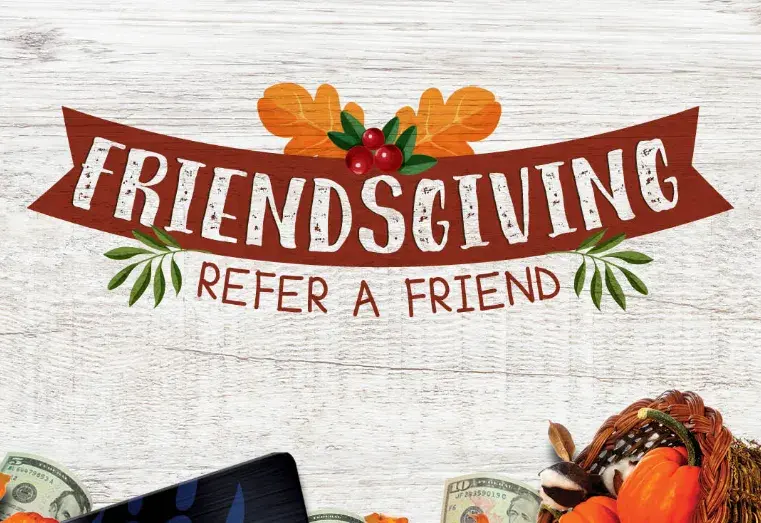
70. “New Year, New Rewards! Refer a Friend and Start the Year Right.”
What I like: This slogan connects the fresh start of a new year with the opportunity to earn rewards through referrals. It emphasizes a positive beginning and sets a goal-oriented tone.
71. “New Year’s Resolution: Refer More Friends!”
What I like: Cleverly frames referring friends as a New Year’s resolution, tapping into the common desire for self-improvement and goal setting.
72. “New Year, New You, New Referrals!”
What I like: The idea of personal transformation in the New Year with the act of referring friends. It suggests that referrals are part of a positive change.
73. “Ring in the New Year with Rewards! Refer a Friend and Share the Cheer.”
What I like: This one connects the celebratory act of ringing in the new year with the reward of referring a friend. It emphasizes sharing joy and spreading positivity.
74. “Cheers to the New Year, Cheers to Rewards! Refer a Friend and Save.”
What I like: Uses a celebratory toast to connect the new year with the reward of referring a friend. It also highlights the potential for saving money or accessing deals.
75. “Countdown to rewards! Refer a friend before the New Year.”
What I like: Creates a sense of urgency and excitement by framing referrals as a countdown to the new year activity. It encourages immediate action to secure rewards.
How to Write a Catchy Referral Slogan
Now that you have read through some catchy ‘join us’ phrases, let’s break down how to create your own referral slogan magic. Trust me, it’s easier than you think!
Here’s a step-by-step guide to crafting a referral slogan that will grab attention and inspire action.
1. Understand your audience.
Before crafting any referral slogan, you must understand who you’re speaking to. Are they young professionals, parents, teenagers, or retirees? Tailor your message to resonate with them.
Pro tip: I recommend asking questions like what are their likes, dislikes, challenges, or aspirations? This will help you understand your audience better and set the foundation to craft an effective slogan.
2. Highlight the program’s benefits.
People need a compelling reason to act. Therefore, your referral slogan must highlight the advantages of referring your brand to someone. Clearly state the benefit, whether it’s a discount, a freebie, or monetary incentives.
Pro tip: Based on the questions asked, I’d try to provide a benefit your audience will likely act upon.
3. Keep it short and memorable.
I think the best referral slogans are concise. Even a little bit witty. The shorter it is, the easier it will be for people to remember and share.
Pro tip: Play around with rhymes, puns, or catchy jingles. They can help your slogan stick in your audience’s minds.
4. Use action words.
A compelling referral slogan should motivate action. You can inspire immediate steps by integrating powerful verbs such as “Share,” “Tell,” “Invite,” or “Join.”
Pro tip: Think of this word as a call-to-action button. Use the word that your audience will most likely click.
5. Add a touch of emotion.
People connect with emotions, be it joy, excitement, nostalgia, or gratitude. Weave a touch of emotion into your referral slogan to create a deeper connection. Whether it’s the thrill of discovery, the warmth of sharing, or the joy of benefiting together, emotions can be a driving force to action.
Pro tip: Consider the emotion your product or service evokes in your customers and incorporate that feeling into your slogan.
6. Test and refine your slogan.
Before finalizing your referral slogan, test it out. Gather feedback and see how people react to it. Based on the feedback, refine it until it’s just right.
Pro tip: Consider using social media polls or focus group discussions. These platforms provide real-time feedback and can help you tweak your slogan for maximum impact.
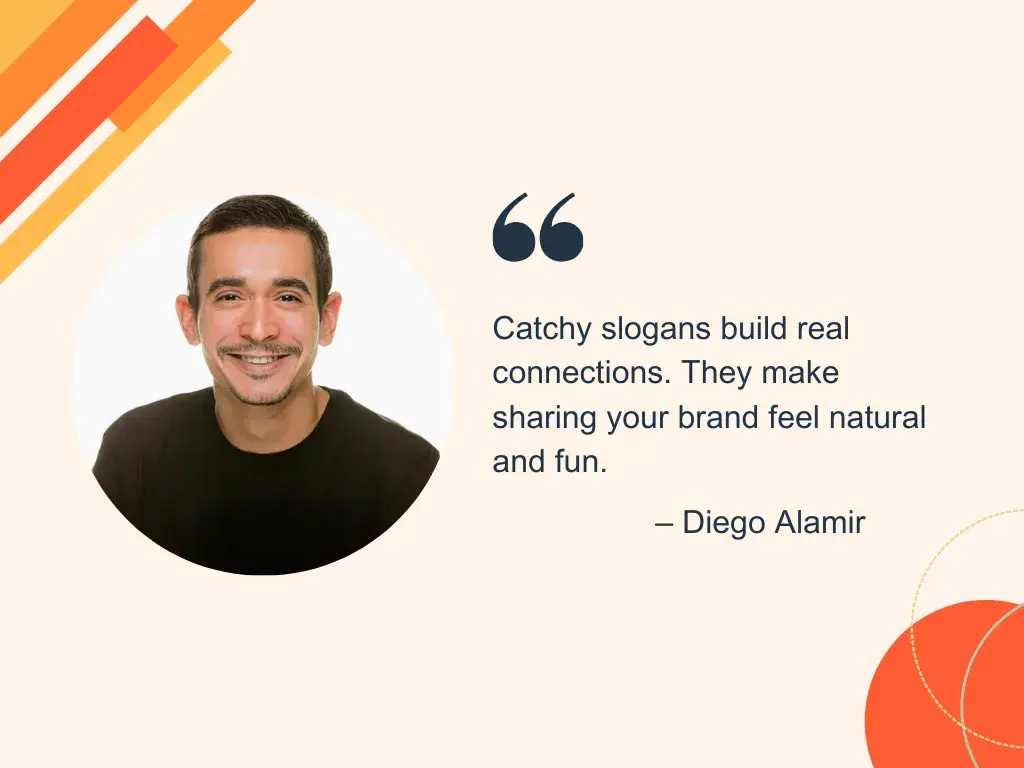
Key Takeaways for Crafting Referral Slogans That Convert
Wow, we’ve covered a lot of ground! As I was compiling this collection of referral slogans and reflecting on my own experiences, I was struck by a few key things.
First, I was reminded of just how powerful a simple phrase can be. Truly catchy “join us” phrases can be the spark that ignites a wave of new customers and brand advocates. It’s a small investment with the potential of huge returns.
Second, I realized that there’s no one-size-fits-all solution. The most effective referral slogans are those that resonate with your specific audience and reflect your brand’s unique personality. Don’t be afraid to get creative and experiment until you find what works best for you.
Finally, I was reminded of the importance of keeping things concise and memorable. People are bombarded with information these days. Referral slogans need to be catchy and easy to remember if you want it to stick.
I encourage you to take inspiration from the examples I’ve shared and craft referral slogans that capture the essence of your brand and the excitement of your referral program. With a little creativity and effort, you can create catchy “join us” phrases that drive results and help your business thrive.
Need a little more help with customer referrals? Don’t forget to download our 45 free referral templates for a great headstart resource.
Editor’s note: This post was originally published in November 2023 and has been updated for comprehensiveness.
![]()
Customer Data Management Tips + Best Practices (According to Experts)
Your customers’ data, from lead capture to post-purchase, has huge potential for your company … IF it’s managed correctly. I once worked at a company that treated customer data like a grocery store receipt, chucking it in the back seat of the car with a […]
ServiceYour customers’ data, from lead capture to post-purchase, has huge potential for your company … IF it’s managed correctly. I once worked at a company that treated customer data like a grocery store receipt, chucking it in the back seat of the car with a vague “I’ll find it there later if I need it” approach. This annoyed employees to no end and left money on the table for how well we could’ve served our audience.
Those who are new to customer data management have no time to waste: Consumers are becoming more aware and critical of how their data is being gathered by companies. Governing bodies are creating more protective laws, and this shift is ultimately making the customer data that you have even more valuable.
![Download Now: Introduction to Data Analytics [Free Guide]](https://no-cache.hubspot.com/cta/default/53/8982b6b5-d870-4c07-9ccd-49a31e661036.png) Let’s get into what an effective customer data management strategy looks like and which tools you can use to make it easier.
Let’s get into what an effective customer data management strategy looks like and which tools you can use to make it easier.
Table of Contents
- What Is Customer Data Management?
- Why Is Customer Data Management Important?
- Experts’ Best Practices for Customer Data Management
- Why a Customer Data Management Tool Can Help
- How to Choose a Customer Data Management Platform
- Hit the Ground Running
What Is Customer Data Management?
Customer data management is the process of gathering, storing, and interpreting customer information. The data can be first, second, or third-party data. Common types of customer data include:
- Behavioral data.
- Transaction data.
- Interaction data.
- Descriptive data.
- Customer interactions.
- Identity data.
Companies must handle data collection and governance with care to keep their customers’ information secure and private.
Why Is Customer Data Management Important?
The benefits of customer data can’t be understated — customer data is essential for scaling any business’s revenue. Without customer data, decisions around product improvements, new offers, paid advertising, etc. are based on guesswork instead of facts. Customer data is used to steer investments and measure output for sales and marketing teams.
It’s also a valuable ingredient in building and maintaining customer relationships. All modern customer service software (like HubSpot Service Hub) and customer relationship management tools (like HubSpot CRM) rely on customer data for:
- Improving the overall customer experience.
- Responding to customer inquiries.
- Re-engaging existing customers.
- Managing inbound leads.
Now that you understand its importance, I’ll share some top customer data management best practices according to data experts, business owners, and marketing professionals.
Experts’ Best Practices for Customer Data Management
Collecting data is the easy part of the process. Managing customer data and turning it from a pile of numbers into actionable information is the tricky part but absolutely essential. These are the top five tips for managing customer data I collected from experts.
Identify a “customer.”
Your company can’t get coherent, actionable customer data without having a single source of truth. This starts with your definition of a customer. “I believe the most important practice in customer data management is establishing a unified, consistent definition of ‘customer’ across the entire organization,” Binod Singh, founder of Cross Identity, shared with me.
Sales might define a customer as anyone who’s purchased in the last five years, while marketing might only consider customers active if they’ve engaged in the past year. Without a common definition, it’s easy for data to become fragmented or for teams to make decisions based on incomplete or inconsistent data.
Binod Singh explained how he handles this challenge at his company: “We try to focus on creating a company-wide standard for customer status and criteria, so every team can confidently work from the same 360-degree view. This alignment allows us to provide personalized and relevant interactions across channels, which I believe is crucial to improving customer experiences.”
Ensure real-time updates.
The information you get out of your customer data management systems is only as good as the information you put in. I think the best way to manage your customer data is to always prioritize accuracy and real-time updates — the result is a comprehensive picture that empowers decision-making.
“If you aren’t focusing on accuracy and real-time updates, you run the risk of eroding trust with your customers by making mistakes in your engagement,” shared Laura Hill, marketing manager at KNB Communications.
“When your data is accurate and up-to-date, you’ll be able to have more meaningful and genuine interactions, which leads to better outcomes.” Laura recommends that you consistently clean, standardize, and review your data.
Segment users.
Prioritizing segmentation in your customer data strategy creates opportunities for personalized customer experiences, such as sending customers personalized emails or targeting them with relevant promotions.
Josh Neuman, founder of Chummy Tees, shared an example of how this looks in his business: “Whenever someone buys one of our funny or custom tees, we tag their preferences — whether it’s based on design style, purchase frequency, or even the time of year they tend to shop. For example, we’ll send new animal-themed designs to people who’ve bought cat or dog shirts in the past.
“Segmentation ensures we don’t waste time or money on campaigns that won’t land. Plus, it keeps customers engaged by showing them stuff they actually care about.”
Track silent data.
I know it’s natural to focus on the loudest numbers when you start to analyze customer data, but Jake Ward, founder of Kleo, recommends an unconventional approach: actively engaging with the silent data.
“What I mean by this is focusing not just on the obvious metrics like open rates or clicks but on the data that isn’t making noise,” Jake told me. Listening to the noisy and silent data in your business can look like:
- Engagement and disengagement.
- Purchases and abandoned carts.
- Clicks and hovers.
“It’s about reading between the lines of your data and acting on the gaps, not just the spikes,” explained Jake. “That’s where the real value lies — finding the trends in what’s not happening.”
Use a data classification system.
A proactive approach to customer data management is implementing a data classification system. Adhiran Thirmal, solutions engineer at Security Compass, encourages you to think about it this way:
“Consider it like packing up your data in tidy boxes according to how sensitive it is and under what regulations. When you separate data into types — personal, financial, or otherwise not sensitive — you can then implement the appropriate protections and permissions.”
Not only is this a great practice to ensure that personal data isn’t hacked, but it makes it easier to meet GDPR and HIPAA regulations as well. I think it also promotes an organizational culture of accountability so everyone knows that data needs to be handled carefully.
Why a Customer Data Management Tool Can Help
Customer data management platforms take a complex, multi-dimensional task and simplify it into a single source of truth for your organization; it’s the glue that holds your overall strategy together. A tool guides you through important decisions like how data will be:
- Collected from customers.
- Organized and sorted.
- Accessed by team members.
- Secured and protected.
There are countless customer data management tools on the market — we share details of our top picks in our data management platforms guide, and I’ll also share overview recommendations below.
How to Choose a Customer Data Management Platform
What should you look for in a good data management platform? Here are the qualities I’ve found the good platforms will have.
Aggregated Data
An effective tool will pull all available customer information from diverse data points to create one single source of truth for your company. This includes first-, second-, and third-party data. Data options also include structured, unstructured, and semi-structured data, as well as “big” and “small” data, with companies shifting towards small data.
Statistic: Gartner predicts that by 2025, up to 70% of organizations will shift focus from big data to small data.
While a high-level understanding of these data types and how they work is beneficial, a good tool will help educate your team and aid in decision-making.
Consider: Google BigQuery, a data management platform that gathers data from diverse points and helps businesses unlock their data potential.
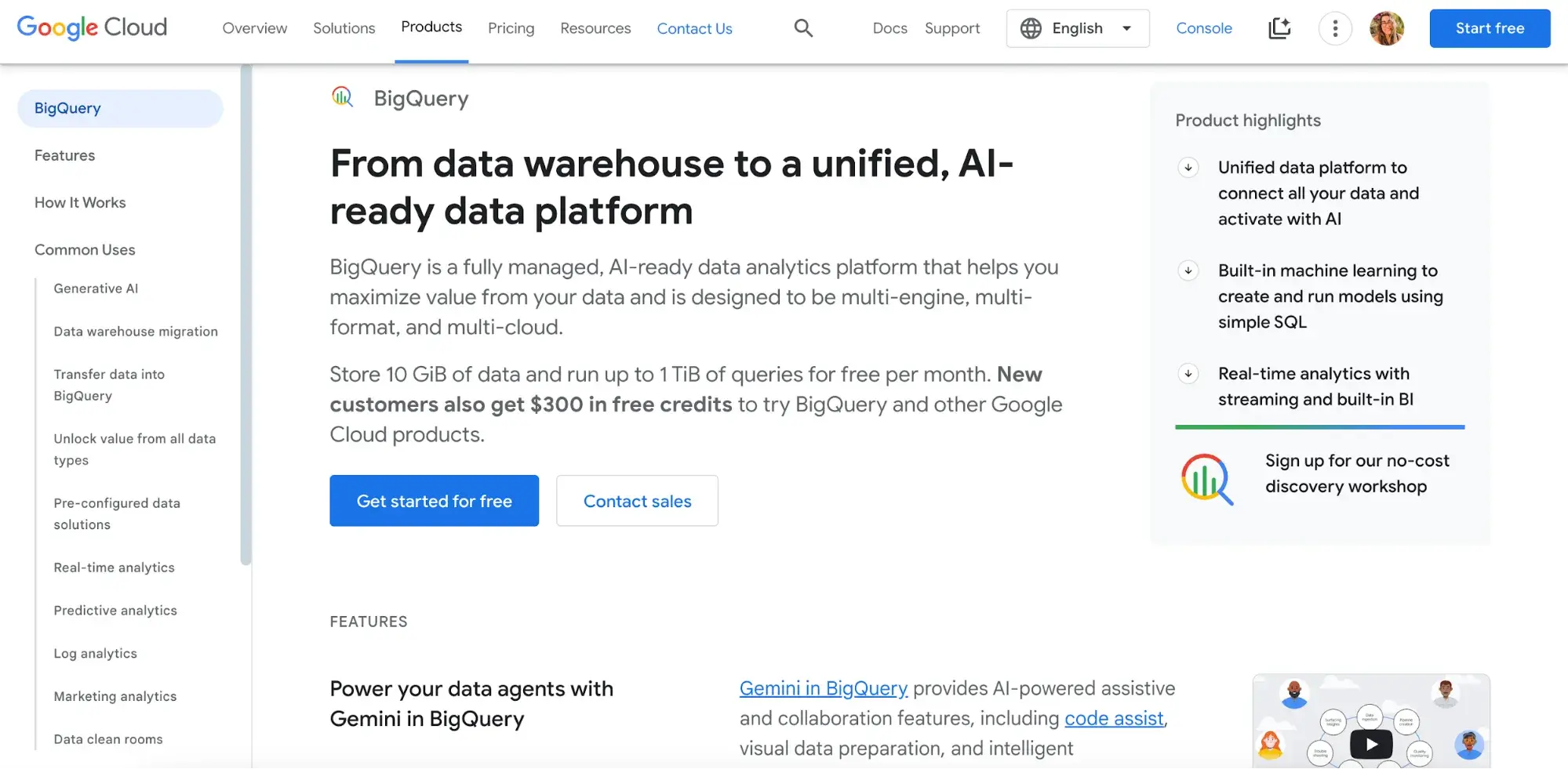
Legal Regulations
Legal compliance isn’t a one-time fix — it’s a moving target. Standards are actively changing as new laws are introduced, and they also vary depending on the location of your customers.
You may have heard of GDPR or CCPA regulations — those common abbreviations stand for General Data Protection Regulation (in the European Union) and the California Consumer Privacy Act (California only). Data tools need to be aware of and in strict compliance with these laws based on customer location.
The market is being flooded with AI-generated data tools that may or may not be compliant with current laws. Plus, even big data companies get it wrong sometimes. I received a $500 payout from a class-action lawsuit against Facebook when it unlawfully collected and stored data from Illinois residents.
Remaining lawful in your data management strategy is non-negotiable. A good data management system understands the past, present, and future of lawful data collection.
Consider: Adobe Audience Manager for its data governance and leadership in the industry.
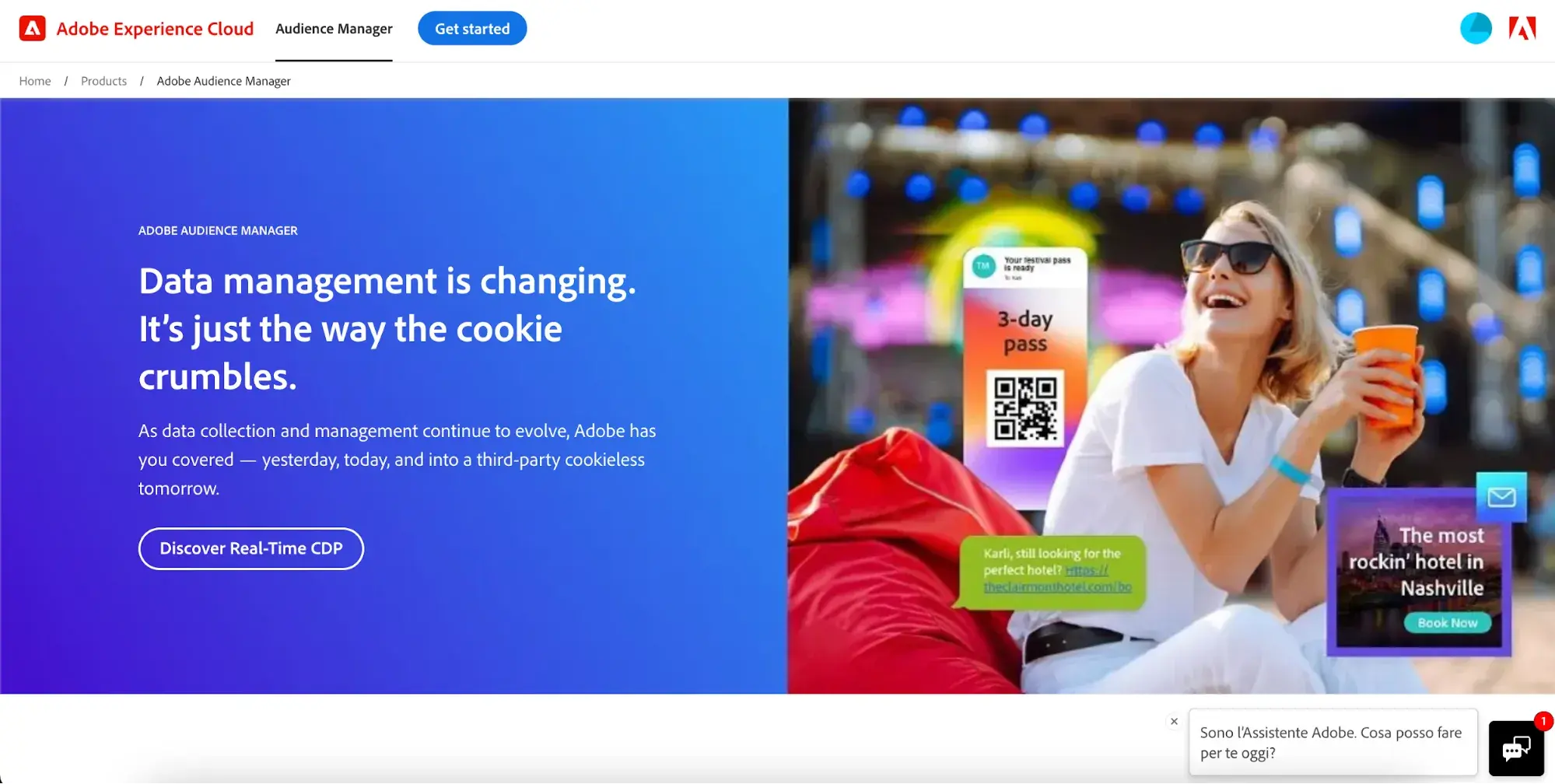
Data Governance
I mentioned that Adobe Audience Manager has built-in data governance, but what does that mean? While governing bodies regulate how data can be collected and used externally, each company’s data governance strategy decides how that will be done internally.
If you’re a small business, startup, or bootstrapped business, I’ve learned firsthand that digging into the nuances of data governance is a task that’s very costly to your time. Using a tool that has built-in governance will provide a framework for data quality, usage, and stewardship.
Consider: Adobe Audience Manager or IBM Db2® Hybrid Data Management for advanced data governance strategies.
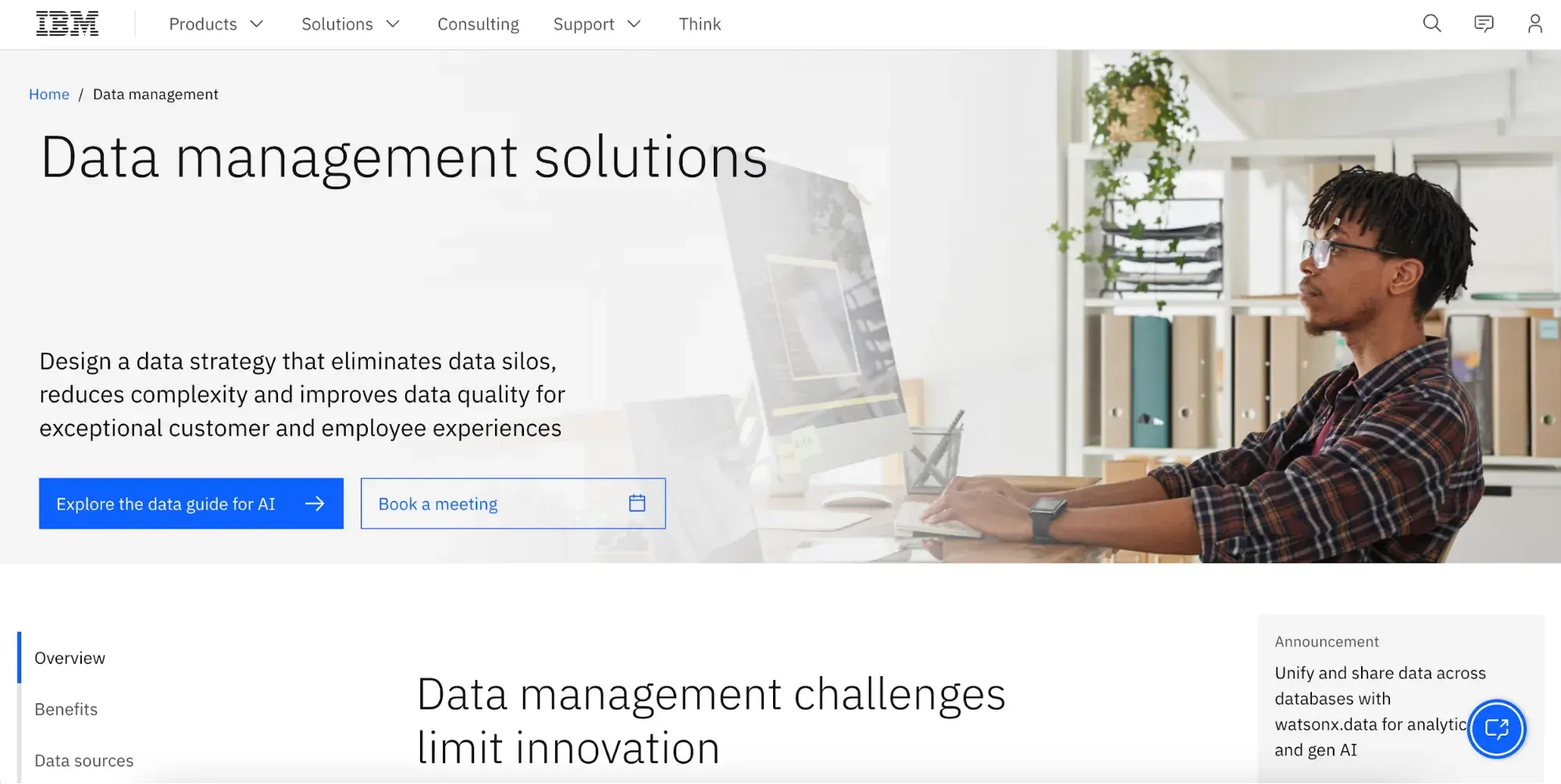
Scalability
As your company grows, so do your data management needs. This makes scalability a huge perk for startups and rapidly-growing companies, and a step in future-proofing your investment.
A scalable customer data management tool is robust enough to handle mass quantities of data elegantly without slowing down or creating data silos, while also being responsive enough to handle changes. I suggest growing companies look for reliability, consistency, and scalable pricing.
Consider: Salesforce Customer 360 for its scalability and enterprise packages. I first used Salesforce when I was working at one of the largest nonprofits in the U.S. — its bandwidth can handle small businesses all the way up to major ventures.
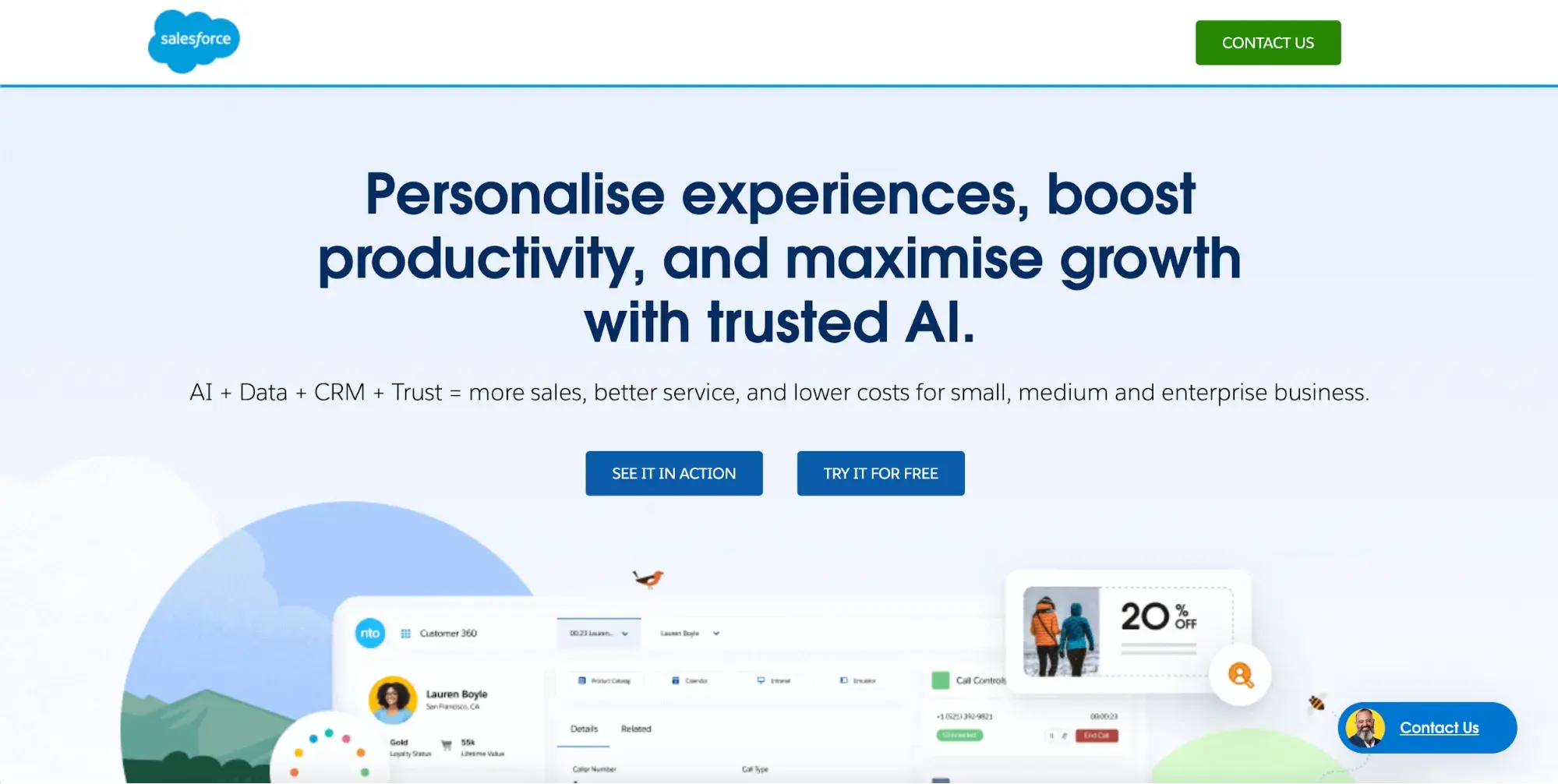
Security
It feels like there’s a new data breach in the news every other week, partially because threats are constant and partially because not all companies prioritize data security.
Statistic: Email is the most common vehicle for malware, and 94% of organizations have reported email security incidents.
Security matters for everyone, but it’s particularly important for companies that process sensitive data such as medical or financial records. A data breach isn’t always 100% preventable, but companies reduce their odds of it happening to them when they invest in data management software that prioritizes security.
Consider: Snowflake for its encryption and data protection.
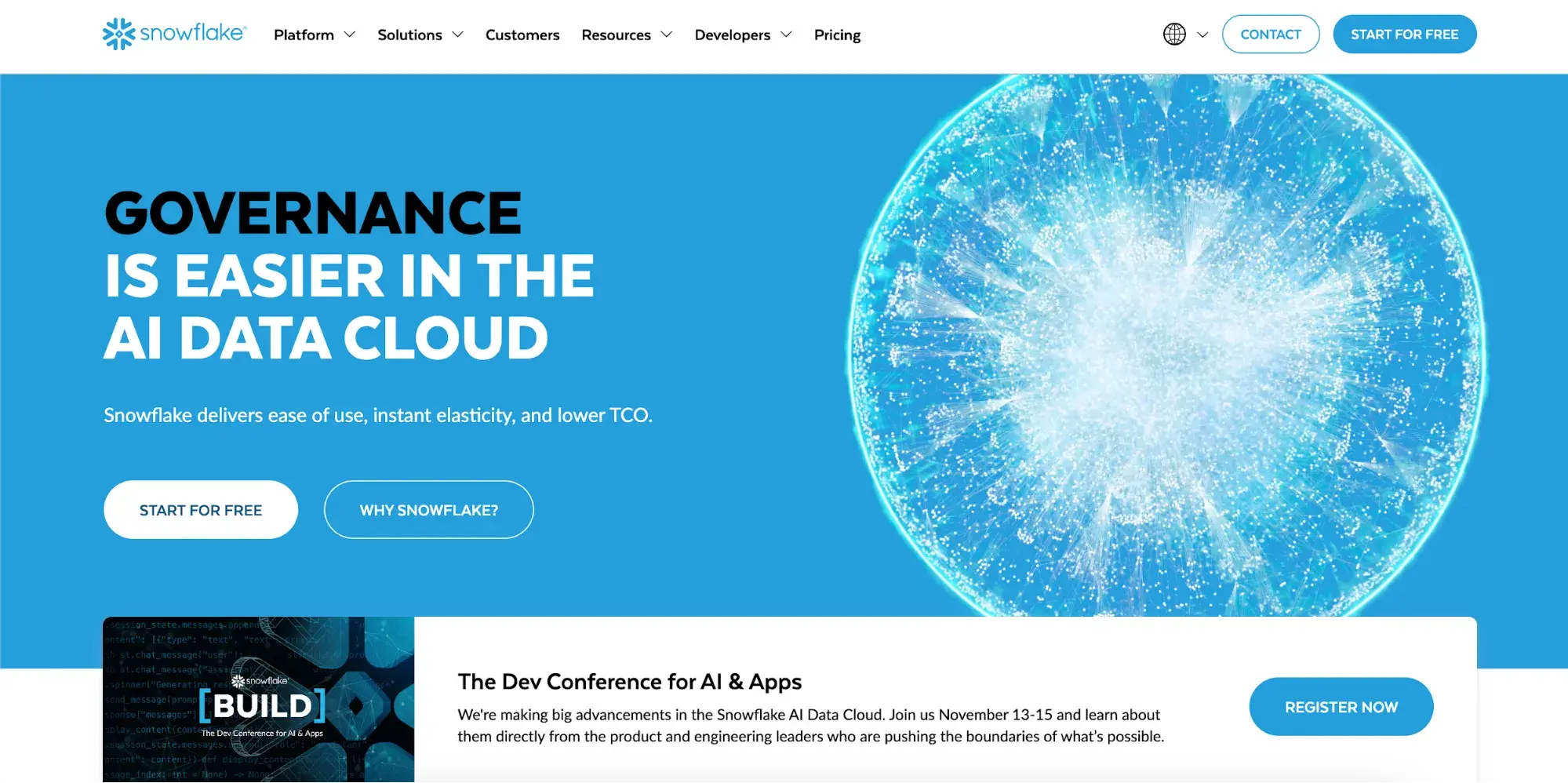
Ease
All the data in the world can’t improve company efficiency if your customer data platform is too difficult for you (and your team) to use. Company-wide adoption relies on how user-friendly the platform is for your team.
Anything that’s not automatically collected needs to be input manually, such as at-home customer support visits from company reps who work in the field. Avoid the mistake of using a customer data platform that’s so technical only certain teams feel comfortable accessing it. This leads to incomplete pictures and frustration.
Insight: A steep learning curve is the #1 complaint in customer reviews for data platforms.
I looked for a statistic on the cost of a slow team-wide software adoption, but then I realized I didn’t need one; we all know how bad it is because we’ve all been there before. It’s like pulling teeth to get team members to use a platform that they don’t like, and it’s costly when team members drag their feet.
Consider: Twilio Segment, whose online reviewers specifically mention how lightweight and easy to use the platform is.
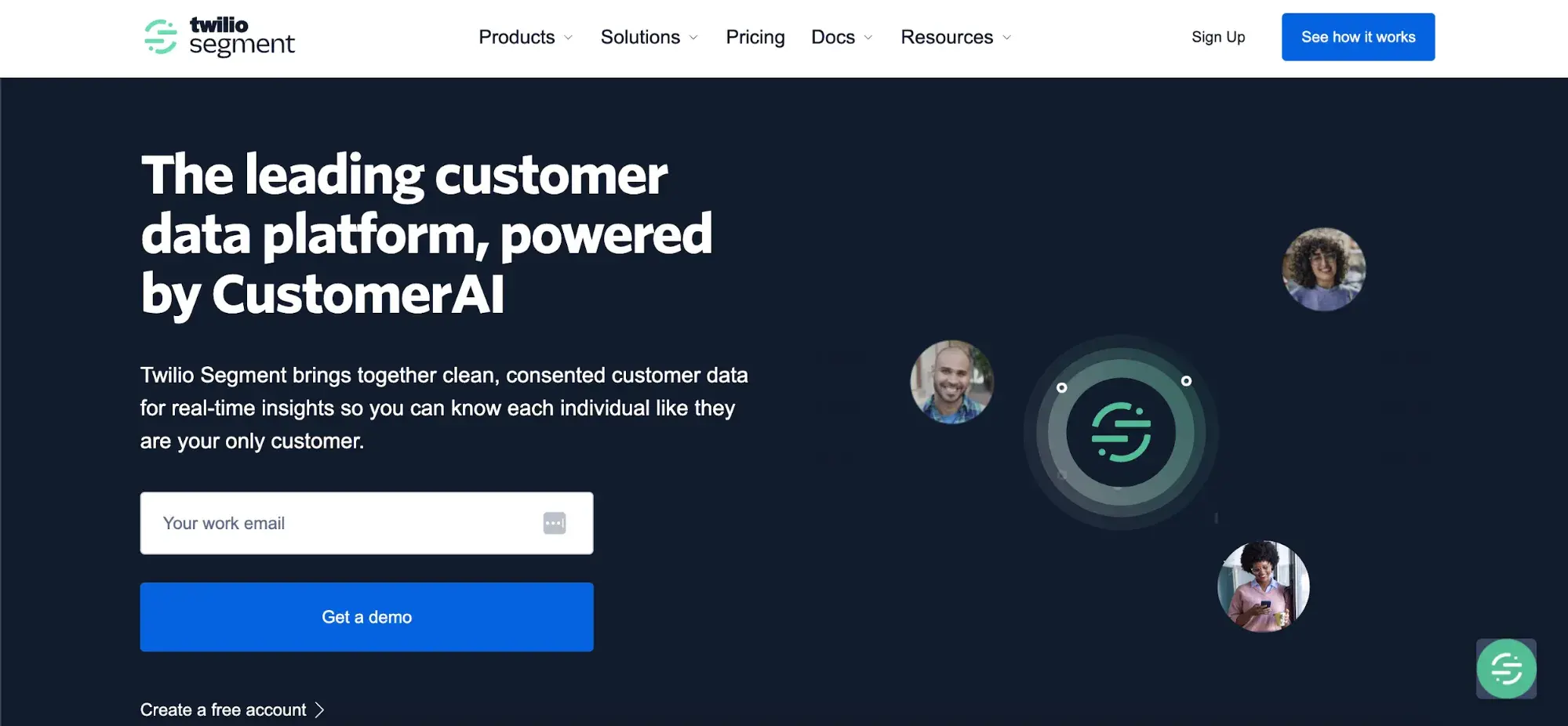
Customer Support
You’ll need help along the way to take such a vast, complicated tool and tailor it to your specific customer data needs; a good tool will provide excellent support for you along that journey.
All customer data platforms, no matter how user-friendly, will require assistance from customer support. Good customer support in a CDP means quick response times, support reps who deeply understand the product, and a team who is also invested in helping you use it correctly.
Consider: ActionIQ, which gets praise from online reviewers for its customer service. It gets top marks from existing customers — Gartner reported that 100% of surveyed participants recommended ActionIQ to others.
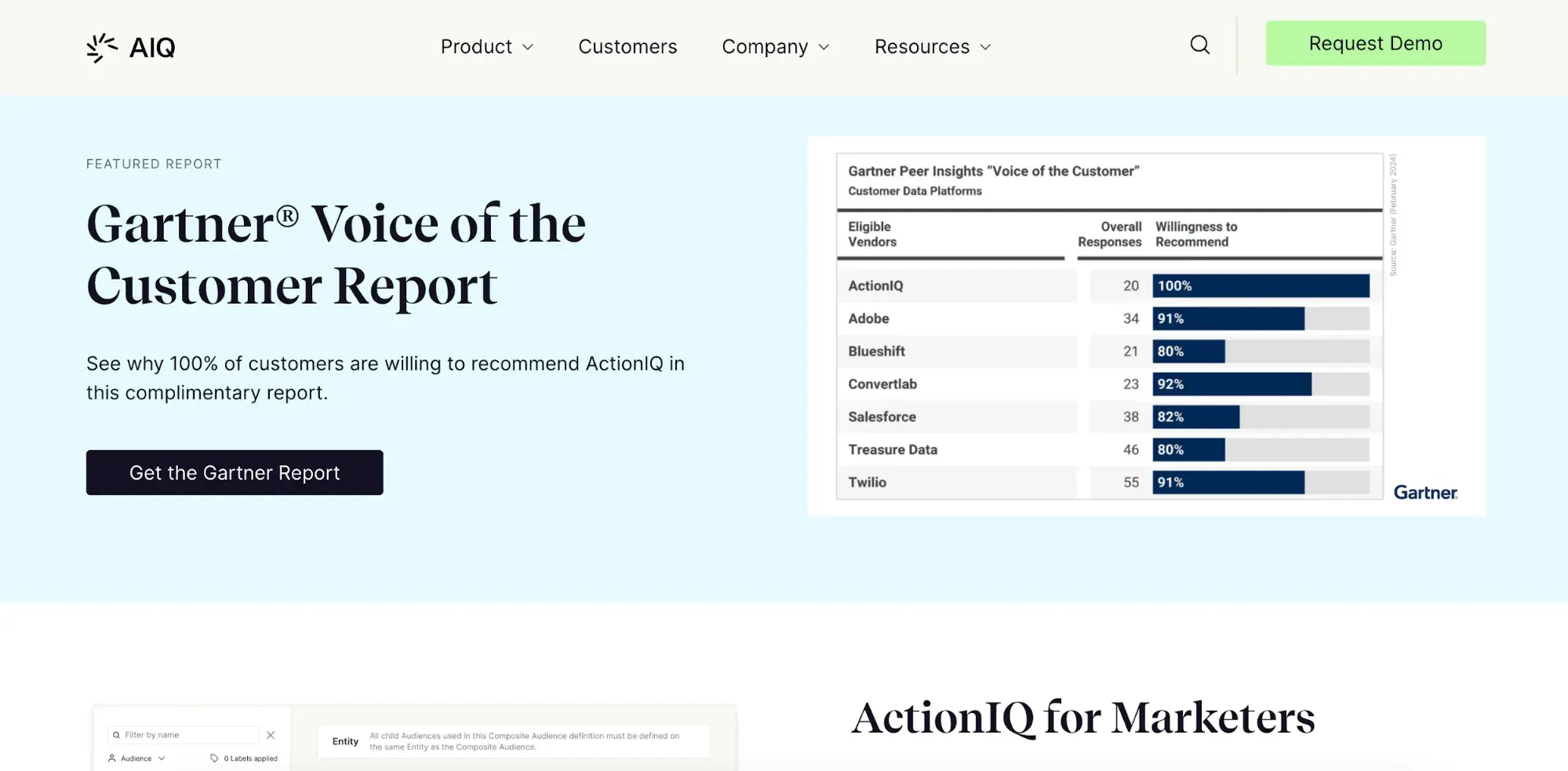
Hit the Ground Running
Constantly evolving data regulations are making it more difficult to collect data, which makes the data you have available to you even more precious. Building your company’s data infrastructure may be intimidating upfront, but it’s going to create opportunities and insights that are well worth the time.
I hope that these tools and tips will help you feel empowered (instead of overwhelmed) and get a tool that fits your needs perfectly.
![]()
4 Ways AI Can Improve Your Loyalty Program OR 4 Ways AI Can Improve Your Customer Loyalty
Is it really possible for AI to improve your customer loyalty program? The answer is yes! The majority of customer service professionals say AI improves the customer experience, so if you’re not using it yet, you’re missing out. I’ve written a lot about AI in […]
ServiceIs it really possible for AI to improve your customer loyalty program? The answer is yes! The majority of customer service professionals say AI improves the customer experience, so if you’re not using it yet, you’re missing out.
I’ve written a lot about AI in the sales and marketing process, and I come back to the same sentiment that AI can only do so much and that human input is incredibly important. For this reason, even for me, improving customer loyalty with AI felt like a leap, but after speaking to 12 professionals, I’m a convert.
If it sounds counter-intuitive that automation and artificial intelligence add value to such an extent that retained customers become loyal customers, then this is the article for you. Let’s get into it.
Table of Contents
How AI Can Impact Customer Loyalty
First, let’s look at how AI can impact customer loyalty through four use cases.
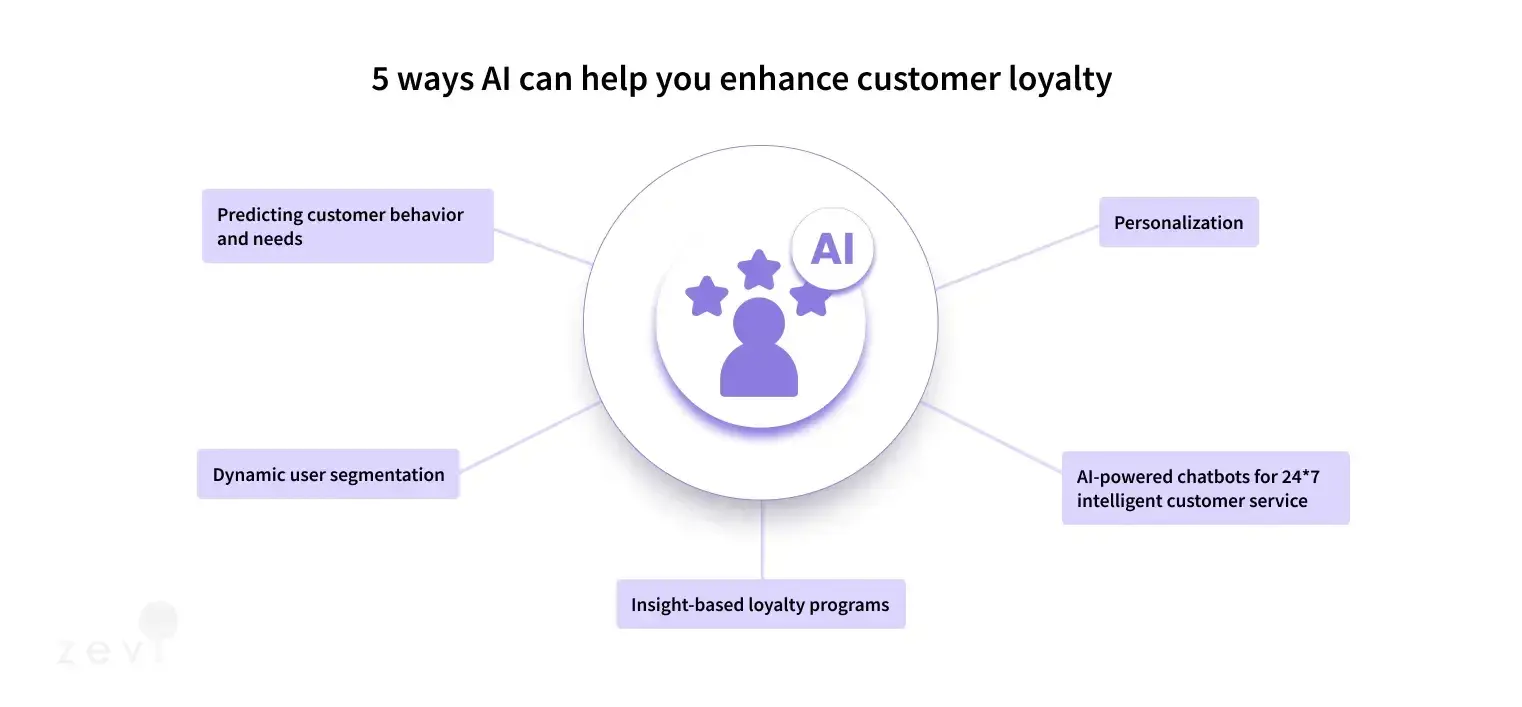
Chatbots
Chatbots are an easy way to improve the customer experience by allowing people to self-serve, accelerating resolutions to their real-time problems. A survey conducted by Userlike found that 80.2% of people had interacted with a chatbot, and 77% wanted the option to speak to a human agent.
Many AI chatbots do provide the option to speak with a person. See the image below of HubSpot’s chatbot, where you can click “Chat with sales” and speak with an agent.
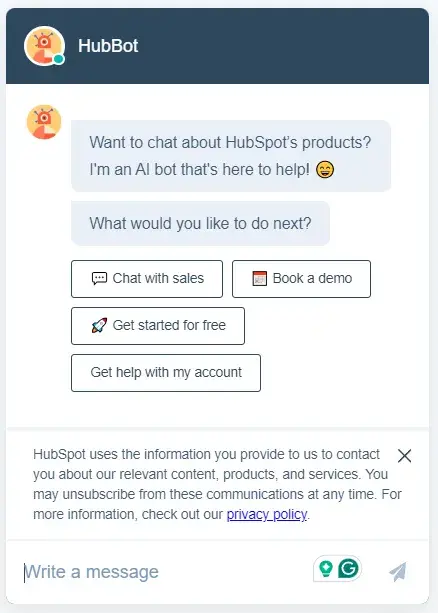
I often use a chatbot to access a human, but there are plenty of circumstances where the chatbot has the functionality to do what I need. In circumstances where the chatbot can serve me, I’m happy because it’s faster!
I’m not the only one who’s satisfied with AI chatbots. Tidio’s study found that businesses (especially ecommerce) are very satisfied with how customer service has improved thanks to AI chatbots.
According to IBM, Lyro’s chatbot handles 80% of common inquiries and improves response times significantly.
Analytics and Predictive Analysis
AI can analyze and handle large datasets faster than any human. Plus, unlike a person, AI can be on, working in real-time 24/7 for every single customer on your website or recorded in your CRM.
For example, Omer Lewinsohn, General Manager at Management.org, uses AI to improve customer loyalty by analyzing historical transaction data and customer interaction.
Lewinsohn says, “AI predicts future buying behaviors and preferences. This predictive capability helps us design loyalty programs and offers that resonate more deeply with our customers.”
When asked for an example, Lewinsohn says, “Customers who frequently purchase certain products may receive personalized discounts or exclusive early access to new products, enhancing their feeling of being valued and increasing their loyalty.”
As mentioned before, AI can work 24/7 and for every interaction. When working in real-time, personalized discounts can be provided to customers when they’re on your website contemplating a decision.
Audience Segmentation
Segmenting audiences in your CRM or email campaigns allows you to deliver personalized campaigns designed to nurture your audiences to conversion.
Mailchimp says that their AI audience segmentation is faster and more efficient.
If you know what your audience is interested in, you can build campaigns to better support and engage them.
For example, if you have an automated segment of people who downloaded your most recent ebook, you can target them with content related to the ebook. If you want to take this further, as pictured below, you can add filters such as location or engagement metrics like the number of pages viewed.
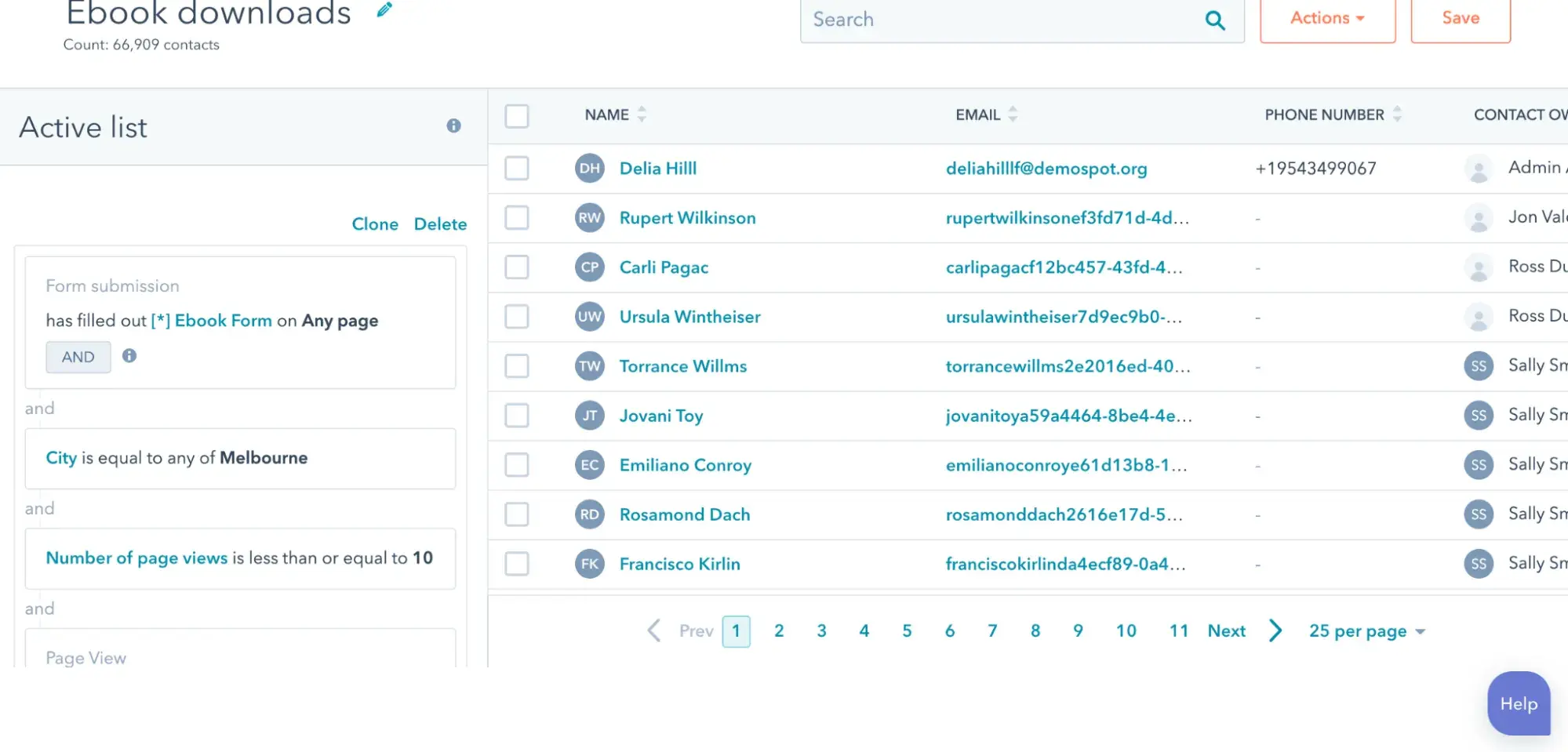
Personalization
The audience segmentation leads nicely to personalization.
Alex LaDouceur, Co-Founder at Webineering, recommends micro-moments as the ultimate form of personalization.
LaDouceur says, “We’ve been using AI micro-moments as a new form of customer outreach, creating small, personalized touchpoints based on tiny details of a customer’s engagement. If AI sees a customer looking at a certain product page for a long time or regularly checking their account balance, it might throw them a little real-time bone, such as a discount code or personalized copy, without them having to take action other than engaging.”
The above details just four ways that AI improves customer loyalty. Next, we’ll look at real-life examples of professionals using AI to build customer loyalty.
Examples of AI Building Customer Relationships
I asked professionals for their most interesting examples of AI being used for customer loyalty, and everyone delivered.
Toggl: Proactive AI Engagement Prevents Churn
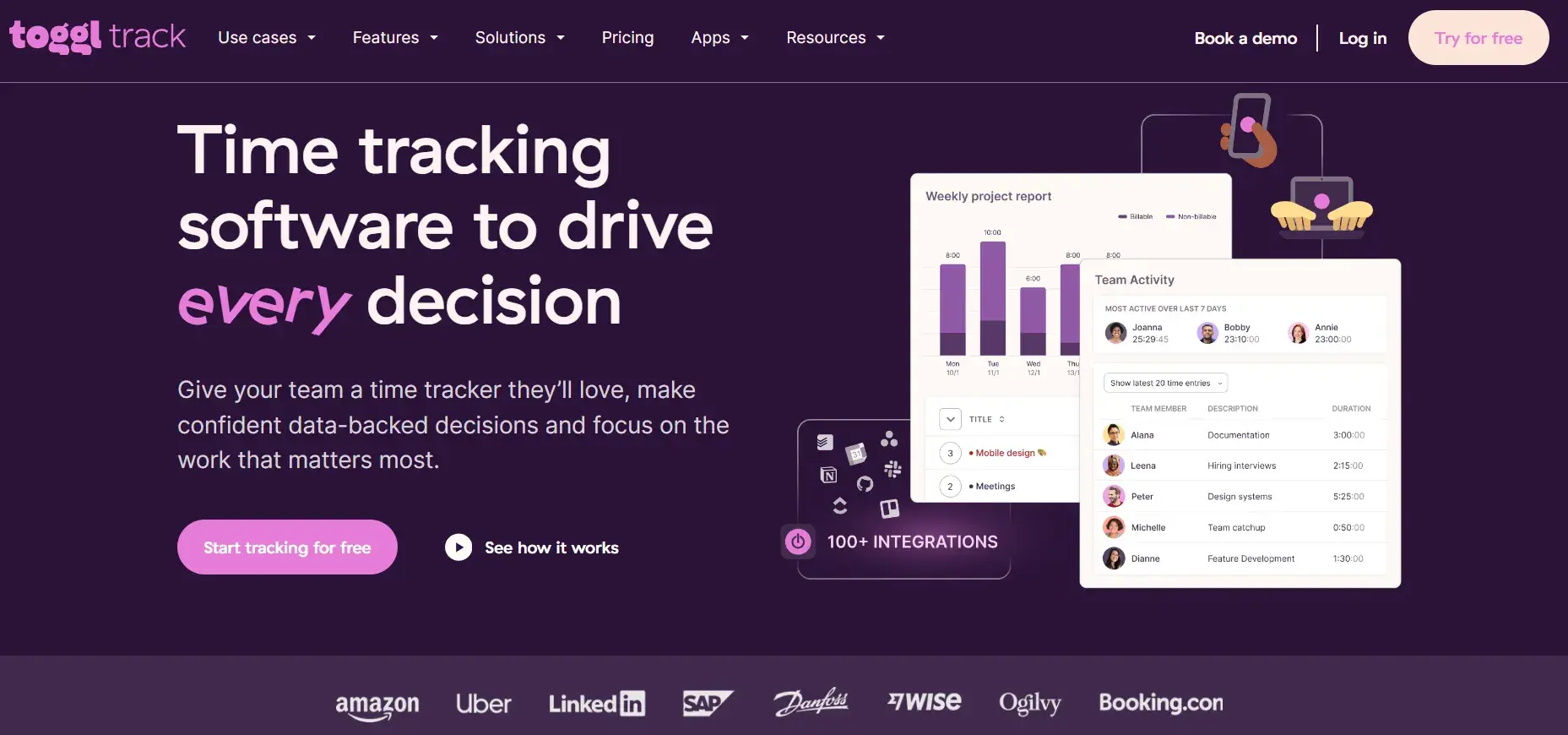
Toggl uses predictive analysis to track engagement and predict customer disengagement. With this analysis, Toggl can offer proactive help before customers know they need it.
I asked Alari Aho, CEO and Founder at Toggl Inc., about proactive help.
Aho explained and provided examples, “Offering proactive help before [the customers] even know they need it could be as simple as an email nudging them to use a feature they‘ve overlooked, or as complex as offering personalized training for teams that aren’t getting the most out of the product.”
Aho says the benefit is “[showing] users that we care about their success with our tools, keeping them loyal over time. AI allows us to be proactive rather than reactive in nurturing loyalty.”
Aho has many great tips for bringing proactive AI engagement into your operations. Below, I break down each top tip.
Set up triggers.
First, Aho recommends setting up triggers. He says, “Set up triggers for proactive communication, offering support or incentives to re-engage users before they decide to leave.”
Catch signs of disengagement early.
Proactivity is certainly the goal of catching disengagement with your product. With AI, you want to serve your customers before they need it. Aho says, “The earlier you catch signs of disengagement, the easier it is to course-correct and bring users back on board.”
Keep the communication personal.
Personalization came up a lot when I researched how AI supports customer loyalty.
Aho says, “Keep the communication personal, and don’t bombard them with generic messaging — use AI to deliver genuinely useful tips or tools that will enhance their experience. A timely, thoughtful interaction can turn a wavering user into a long-term loyal customer.”
What I like: I love this example from Toggl. I think taking proactive measures to look after customers is exactly where AI can be a huge benefit. As I mentioned earlier, the major benefit of AI is that it can be on 24/7 and can serve every single one of your customers. This is an insightful example of how to do it.
Reiner Group: AI Proactively Predicts Maintenance
I love this example from Andrew Hulsebos, Service Director at Reiner Group Inc. Huslebos uses AI for many proactive customer touchpoints, such as maintenance needs and timely reminders for service appointments.
Hulsebos told me, “In our HVAC company, AI has helped us create a personalized customer experience from the start. We use AI-driven analytics to track customer preferences, predict maintenance needs, and provide timely reminders for service appointments. This has helped us reach out to customers before an issue arises, giving them peace of mind and reinforcing trust in our service.
“Being able to predict when their system might need a tune-up, we offer preventive maintenance at just the right time, increasing both the longevity of their equipment and their satisfaction with our company.”
This is a perfect AI use case. The AI can automate alerts or give service teams a heads-up about when maintenance might be due. This proactive service will undoubtedly keep customers happy and prevent them from reaching a problem and turning to Google (and potentially competitors) to resolve it.
Automate routine tasks.
Hulsebos’s tip for implementing AI is to focus on automating routine tasks so you can maximize the human element.
He says, “Start small and focus on high-impact touchpoints. We use AI to automate routine interactions, like sending reminders or follow-up messages, but also make sure that there’s still a human element for more complex conversations. Balancing automation with personalized customer care allows us to maintain a relationship that feels personal and attentive, which is what drives long-term loyalty.”
What I like: I love it when I feel like a company is looking out for me. I had a company call me at timely moments when I needed a service a few years ago. I was so impressed with their proactivity that I signed up with them. I felt looked after and cared for.
Ondato: Process Improvements and Predictive Analysis
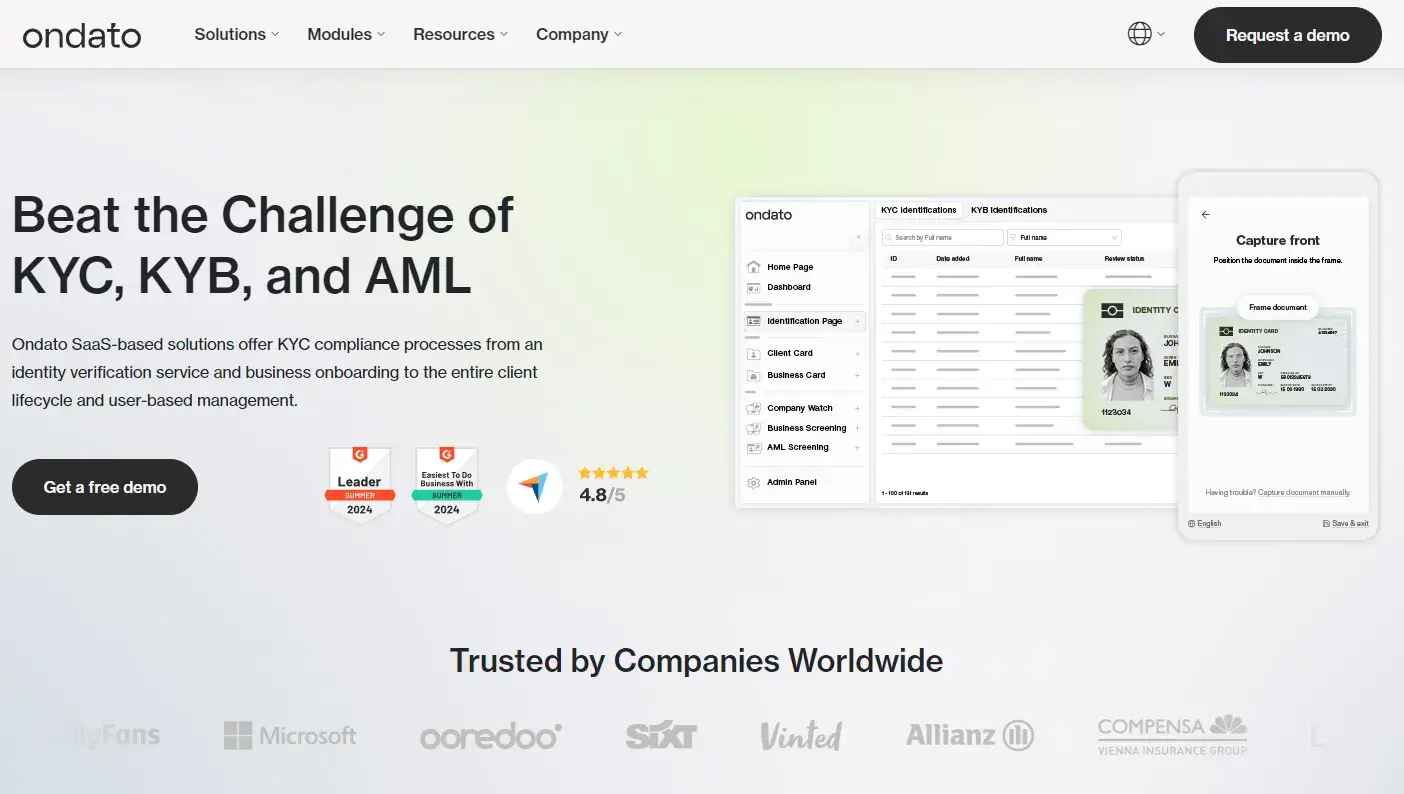
Liudas Kanapienis, CEO of Ondato, says the company is using AI extensively to improve business processes, which indirectly impacts customer satisfaction and directly impacts customers with personalization. Like Toggl, Ondato also uses predictive analysis.
Let’s dig into each example so you can start implementing this innovative AI for yourself.
Personalization
Kanapienis describes trust as “paramount” in the compliance space. According to him, “AI has played a critical role in fostering customer loyalty for our business by enhancing personalization, streamlining onboarding, and improving user experience.”
Kanapienis is using AI to “provide a seamless and tailored experience,” which is a “game-changer for customer retention.”
Processes
Ondato’s process improvements made them “faster, more accurate, and user-friendly.”
Processes were improved with AI-driven identity verification and fraud detection. Kanapienis says, “We reduced onboarding time while maintaining high security, leading to a smoother and more trustworthy experience. This efficiency creates a strong first impression, which is crucial for building long-term loyalty.”
Predictive Analysis
One key way AI helps with customer retention is through predictive analytics.
Kanapienis says, “By analyzing user behavior, we can proactively address potential pain points before they become issues. For example, AI flags unusual activity, allowing us to offer proactive support or adjustments, reinforcing the customer’s trust in our service.”
Kanapienis has top tips for implementing AI to improve customer loyalty. He says, “Start by integrating AI tools that enhance the user experience, such as chatbots for real-time support or recommendation systems that offer personalized content. Focus on one process — like customer onboarding — where AI can immediately show results. The smoother and more personalized the experience, the more likely customers will remain loyal.
“By making every interaction seamless and relevant, AI helps turn satisfied customers into long-term advocates.”
What I like: The team at Ondato has made the best out of AI for customer loyalty by integrating it into different parts of their company. The goal is always about the customer, though, and it shows how things like process improvements filter down and serve them.
The Laundry Basket: Personalized Offers
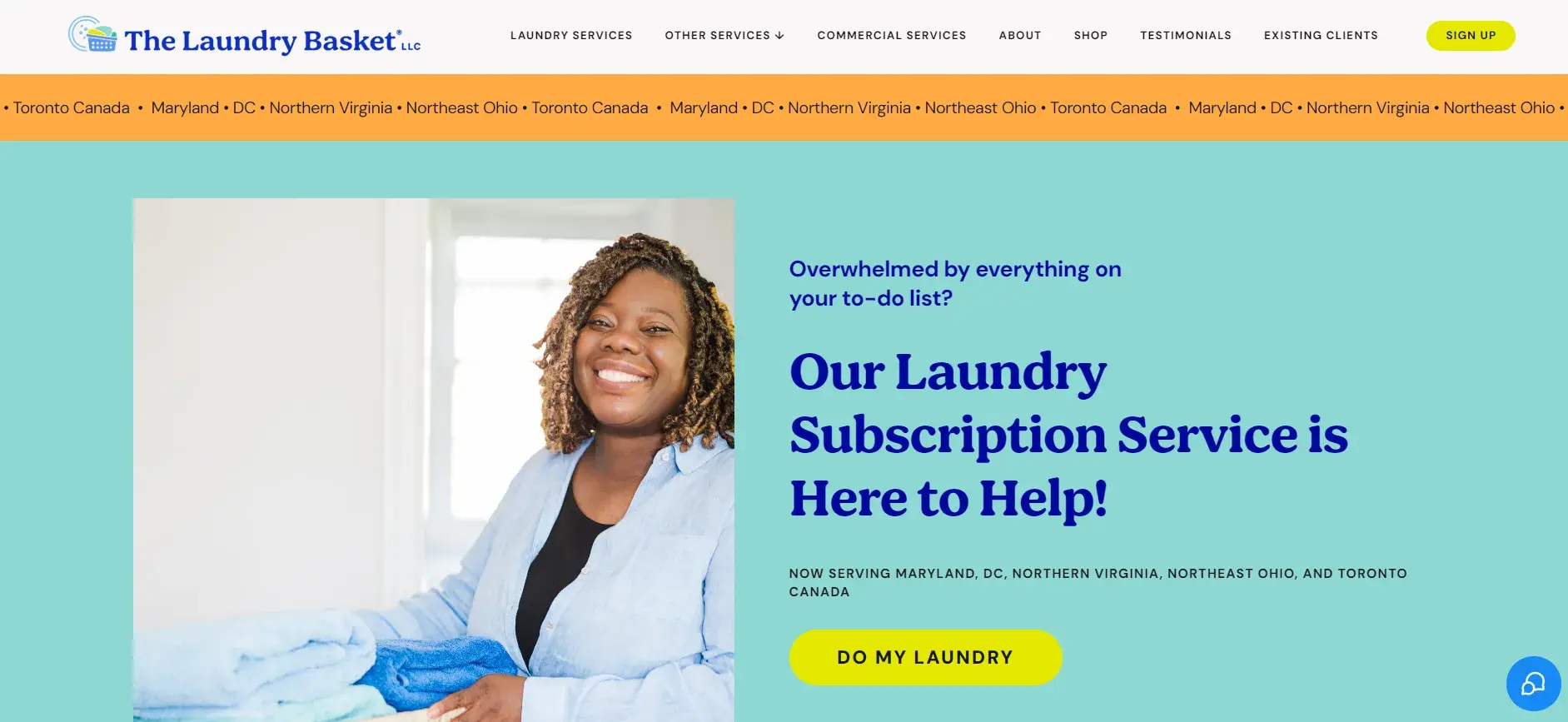
If you start collecting data about your customers’ behavior, you can learn what they want from you and then give them a personalized experience.
Hyacinth Tucker, Owner and CEO of The Laundry Basket LLC, describes AI as a “game-changer” for improving customer loyalty.
She says, “We use AI-driven tools to analyze customer behavior and personalize the experience for each individual.”
When asked for an example, Tucker says, “Based on past purchases and service preferences, we send tailored recommendations and exclusive offers that match each customer’s needs. This level of personalization makes our customers feel valued and keeps them coming back.”
Tucker’s tips for implementing AI in customer loyalty would be, “To start by collecting data on your customers’ preferences and buying habits, then use an AI platform to segment your audience and automate personalized communications. The key is to make sure the recommendations feel natural and relevant, not overly salesy.”
What I like: This AI approach is bringing a better, more personalized experience to Tucker’s audiences. I like how she finds a balance between natural and relevant marketing that isn’t too salesy.
Sail: Optimized Marketing Campaigns for Hotels
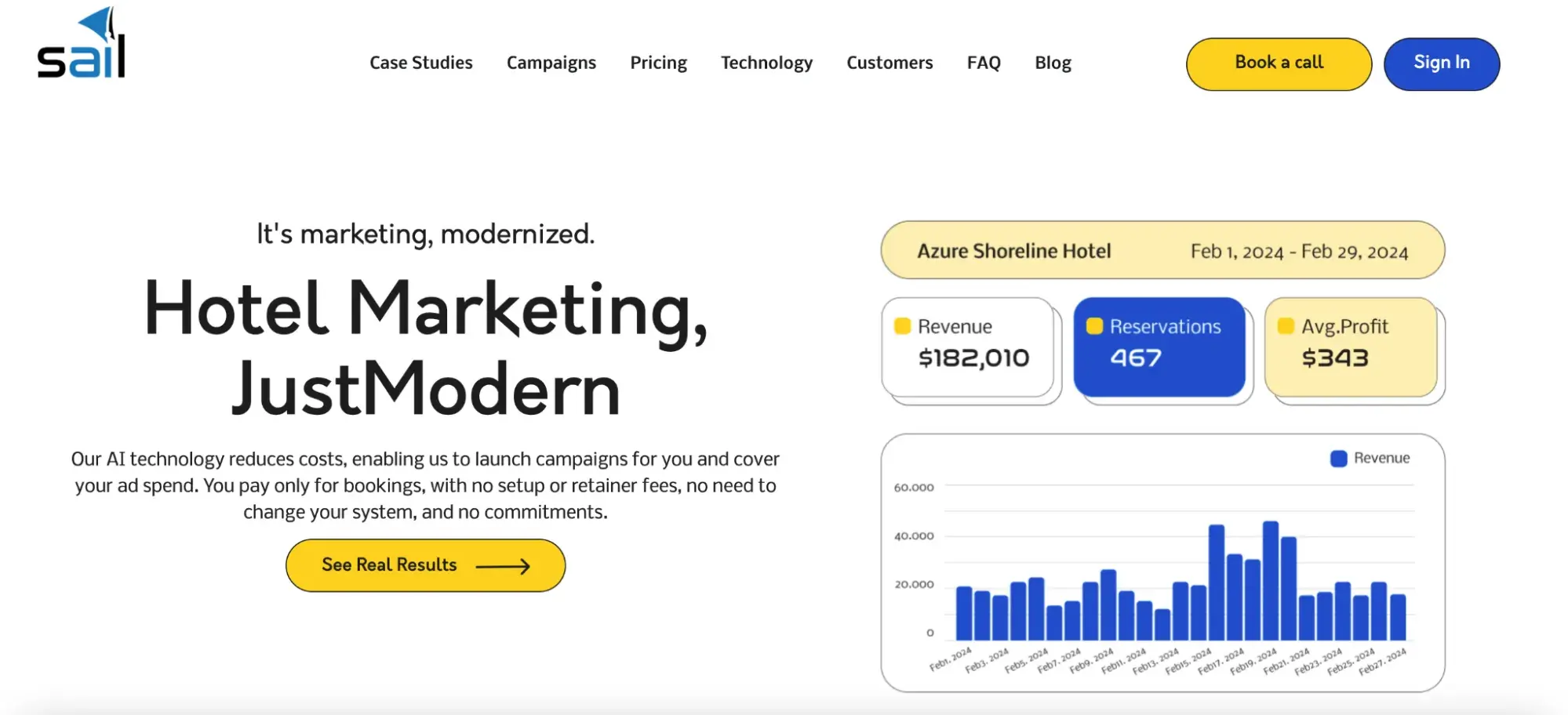
Shahar Rubin, CEO of Sail, is using AI to help hotels gain loyal customers. There are two primary ways in which the company is using AI.
Targeted Campaigns
Sail’s algorithms analyze hotel booking and guest data to optimize marketing campaigns and boost direct bookings, which builds trust and loyalty.
Rubin provides an impressive example, resulting in direct bookings rising 34%, “One hotel saw stagnant growth for over a year. Our AI found their social media presence was low, so we launched targeted Facebook and Instagram ads. In three months, direct bookings rose 34%, and repeat guest rates increased over 50%. By using data to demonstrate how we improve KPIs, hotel loyalty soars.”
Chatbots
Rubin continues, “We also provide 24/7 chatbots on hotel websites to resolve basic questions. One hotel found over 70% of inquiries were simple, like rates or amenities, so their chatbot now handles these. Guest satisfaction improved 15% in two months. The chatbot streamlines simple interactions so staff can focus on meaningful guest relationships.”
On using AI, Rubin warns that the “Combination of AI technology and human touch is key. We use AI to handle repetitive tasks, freeing hotels to personally engage guests. When customers see how AI benefits them through a better experience and staff empowered to build real connections, loyalty grows.
“AI allows us to gain insight into what matters most to our customers and take action. The result is higher direct bookings, more repeat guests, and lasting partnerships.”
What I like: Sail has provided some excellent examples of AI and customer loyalty. They’ve seen notable and measurable impacts from AI, and I love their outlook on the balance between AI and that vital human touch.
Tips for Using AI to Gain Loyal Customers
Look after customer service teams.
HubSpot’s AI Trends for Marketers says, “It’s important to acknowledge that there are still many professionals who are skeptical about [AI] and the technology’s impact.”
From HubSpot’s research, we know that 57% of marketers feel pressure to learn AI. If we want to get the most out of AI for customer loyalty, teams need to be on board. I think it’s important that teams feel empowered to use the tool and are not scared of AI’s role in customer service.
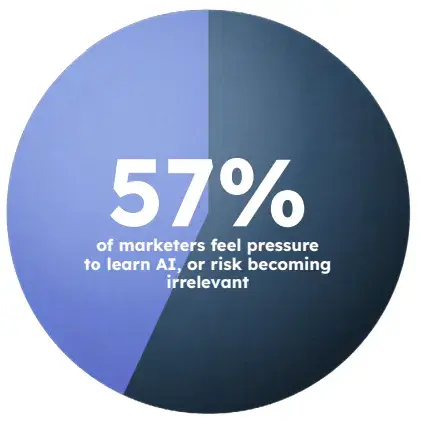
Happy customer service teams equal happy customers. AI is a great help to customer service. It helps them hand over the bits of the job they don’t like, leaving them to focus on what they do.
[Video: https://youtu.be/blcJtN2ZDeA?si=dDqneJLRZ-mLyFC-]
Start by integrating AI into existing tools.
I’ve written about this before, but I think it’s a really good tip: start integrating AI tools into existing tools. The data speaks for itself. HubSpot’s research shows that AI usage increases through existing tool integrations.
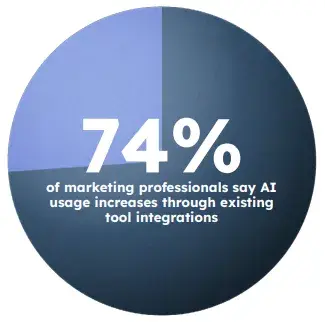
Marcus Clarke, Owner of Searchant, recommends starting with AI by “integrating an AI tool into your CRM that helps you collect and analyze data to identify behavioral patterns.
“Then, craft personalized outreach strategies that speak directly to the individual’s preferences. By making each customer feel uniquely valued, we’ve seen retention rates increase by 20% in six months, strengthening long-term loyalty.”
Use chatbots strategically.
Andrew Dunn, Vice President of Marketing at Zentro Internet, uses AI chatbots to provide 24/7 personalized support.
Dunn says this support has “significantly boosted customer satisfaction and loyalty.”
“Our chatbots learn from each interaction, continuously improving their ability to resolve issues quickly and accurately.”
When implementing chatbots, Dunn recommends that you “start small with a focused use-case, like handling basic troubleshooting queries, and gradually expand the bot’s capabilities based on customer feedback and data analysis.”
Understand your customers.
Dinesh Agarwal, CEO at RecurPost, has a great use case for AI and a good tip for getting started.
Agarwal explains the issue customers were facing and how they solved it. He says, “Our users were struggling with inconsistent engagement with their posts. We developed an AI-driven system that not only analyzes past performance but also adjusts posting times and content formats in real time. This personalization has significantly boosted user satisfaction and retention by ensuring their content consistently performs well.”
To implement this level of personalization, RecurPost’s team started by understanding their customers’ challenges so they knew what they had to resolve. Then, they could create a solution around the customers’ needs.
Agarwal says, “I suggest starting with a deep understanding of your customers‘ challenges. In our case, we identified the gap between user expectations and results. Once you have that insight, employ AI not just as a blanket solution but as a tool that can continuously learn and optimize, specific to each user’s needs. This approach has allowed us to create a more loyal customer base, as they see tangible improvements directly tied to our platform’s adaptability.”
Segment your audience for personalization.
When it comes to starting AI with emails and audience segmentation, I spoke to Josh Bluman, Co-Founder at Hoppy Copy.
Bluman is using AI to send personalized emails based on user activity. Hoppy Copy has used AI to send reminders about features, offers, and tips based on user usage patterns.
Blueman believes that “targeted touches make customers feel valued, which keeps them coming back.”
Bluman recommends that you “segment your audience based on behaviors or interests when implementing segmentation. From there, create personalized messages or offers that speak directly to each segment’s needs. It doesn’t have to be overly complicated at first — focus on small, meaningful interactions that show you understand your customers. Over time, these personalized touches build trust and loyalty.”
Focus on high-impact areas.
It makes sense to start with high-impact areas because any effort you put in will theoretically result in good output for your business and its customers.
Bri Como, Chief Operating Officer at Argon Agency, recommends you “see where customers often contact you and start with a chatbot for simple queries. Use AI for data-driven social and email ads customized to customer interests. Never lose the human touch — use AI to strengthen, not replace, relationships. With the right strategy, AI can boost loyalty and revenue.”
Start using AI for customer loyalty.
I hope this article was as inspiring for you as it was for me.
I was blown away by the positive uses of AI in customer loyalty. I feel like I got some impressive and genuinely valuable insights that balanced AI usage with that human touch. I can see how all the examples bring value to customers.
![]()
AI Ticketing: Your Not-So-Secret Weapon for Customer Service
When AI first started becoming more accessible, I have to admit, my first thought was not AI ticketing. I’d been working with DevOps and Product Development clients for several years, in part translating high-tech “sciency” words into language the average professional could understand, so I […]
ServiceWhen AI first started becoming more accessible, I have to admit, my first thought was not AI ticketing.
I’d been working with DevOps and Product Development clients for several years, in part translating high-tech “sciency” words into language the average professional could understand, so I already knew some potential applications of AI and machine learning.
But when I started to explore ticketing about a year ago to streamline traffic management for my projects and those of some of my clients, I realized the potential AI had to simplify the ticketing process. I started to get excited about the potential. (That’s a euphemism for “I totally nerded out.”)
Now, I‘m sharing what I’ve learned to help you implement AI ticketing and streamline some potentially cumbersome human-driven processes.
Table of Contents
- What is an AI Ticketing System?
- How to Create Your AI Ticketing System in 6 Steps
- How AI Ticketing Works
- 3 Top AI Ticketing Features
- AI Ticketing Apps
Done right, these ticketing systems work — 67% of support leaders are already seeing value from automation efforts, with 84% of reps agreeing that AI makes it easier to respond to tickets.
In this context, I’m specifically referring to customer service and marketing project management, but there are myriad use cases, including:
- Marketing organizations
- IT help desks
- Healthcare
- Travel
- Logistics
- ecommerce
Suffice it to say, if you handle any volume of requests or you’re forecasting a significant increase, an AI ticketing system is worth your while exploring.
How AI Ticketing Works
AI ticketing uses artificial intelligence and machine learning to simplify ticket management. Natural language processing (NLP) is now easily accessible, which makes AI ticketing increasingly user-friendly.
Depending on your needs and software, AI ticketing systems range from simple to incredibly complex. For example, my ClickUp-based ticketing system uses a simple form that triggers automations like ticket assignment, ticket priority and timing, and status update notifications.
On the other end of the spectrum, you might have an AI chat feature that uses NLP to assess customer intent and attempt to answer it, either with a specific answer (“Your shipment will arrive Tuesday. Here’s your tracking number.”) or by providing a helpful resource.
Regardless of what AI ticketing solution you choose, know that your customers are probably on board — 73% think AI will improve the quality of customer service.
Pros of AI Ticketing
There are countless reasons that AI ticketing represents the future of customer service. Some of the top benefits include:
Faster Customer Service
Often, AI ticketing allows customers to solve problems themselves, reducing wait times by freeing up customer service reps to handle more challenging issues. This is one of the driving forces behind adopting AI — 60% of leaders were most excited about faster responses.
Improved Productivity
Instead of waiting for a human to look at a ticket, evaluate it, and assign it to another human, AI speeds up the process, routing tickets to the right person in seconds. 78% of customer support reps are seeing increased efficiency.
Less Busywork
Gone are the days of repetitive tasks. You can automate just about anything that previously required manual workarounds. 80% of customer support specialists agree that saving time is a crucial benefit.

For example, since my ticketing system helped manage marketing and copywriting projects, nearly every ticket required creating a Google document. I used Zapier to connect ClickUp to Google Workspace and created and pre-populated my documents with creative brief information I previously had to copy and paste. This simple automation alone, which included a specific naming convention, saved me as much as 15 minutes per project, which really adds up.
Team Capacity Planning & Forecasting
As data rolls in, you’ll see how many tickets are self-resolved, patterns when tickets are more likely to come in, and the type or scope. From there, you can evaluate if your team is large enough or deep enough to handle the volume on any given day.
Scalability
A well-designed AI ticketing system can help position you to scale. So even if one person currently manages all of the tickets, or you currently only handle two at a time, by building a system that helps you categorize the different stages and task assignments, you can easily design it to grow with you.
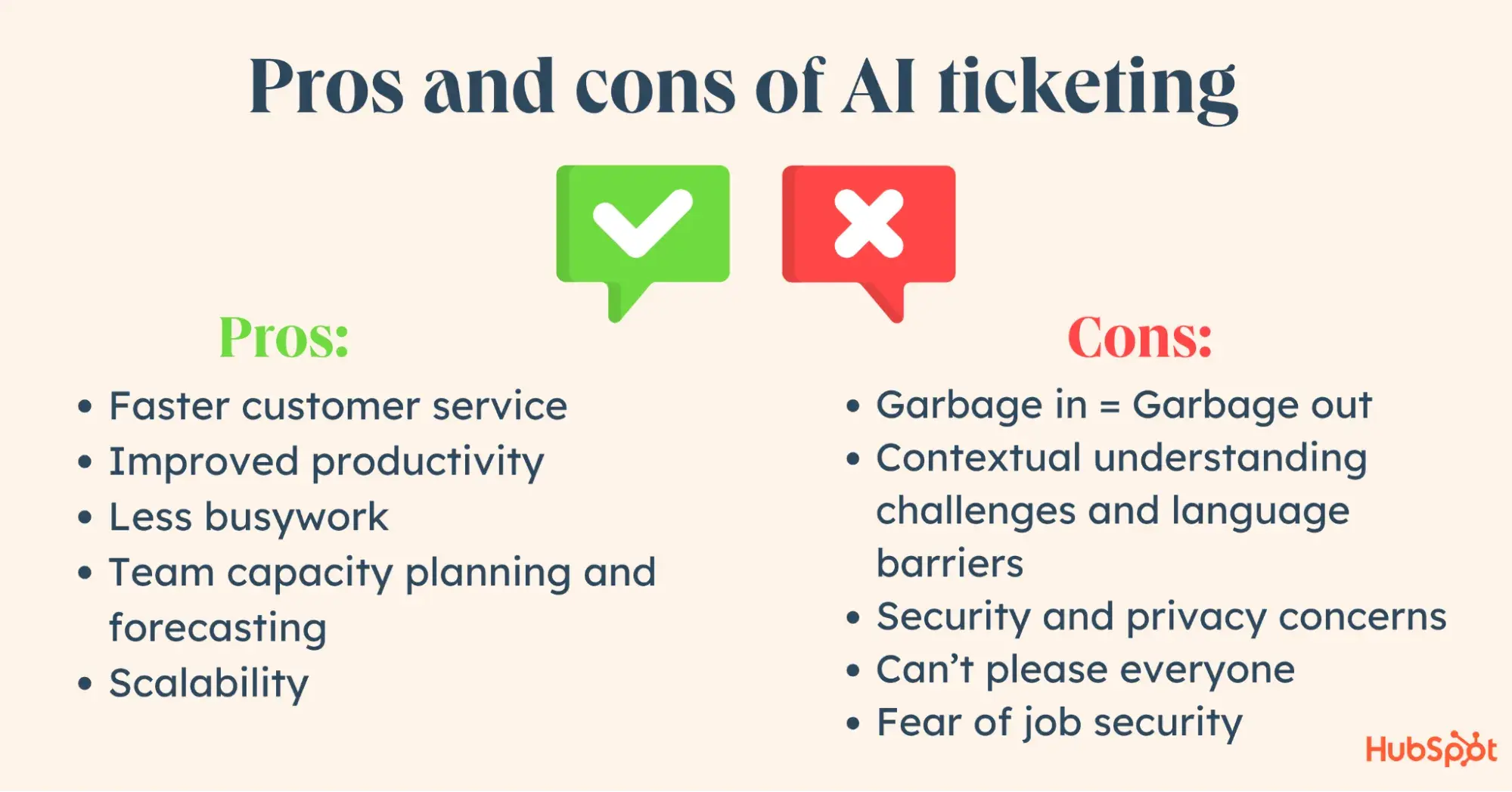
Cons of AI Ticketing
Nothing is perfect. And that means that AI ticketing has some downsides — over half of support teams are concerned about the negative effects. Most are figure-out-able, but they are definitely worth your consideration.
Garbage In = Garbage Out
Data quality is a genuine concern. Based on what I‘m reading, that’s not changing anytime soon. So, good data handling and cleaning processes will continue to grow in importance.
That’s just one concern related to data quality.
Air Canada implemented an NLP chatbot that offered a passenger a discount that didn‘t exist because it determined the offer was a reasonable response to the passenger’s request. When they didn‘t honor the discount, the passenger took them to court and held them accountable for the chatbot’s response.
The lesson here is to ensure your chatbot only draws on existing policies and offers your customers a link or point of reference. As a result, a few clients have decided that the risk those chatbots present is too great, and they’re going with predefined responses.
Contextual Understanding Challenges and Language Barriers
While this is the opposite of the Air Canada problem I mentioned, AI may struggle to understand the context or intent of the user. When people use colloquialisms or idiomatic language, AI may provide responses that don’t come anywhere near solving the problem, leading to frustration.
Security and Privacy Concerns
Any online system comes with the risk of a security breach, so having solid cybersecurity and data management policies in place is essential before using any AI. This risk grows based on the level of regulation your organization is subject to. For example, if you’re in finance or healthcare, there is a significant amount of sensitive data to protect.
Maintaining compliance here might require teaching your AI ticketing system how to recognize when users share sensitive information and reminding them not to share it.
Can’t Please Everyone
There will always be someone who is more frustrated due to working with AI ticketing than pleased. It’s the modern equivalent of jamming 0 on the phone and repeating with increasing levels of frustration: “Representative!” or “I want to talk to a human!”
A single bad experience can result in a lost customer.
However, if you can turn it around and offer exceptional customer service, 75% of people will do business with you again.
With that in mind, it’s a good idea to be aware of when some of those concerns might arise and take steps to head off any issues proactively. For example, you can program AI to route the issue to a representative after three failed attempts to solve a problem.
Fear of Job Security
Taking the pulse of the workforce, there‘s a lot of fear out there that AI is coming for people’s jobs, especially as generative AI becomes increasingly sophisticated. Those fears are normal and understandable whenever a portion of your job is marked obsolete.
But as people start to see the benefit of more time spent strategically and less on busywork, those fears are starting to turn around. Globally, 50% of workers now think AI will help them earn more.
If this is a problem you face, then it’s time for some education and transparency around how you see the role of AI in your customer service department.
3 Top AI Ticketing Features
We’ve covered the benefits and drawbacks of AI ticketing, but I haven’t yet touched on the features that are most important for AI ticketing.
Ticket Automation
Make sure your system can assign, categorize, and prioritize your tickets. This means getting super clear on the expected process and workflow so you can set the ground rules for your AI ticketing system to follow.
Ticket Tracking & Dashboards
Your AI ticketing system should help you — and, if applicable, your customers — stay on top of what‘s happening with tickets. To that end, you’ll also want at-a-glance dashboards that help you get a bird’s-eye view of everything.
Reporting and Analytics
Ultimately, AI ticketing should improve the experience for your team and your audience. So, you‘ll want to keep an eye on key metrics and how you’re performing.
There‘s no single best software solution out there, and there’s no one “right” way to create an automated ticketing system. Whether you use one of the apps I’m sharing below or create your own system like I did, there are two things to keep in mind:
- You can use as much or as little AI as you want.
- You can take things one step at a time, and as you uncover new optimizations, you can implement them one by one.
So, let’s dive into the “how” of building and implementing AI ticketing.
Step 1: Define your process, workflows, and the information you need.
Map out all aspects of your process, brain-dumping every step and touch point.
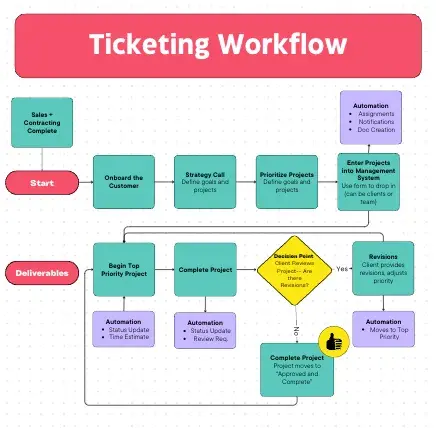
You may find data flow diagrams helpful for identifying your workflows and defining touch points. The example above shows how I defined the ticketing process and how to automate and handle client tickets.
During this phase, if you plan to use a form for ticket submission, identify all the data you’ll need for each stage. You can always adjust and adapt as you go, but having a baseline framework is important.
Even if you plan to use NLP to create your tickets, it’s a good idea to go through this process to help your AI ticketing system understand the criteria for decision-making.
Step 2: Identify automations and integrations.
In the diagram above, I shared some of the automations (in purple) I wanted to create, which also helped me identify the integrations I needed. Again, I used ClickUp, so some of the automations and integrations were native, others I had to connect via Zapier. My automations included:
- Ticket priority
- Ticket category
- Task assignment
- Document creation (bi-directional Zapier automation with Google docs)
- Stakeholder status updates (native integration with Gmail)
- Ticket reprioritization if changes needed
Depending on your workflows and use case, you‘ll have different automations and integrations than I did. So before you go all-in on a specific app, it’s a good idea to review their native integrations, explore what you can do with Zapier, and talk with their customer service team, perhaps even through their AI ticketing system.
Step 3: Templatize your communications.
It‘s almost guaranteed that you’ll have some communications that you either want your AI ticketing system to use as a template or that you’ll use after ticket creation outside of any AI interaction.
To ensure they communicate what you want in your brand voice, now’s the time to identify what you want to say and what fields you can use to populate the information.
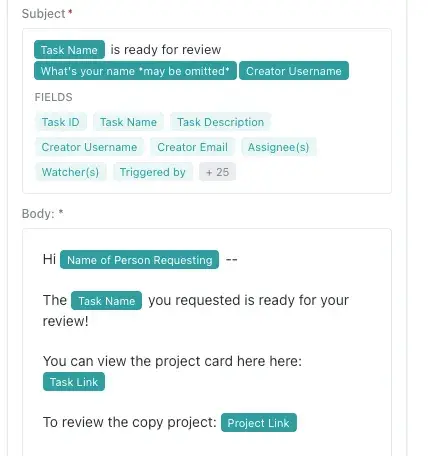
I’ve included a screenshot of one of my status update templates above. You can see how I used the fields from my ticketing system to ensure the update is accurate.
Step 4: Identify opportunities for future scaling.
How do you foresee your use of this system growing? While it’s downright impossible to forecast every potential future development, if you know your use will increase significantly, then accounting for that now will make your life easier down the road.
For example, I created an email marketing program for the digital marketing department of a large client with multiple audiences. This included creating an AI-powered ticketing system to track requests and help manage project oversight.
Even though the program was in its infancy and we were only handling a handful of campaigns a month, I knew the number would grow, so I identified the touchpoints that might require the support of additional resources. While currently, all aspects are assigned to a single person, we can easily update the automation as we grow.
Step 5: Create your dashboard.
Your AI ticketing app may come with dashboards that you can customize. However, if you’re creating your own, you have an opportunity to design dashboards that work for your needs.
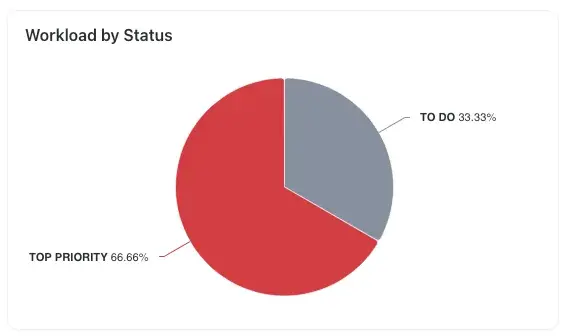
Step 6: Test & iterate.
Once you‘ve configured your AI ticketing system to meet your needs, it’s time to test and make sure it’s working the way you want it to. I encourage you to get as many testers as you can to help you handle any challenges and make updates along the way.
AI Ticketing Apps
Project Management Apps
I’ve mentioned ClickUp and Monday. Although these are not considered the leading AI ticketing systems, I was already using them for other workflows, so it made sense to get more out of apps everyone was already familiar with (and that was already a budgeted expense).
1. ClickUp
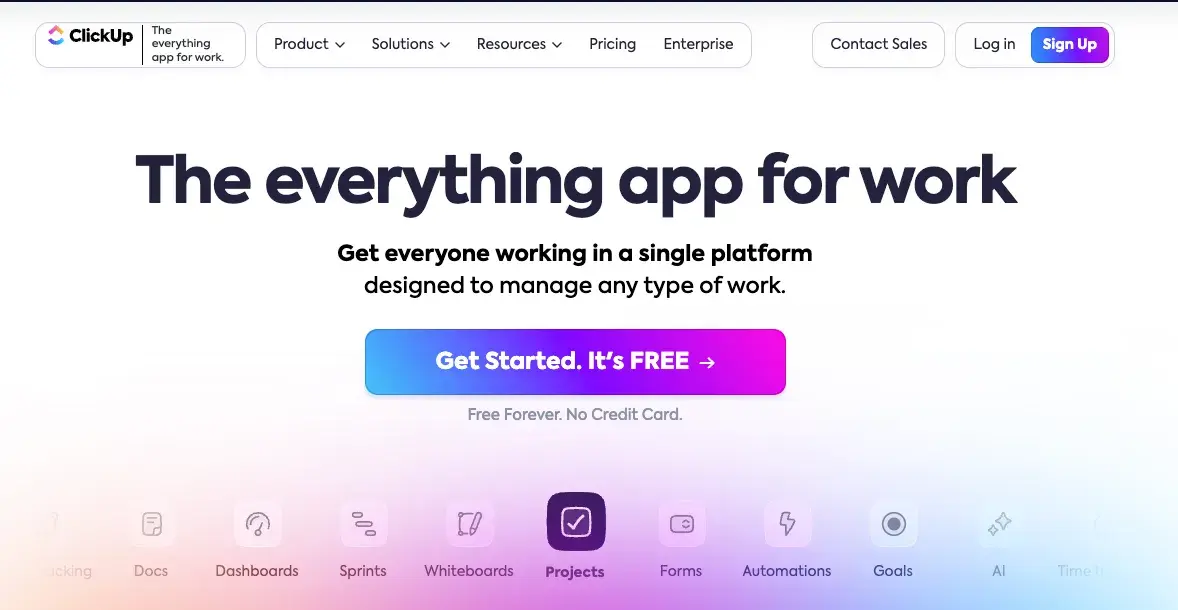
ClickUp is one of my favorite project management tools because it‘s so flexible. I found that creating dashboards, ticketing systems, and automations wasn’t particularly intuitive, but there are a ton of great resources out there. After watching a few YouTube videos from Layla at ProcessDriven, I was able to build my own system in a few hours.
While this may not be considered a full-scale AI-powered ticketing system, it does have significant AI-driven capabilities.
Pricing: ClickUp does have a free plan, but you need the $12/month business plan to get the automations and integrations and $7/month to get access to ClickUp AI.
2. Monday
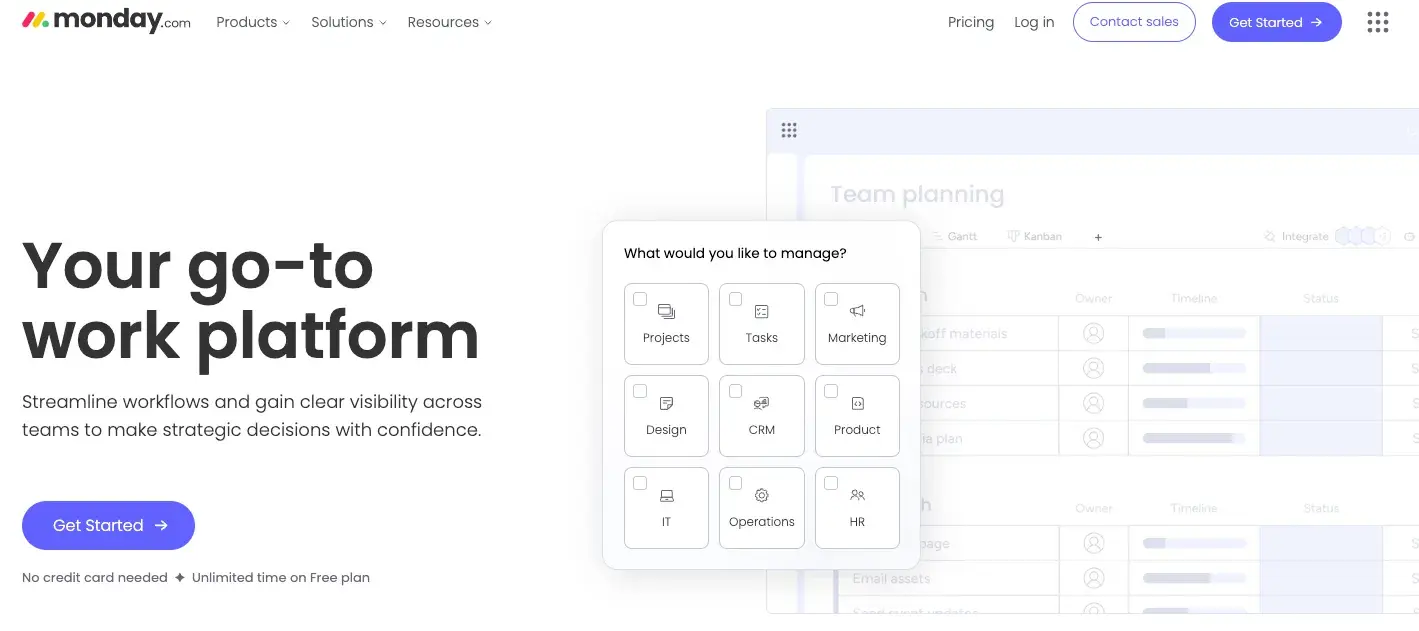
Monday is my next favorite when it comes to project management tools. I used Monday because my client was already using it, making it an ideal choice, but like ClickUp, I needed some outside support. Where did I turn for that support? ChatGPT.
Here’s the script I used to kick things off:
“I need to create a ticketing system on Monday to track email marketing campaign requests and management. I’m uploading a file that outlines all the fields and categories I need. Help me understand first, how to set this up in Monday, and second, how to automate notifications and the different steps.”
My pal GPT gave me options for structuring the Board and Workspace, and I went from there.
Pricing: Monday also has a free version, but you’ll need the $12/seat/month to get access to the automations and integrations.
AI-Driven Ticketing Apps
3. HubSpot Help Desk & Free Ticketing Software
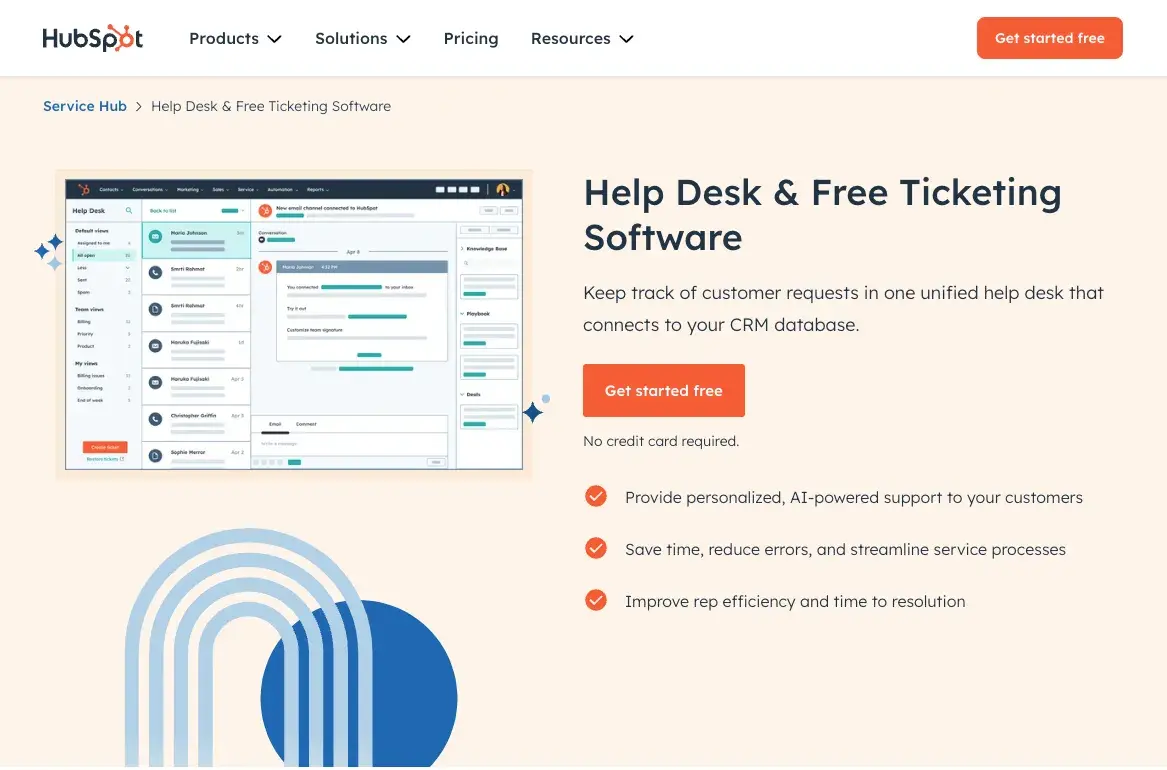
HubSpot offers help desk and ticketing software designed to help you scale customer support and satisfaction. If you‘re using HubSpot or plan to use HubSpot, it’s an ideal solution because it fully integrates with everything you’re already doing for sales, service, and marketing.
And when you couple it with HubSpot’s AI (Breeze), you can create a fully functional AI ticketing system.
Pricing: There’s a free version available. Once you scale to 5 users, you’ll need to pay $15/month/seat.
4. Worknet
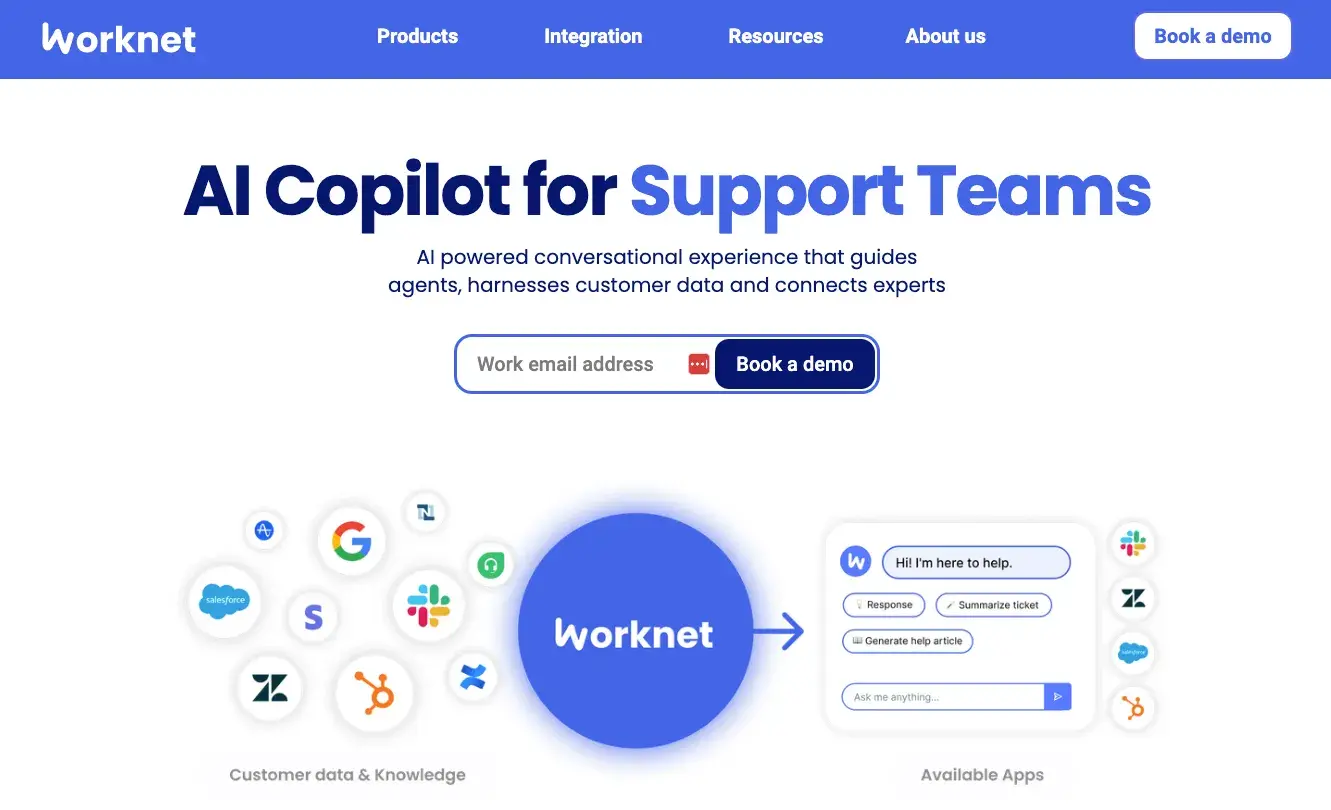
Worknet is a standalone AI customer service solution that allows you to create a ticketing system and turn responses into a customer knowledge base. With integrations with Intercom, Zendesk, and Salesforce, it can be a great way to take your customer service into the future.
Pricing: Unclear — hidden behind a demo.
5. Zendesk
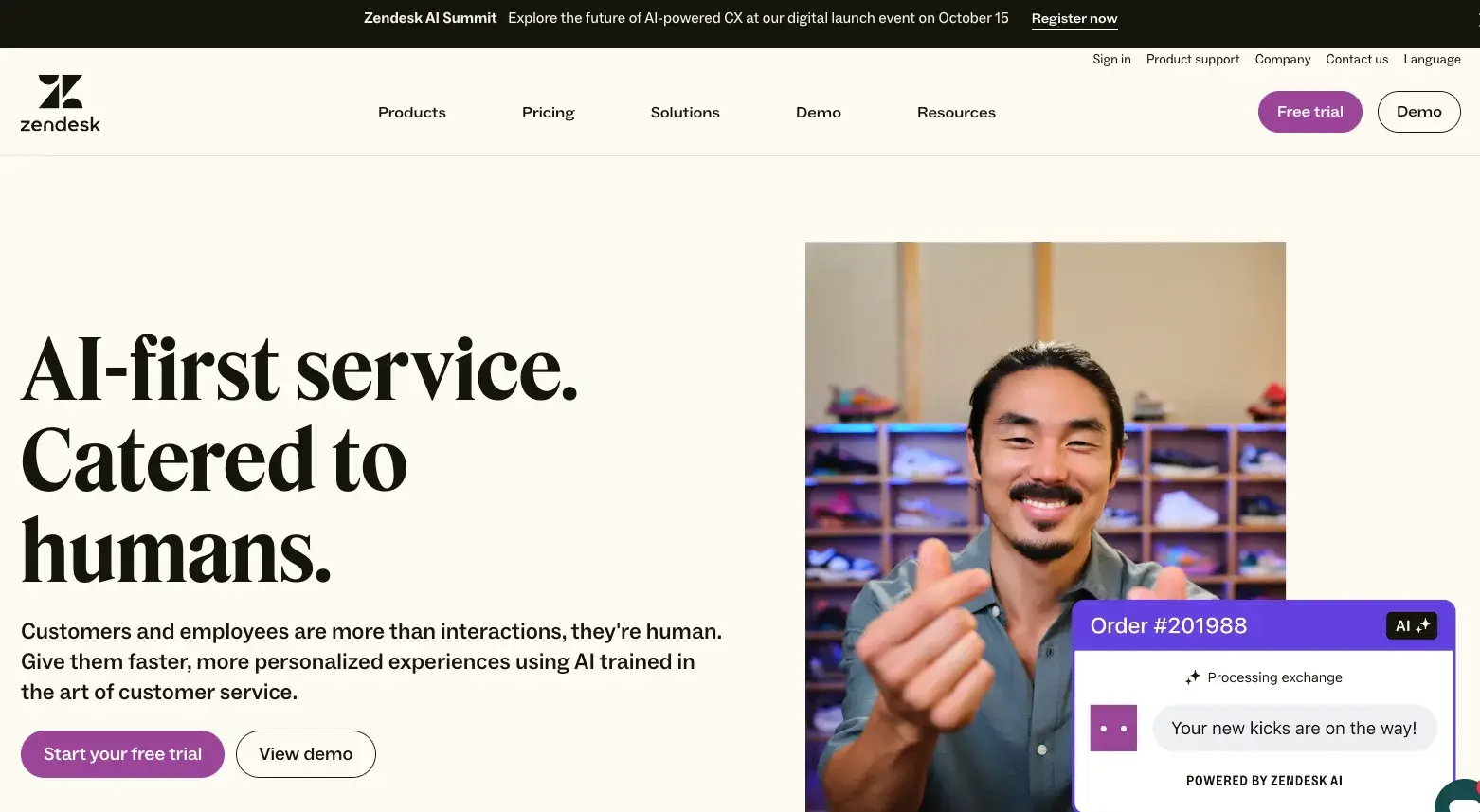
Zendesk has a strong reputation for helping companies develop customer service ticketing systems. What’s more, they have countless integrations, including with HubSpot, ClickUp, and Monday.
Pricing: Zendesk offers a free trial, and starts at $55/user/month. However, you can build your own plan for as low as $19/user/month
Your AI Ticketing System is Closer Than You Think
The bottom line is that AI-powered ticketing represents the future of customer service. While not everyone needs to adopt it at its highest level, if you don’t consider using automated ticketing systems to improve your productivity and customer service are sure to be left behind.
As consumers become increasingly sophisticated, I think it‘s fair to predict that they’ll expect answers at their fingertips in a way that will be difficult to provide with humans alone.
And the good news? Implementing an AI ticketing system no longer requires an advanced degree in computer science — with a host of options available, it’s easier than ever to start implementing your technology.
Best of all, AI is here to help. All of the platforms I’ve shared use AI support, and when you need more, you can always ask generative AI how to do it … or escalate your request to a human.
![]()












![→ Free Download: 61 Templates to Help You Put the Customer First [Download Now]](https://no-cache.hubspot.com/cta/default/53/a66c79d4-2a39-46e6-a80a-f7b999133c06.png)




![→ Access Now: 50 Customer Service Email Templates [Free Resource]](https://no-cache.hubspot.com/cta/default/53/9a8328ad-9a07-4f92-aa9c-468dc3a4a9d7.png)